



It’s





It’s
Tom Foster - Editor
What’s the most annoying thing anyone can do on a ride?
There must be lots of things, but riding along with a blinker on has to be at the top of the list.
I can be struggling to get through a tank-deep wallow of bulldust on the edge of a cliff and pursued by slathering death adders, and if the rider in front of me has left the blinker on since the last turn, that’s what I’ll be pissed off about.
Why is that, I wonder? Why is it that with all the potential dramas we face on a ride, it’s often really inconsequential things that make us burn?
For me it’s a real problem when I’m tired, and that’s something I’ve learned to look for in myself, because fatigue is a serious and insidious problem. Recognising symptoms of fatigue can be the difference between finishing a tough ride on the bike or in an ambulance, especially over long-distances.
Once fatigue has a hold there’s little can be done about it, and one of the really nasty facets of the whole thing is it feeds on itself. Because we’re a little worn we try harder. We try to maintain the concentration and force ourselves to stand up and muscle the bike a little more. That, of course, uses more physical and mental energy and the downward spiral to an incident becomes ever faster until, usually, something gives or fails. For an
adventure rider that mostly means we crash our brains out or end up in some hopelessly ill-judged situation.
Accepting and understanding the symptoms of fatigue is the best way of dealing with it, but it’s a very individual phenomenon. We all have our own different traits and we need to learn what they are. We especially need to learn the early symptoms, because that’s our
chance to manage the situation and make sensible decisions about whether we stop and rest or, if we elect to keep going, allow for our reactions and judgement to be less razor-sharp than we’re used to.

Getting annoyed at silly, inconsequential things is a fatigue telltale for me, and it’s a good one, because it shows up early.
“ Recognising symptoms of fatigue can be the difference between finishing a tough ride on the bike or in an ambulance. ”
It’s important adventure riders learn their own personal telltales, not just for fatigue, but for stress conditions like hypothermia and dehydration as well.
I’m a bit cranky a lot of the time, so I don’t always spot that early indicator. The secondary indicator is running the same thought through my mind over and over. On a long-distance ride this might seem a fairly natural thing to happen, but with me, it’s the equivalent of a red light on the bike’s instrument panel. My performance – such as it is –is compromised when I start that continual, repetitious thought. At that stage I need to consciously take some action to compensate for what’s happening or I’ll be taking a serious risk.
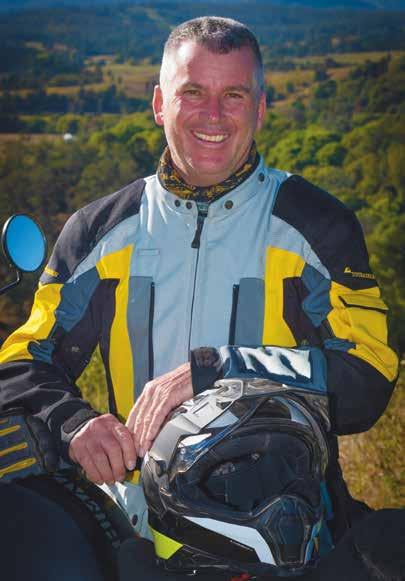
These things aren’t easy to learn. I reckon I’m a fairly crusty old leatherneck in terms of riding experience, and I’ve only learned to mark, and pay attention to, these phenomena comparatively recently. Of course, when I was younger it didn’t matter so much. Now it does. And it’s becoming more important all the time. I’m only offering this up for riders to think about. Maybe with some focused thought you can learn some indicators for your own mental and physical state and help prevent a catastrophic event. I hope so.
One thing I can promise: if you ride along in front of me with your blinker on, fatigued or not, if I can catch you, something drastic is likely to happen.





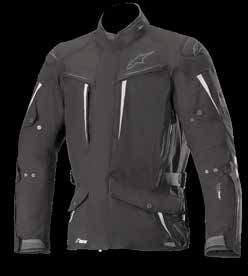
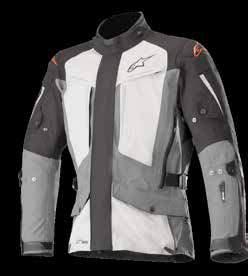
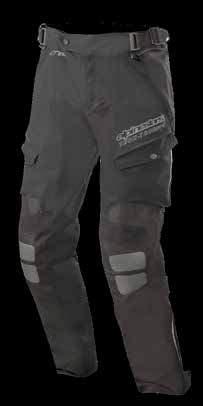








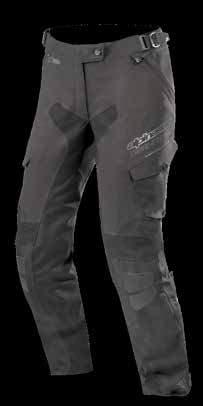
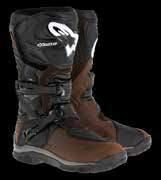




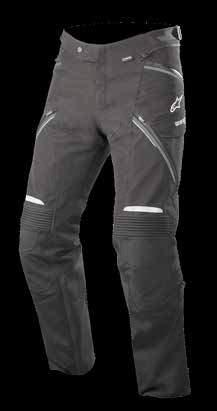



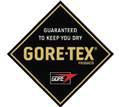
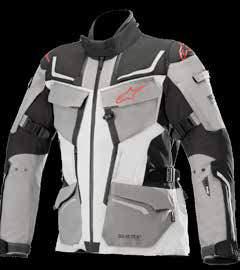
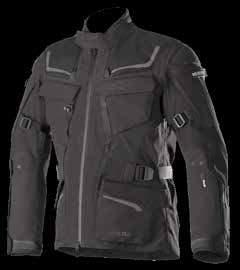


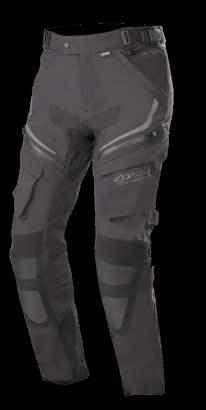



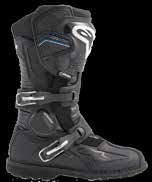







Publisher Kurt Quambusch
Editor Tom Foster
tom@maynemedia.com.au
Group Sales Manager
Mitch Newell
mitch@maynemedia.com.au
Phone: (02) 9452 4517
Mobile: 0402 202 870
Production Arianna Lucini
arianna@maynemedia.com.au
Design Danny Bourke
Subscriptions
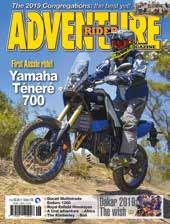

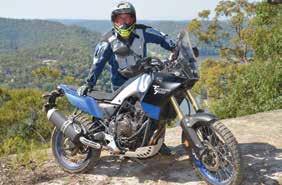

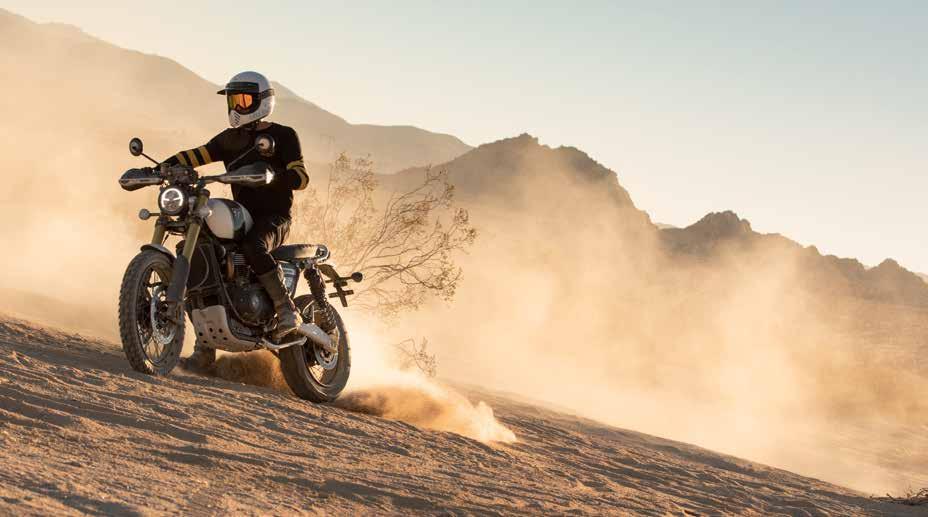



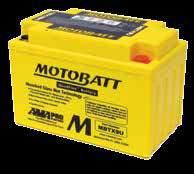




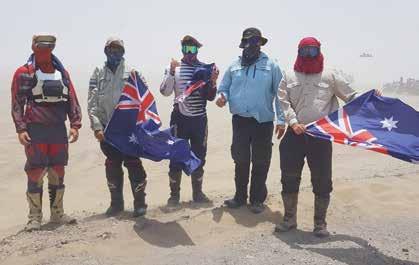
Dale Margetts followed the Dakar in 2015 and saw the start in 2018. This trip was bigger than both.
Some may remember me following Dakar a few years ago (See issue #16 – ed). With some good friends I set out to repeat the experience at the 2019 event.
Four of us flew out on Boxing day, 2018. Our fifth partner for the tour – ‘Baggs’, or Craig – arrived on January 4. With his reshaped prostate still on the mend he spent a lot of time standing up on his hired CRF450. He explained sitting was like the vibration of the three tuning forks in the Yamaha symbol right up to his tonsils. Plus, it worsened the claret he was still peeing (which none of us wanted to see).
We made our way to the Dakar start area with all the bikes, cars, SXS and trucks to catch up with Toby Price. He was at the Red Bull stand signing items with Sam Sunderland, Laia Sanz and Matthias Walkner. He was rapt we were wearing his T-shirt with the Dakar bike
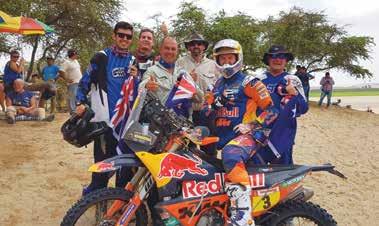
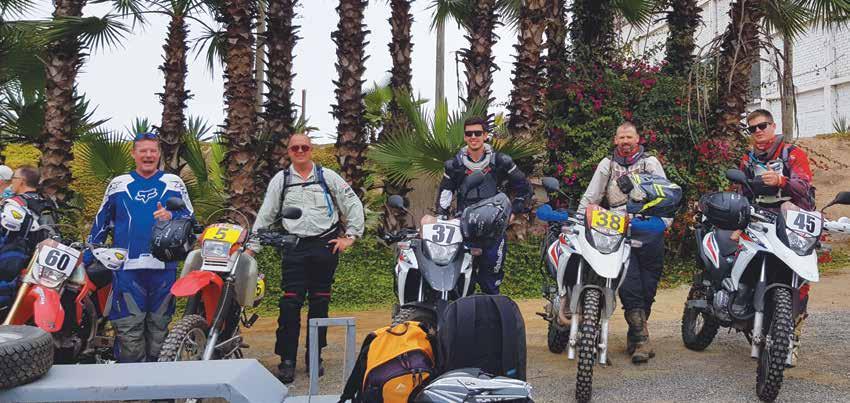
on the front, and we got a big, “Yeah, boys! They’re wearing my shirt!” as he pointed us out to the other Red Bull riders. We even featured on his Instagram. While we were at the Red Bull stand we were lucky enough to have our helmets signed by Dakar legends Stéphane Peterhansel, Cyril Despres and Carlos Sainz. At the start the Peruvians thought we were competitors and they put their kids in front and took so many photos it was unbelievable. It was just continuous. But the best was when Baggs was interviewed on how hard the race is. Maybe his rough exterior makes him look like a natural Dakar competitor.
Our tour was organised by Around The Block moto adventures. The company was helping an Aussie, James Ferguson. What a chilled bloke! No obstacle was going to stop James from finishing. At one transit stage he hit something on the road, came off and damaged his bike quite badly. To his credit he got it back to the bivouac and was able to rebuild it with some help from other Malle Moto riders and finish. It was great to be part of his journey. The first Dakar bike we saw was a couple of motels down from us and belonged to Richard Main, bike number 147. Richard was an English rider who we mistook for a mechanic. He was a gun, but his Dakar turned out to be painful. First he was hit by a truck and lucky not to be injured, but around the
“ The best was when Baggs was interviewed on how hard the
race
is.
Maybe his rough exterior makes him look like a natural Dakar competitor.”
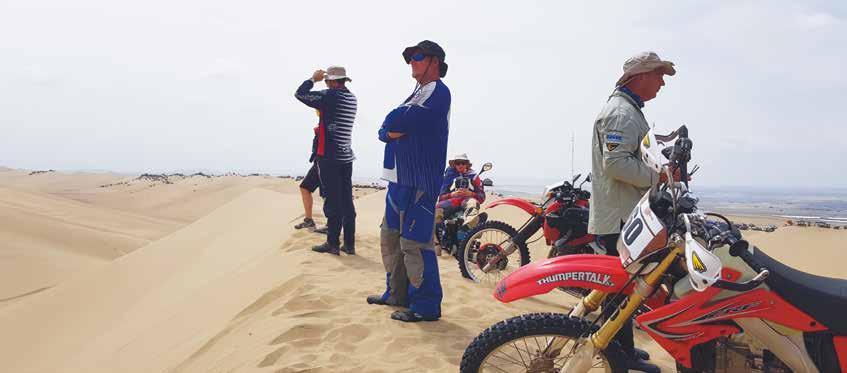




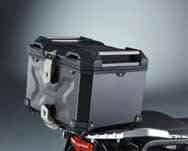

second-last stage he had a big crash, breaking his pelvis and spending eight weeks in hospital.
We also sighted the Commodore ute entered by Steve Riley and Trevor Hanks. The effort to get that ute to the start line was incredible. It was a shame to see Riley airlifted out with a back injury in the second week.
See sea rider
Our hire bikes were three Honda XRE300s, a CRF450 and an XR650. The 650 only lasted half a day, and that was just road riding from Lima to Parcuis. To the credit of the hire company they had another
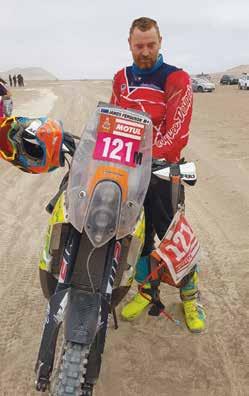
650 ready to go the next day. Riding the sand dunes was so much fun. Imagine looking at the highest building in a capital city, and that’s the height of a dune. The challenge was to get to the top of it.
Yeah!
I rode with Aleck and Jarrod on one continuous monster dune and could feel the grins under their helmets and see their eyes wide open.
Were we really doing this?
One lot of dunes was maybe 1.5km from the sea and we were riding on seashells. Heaps and heaps of seashells, and they were everywhere. We wondered how long since the sea had been there. Maybe 1000 years?
We caught up with Toby Price at the end of the second stage. What a sight: Sam Sunderland, Matthias Walkner, Adrien van Beveren and Toby Price all coming down from the top of one of the highest sand dunes and all just seconds apart.
After they’d checked in and their road books were removed, bagged and sealed (we weren’t sure why), Toby made his way
across to us for a chat, some photos and signatures on our helmets. Well…all of us got helmets signed except for Daz, but he managed to get his signed on another stage. Thanks TP!
Daz wasn’t leaving the Dakar without our Aussie hero’s signature, and it really made our day.
We saw Rodney Faggotter, but unfortunately his Yamaha had problems on the next stage and he was out of the Dakar and on a plane back to Australia before we could catch up with him.
We all really got the taste of riding big dunes and had grins from ear to ear. We still couldn’t believe we were doing it.
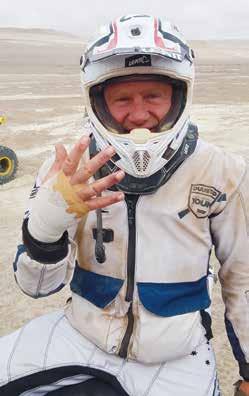



One morning we were on our bikes at 4.30am and there were Dakar bikes flying past us heading to the start. One rider gave us a fist pump as he passed. When we arrived at the start area Toby Price came up and asked if it was us on the highway because he’d seen an Aussie flag on a bag.
How observant is TP! It was a name tag with an address on one side and an Aussie flag on the other. The tag was about 70mm by 150mm and the bag was on the roof of a HiLux, flapping around in the wind.
It turned out to be the stage Ricky Brabec DNFed with a mechanical failure, and watching his bike brought back to the start hanging under the helicopter was an epic sight.
We also caught up with another Aussie rider, Ben Young.
Later on we noticed him on the side of the highway after dropping off his bike at the start. We were already in a taxi going
back to our motel, but we got the taxi to pull over so we could give him a lift. He’s a goer and a wealth of information, and he explained how to get into the bivouac.
It worked a treat! Then he got us beers at the riders’ tent in the bivouac, road maps and the golden pass to the podium party.
He also rode a lot of the Dakar with a fractured hand and still finished.
“ He also rode a lot of the Dakar with a fractured hand and still finished.”
Numerous times our tour guide put us in a prime position to watch the rally go by, but on one particular occasion a dust storm was so bad the only way we could see was to have our goggles on and we had to cover ourselves to stop getting sandblasted. This was also the day we decided to stay and watch every Aussie competitor go past.
Seven hours after Toby Price flew through we saw our only Aussie quad rider, John Maragozidis, and boy, did we give him a huge cheer.
When we caught up with John at the bivouac he couldn’t believe we’d been out there and he got a huge lift from seeing us. He did finish, but best of all
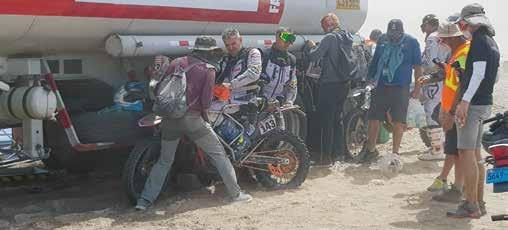

Convert OEM Tubeless Adventure wheels into tube type with Motoz Uber adventure tubes available in Offset and Straight Valve

> SIZES AVAILABLE:

Offset Valve: 18-150-170
Sizes Available:
18-150-170 OffSet Valve)
Offset Valve: 18-150-170
Straight Valve: 17-130-150
Straight Valve: 17-130-150
18-150-170 21-80-90
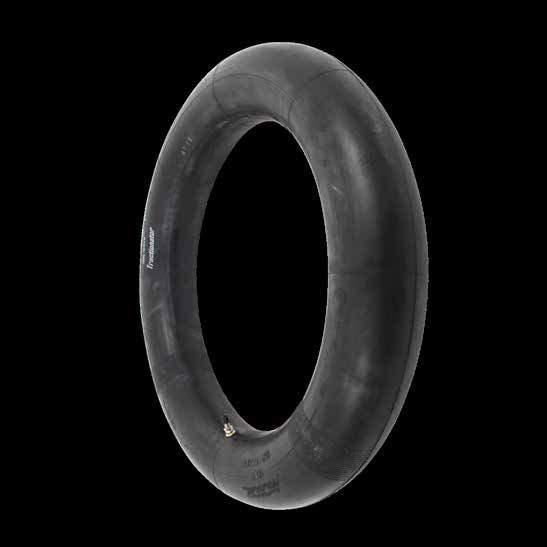

New Motoz Adventure Tubes specifically designed in “Uber” Ultra Heavy-Duty formulated from 4mm Natural rubber with an extreme wall thickness designed for the rigours of adventure riding.
> Unique to Motoz - Offset valve tube designed specifically for KTM OEM Adventure bikes.
> Rear tubes weighs just over 2.4kg making them nearly bullet-proof.
> All Motoz Tubes are made of 100% natural rubber.
Check out our channel to watch John Titman and Rob Turton fit a brand new Motoz 4mm Uber Ultra Heavy Duty Tube with Offset Valve
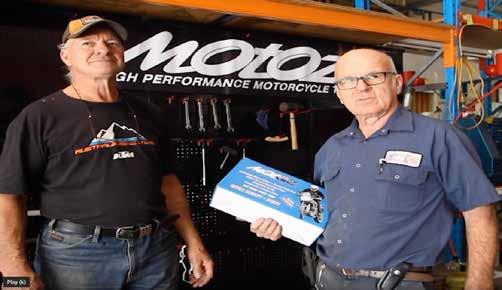


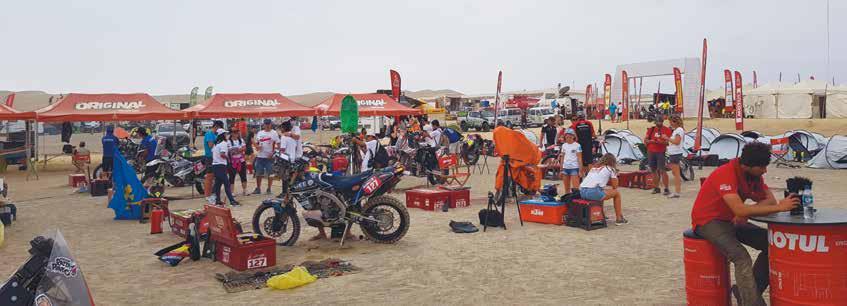
he gave us a bag of almonds from his farm in South Aussie.
We outlasted all the other nationalities on tour this day. Due to the dust storm they all went back to the motel except for an American, Joe Olson. He joined the tour on the second week and really liked our determination to stick it out. He did get a little soft and sat in the 4WD for a while to get out of the sandblasting, but he may have been still sore from being rear-ended by a taxi on the highway and going for a slide on the asphalt. The Peruvian mechanics straightened the subframe of his bike with a huge rock on the side of the highway.
Joe did enjoy our carry on and stayed with us for the rest of the race. He gave the five of us a free watch each from his company, Tree Hut (check out the website).
To a T
The pub we stayed at when we rode in Australia was the Crown Hotel in
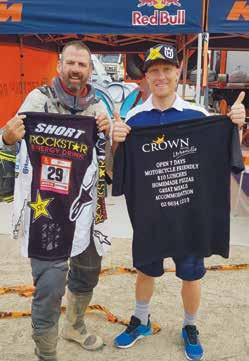
Urbenville, and we took some T-shirts across to get photos with them on around competitors. A competition started between us to swap them for something from a rider and I may have won.
This is what happened.
At the bivouac I was lucky enough to catch up with Andrew Short. While he was cleaning his helmet during the chat, I mentioned our competition. Andrew was great. He came back with the jersey he’d worn that day, signed it for me and posed for photos with him holding the shirts. But to my surprise he then said, “Man, I really don’t need your T-shirt. Take it back and see what else you can get.”
I thanked him and wished him well with the rest of the Dakar.
A few days later at the podium, after all the bikes had been presented with trophies and medals, we were drinking beer, eating food and watching all the competitors being presented with their trophies. We happened to be leaving
Top: The Malle Moto area.
Left: The author (left) was lucky enough to catch up with Andrew Short.
the podium party when the whole KTM and Husqvarna group was also leaving – I mean the whole team: mechanics, doctors, managers, riders and the big guns…but no TP. Jarrod had seen Sam Sunderland and we went over for a chat. I mentioned our T-shirt competition and to my surprise he said, “Okay. I’ve had a couple of drinks. Why not?’ He took off his jersey, put on the Crown Hotel shirt, signed his jersey and we had photos taken. But just as the photos were being taken a voice called out, “That’s my T-shirt.” It was Andrew Short with a big smile on his face It was the beginning of a big night.
Laia Sanz was there as well, and somehow we were able to have a joke and get photos with Sam, Matthias, Laia and Andrew. Laia then showed me the video of her shaving Toby’s head.
While this was happening a loud voice demanded, “What are you Aussie boys up too?” It turned out to be KTM raceteam boss Heinz Kinigadner. He went on to say, “Okay then, Aussie boys. Get in the bus. We’ll shout you all drinks and dinner with us.”
Below: Start of a stage with Toby. u

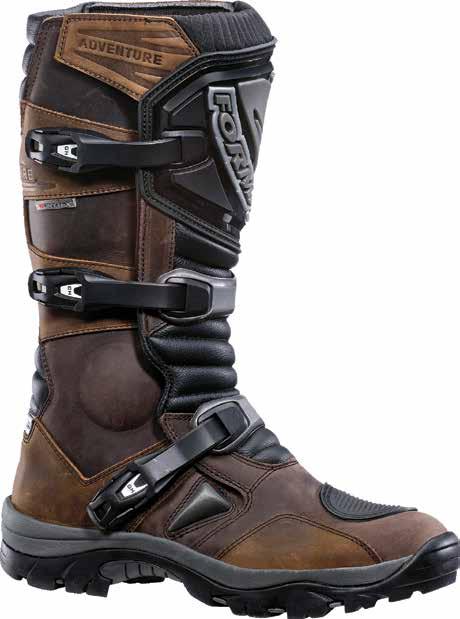


12 months Warranty CE® level protection
Full-grain oiled leather
Drytex® waterproof Lightweight construction
Adventure anti-slip sole
steel shank
Injection molded shin plate Plastic gear pad protection
Unbreakable GH® buckles
TPU reinforced ankle area Extra soft polymer padding
Anti-bacterial insole European production
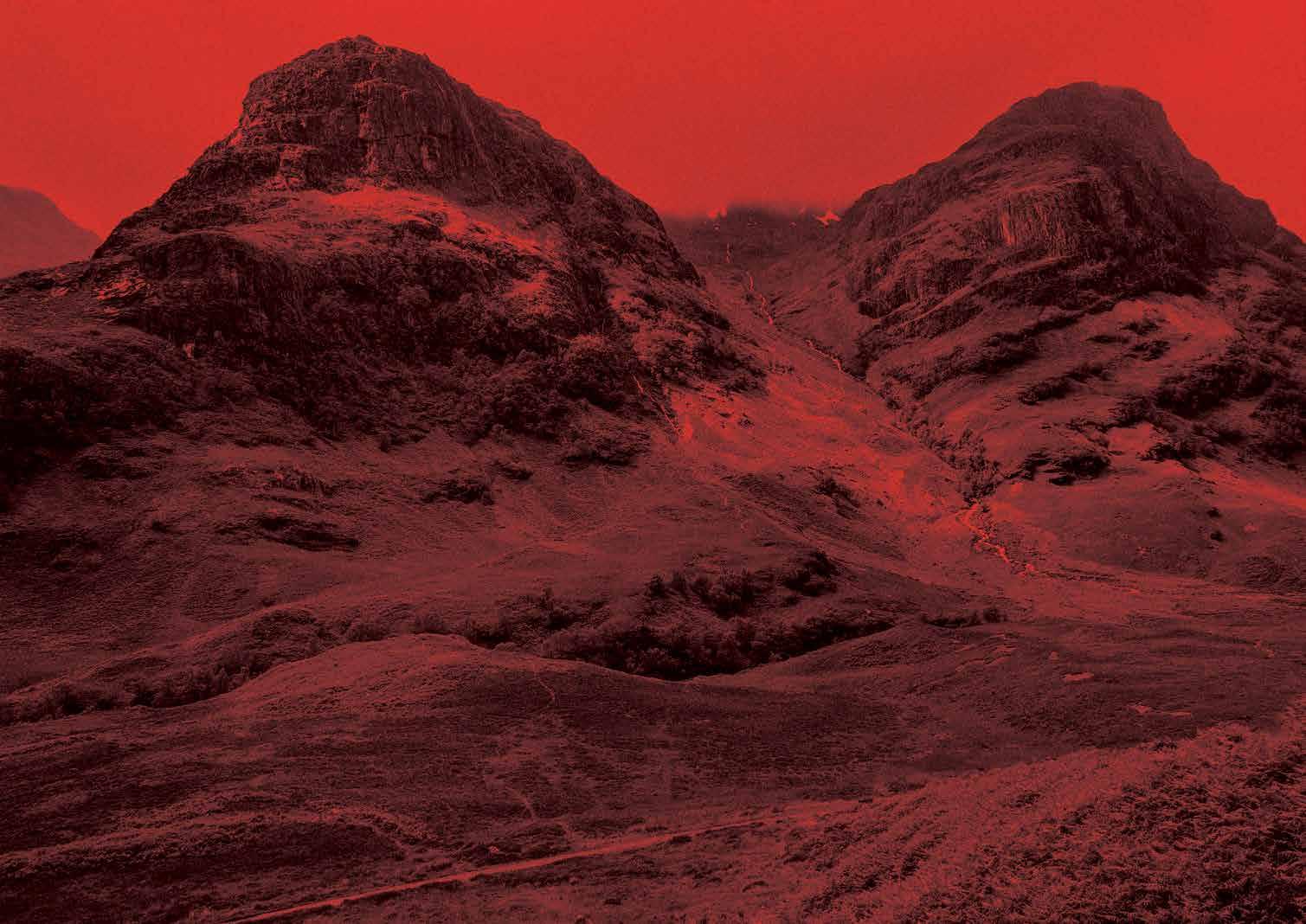

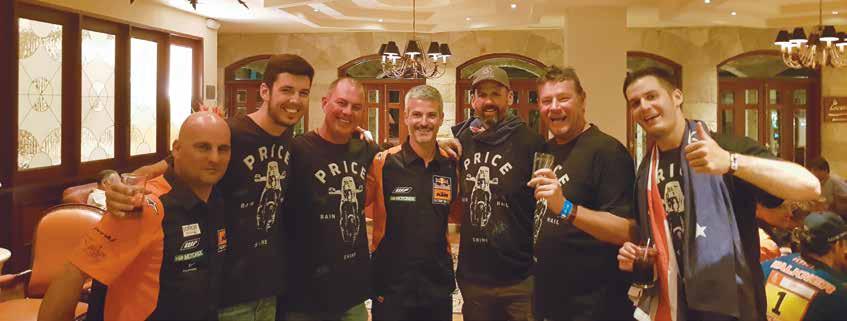
Daz was handed Laia’s trophy to hold and we just talked to everyone, finding out who they were. They were all so friendly and down-to-earth, just like Aussies.
At the bar in the hotel Matthias insisted on shouting Jarrod and Alec. Team manager Jordi Viladoms was relaxed and we were able to ask him many questions on the challenges of Dakar. I really believed he was glad to just stop, have a drink and have a chat with us, but we didn’t miss the opportunity in getting him to sign our TP shirts.
We mingled with the team until TP turned up and was rapt we were there sharing the occasion. We grabbed some photos with him and the Dakar trophy, then Jordi invited us to dinner across the road at a Michelin-star restaurant.
Talk about steak, wine and ‘wow’…
On our way to the restaurant Pablo Quintanilla rolled up in a wheelchair with his leg in plaster and we all gathered around him and wished him all the best with his recovery. That was at about 1.00am. It was great to see the camaraderie between Price and Quintanilla. TP signed PQ’s leg cast and PQ signed TP’s head, recently shaved by teammate Laia Sanz. The Toyota team was also there
“ So what did the person who’d just paid the bill for all of us say to the person who’d just won the Dakar for KTM?
“Let’s
have ice cream.” ”
celebrating its Dakar win. Driver Nasser Al-Attiyah came over to the KTM table to congratulate KTM on its victory and shook everybody’s hand, even us Aussie ring-ins. What a gentleman. Dinner was all paid for by someone at KTM and then we heard someone demand, “I would like some ice cream.” It was TP.
So what did the person who’d just paid the bill for all of us say to the person who’d just won the Dakar for KTM? “Let’s have ice cream for everybody!” Out came
Top: Team manager Jordi Viladoms was glad to just stop and have a drink and a chat.
Below left: Celebrating with the KTM team.
Below right: A huge spectacle.

Thanks TP.
We graciously thanked the people for a great night, the drinks and dinner. They replied, “You’re welcome. Now let’s go to the Red Bull party!”
We jumped into the taxis to the Red Bull party, but by then we were stuffed and it was time for bed.
There were some big challenges faced. Think about Bike number 143, Nicola Dutto, the first paraplegic rider, not on a quad, but on a two-wheeled bike. The Dakar association said he could enter as long as he had three support riders with him. They were doing so well until one of the support rider’s bikes broke down around stage six. Just think of all the logistics they had to work through! Go Nicola.
It was a huge trip, and on a very personal note I want to dedicate the story to Coral Wall, who we miss. Adventure riders love to share their stories, especially with family. Let’s encourage our loved ones to have breast and prostate checks done regularly so we can continue sharing with the most important people of all.





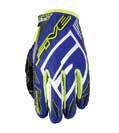

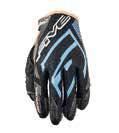



Yamaha’s newest Ténéré has finally landed in Australia.
Adventure Rider Magazine was lucky enough to enjoy a quick ride to answer some of the questions the entire adventure-riding community has been asking.

Yamaha’s latest configuration of its Ténéré range is built around a proven 689cc, liquid-cooled, parallel-twin CP2 motor. The powerplant’s claimed to offer ‘strong and linear torque output that gives instant throttle response together with outstanding acceleration’. A range of model-specific fuel-injection settings set the motor up to do its best in a dualsport application, and it sits in an all-new, lightweight, double-cradle, tubular-steel frame. Forks are 43mm upside-downers with 210mm of travel and both rebound and compression adjustment, and movement of the aluminium swingarm is controlled by a shock with an external preload adjuster. Wheels are a 21-inch front and an 18-inch rear fitted with Pirelli Scorpion Rally STRs.
The package results in 240mm of ground clearance and an 880mm seat height.
Thanks, YMA!
Adventure Rider Magazine was fortunate to be able to grab a very quick ride on the new Ténéré, thanks to Yamaha Motor Australia. It’s important readers remember this isn’t a full test – that’ll be in issue #39. This was a very pleasant day out with the new bike and some great people, and what you’ll read here are impressions without the checks and balances we often apply. Basically, we jumped on the new Ténéré 700, fanged around like mad things and ended up smiling all over our goofy faces. The bike is awesome fun to ride.
u Main: Strong and linear torque output gives good throttle response and strong acceleration.
Left: Adventure Rider Magazine was fortunate to get a short ride on the new Ténéré 700, thanks to Yamaha Motor Australia.

“ It feels almost vibration-free, and both power and torque delivery make it beautifully easy to manage.”
The single biggest trait of the new Ténéré to catch our attention was how frigging smooth the motor is.
Seriously. We’ve been riding plenty of twins lately, and this one is an absolute gem. It feels almost vibration-free, and both power and torque delivery make it beautifully easy to manage.
The spec sheet claims just over 70 horsepower from the standard motor, and we’re starting to think that’s about ideal in a bike this size. Husky’s 701 and KTM’s 690 are offering that kind of power output, and they’re sensational bikes.
But the Ténéré 700, of course, is built and offered as a genuine dualsporter, and the combination of the silky-smooth power delivery with a relatively slim, but very comfortable, cockpit mean the Ténéré 700 is a pleasure on the road, but still gives the impression of being a bit of a wild child on the dirt.
It’s not wild at all, but it does a great impression of it, and that made for an absolute hoot of a session with no injuries or stress.
The motor is a ‘good’n’.
Fit and feel
There wasn’t a lot of detail on suspension when we rode the bike, and we didn’t measure for ride height and static sag. Nor did we touch a clicker. Even so, we did manage to pound the bike through a few rocks and some unfriendly terrain. One thing we learned during that part of the day was the Ténéré 700 is an easy
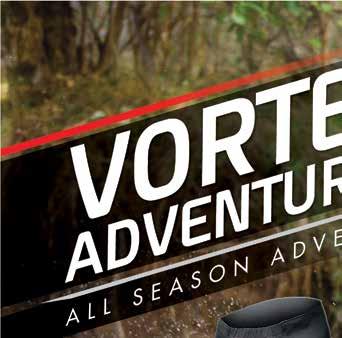


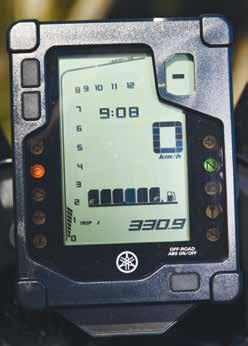
lift, even when it’s been dropped into an awkward position. At just a smidge over 200kg fully fuelled and ready to ride, its not a handful, even jammed into some tight going.
It’s not an enduro bike either though, and the rock steps and big, hard-edged stones had it clattering and clanking it’s way through some tough going. Once again, the motor being so easy to use, and the clutch being fairly light and very progressive, made the whole process manageable and fuss-free. We had a couple of different riders go for a larrup, and the comfort level was applauded by even those whose heights varied substantially. The seat/tank junction is a nice width and easy to grab with the knees but not fat like a park bench, and the screen kept the worst of the windblast at bay.
Instruments are a big deal these days, and the LCD display on the Ténéré 700 is a good one. It’s large and very easy to read, and of course, the bike not being overloaded with electronics means navigating through trip meters and so forth is a piece of cake.
Top: A flat, 880mm-high seat and slim seat/tank junction make moving around easy.
Top left: The proven 689cc parallel twin is almost vibration-free.
Left: The LCD display features gear position, fuel level, two trip meters, estimated fuel range, average and instant fuel consumption, and more. u


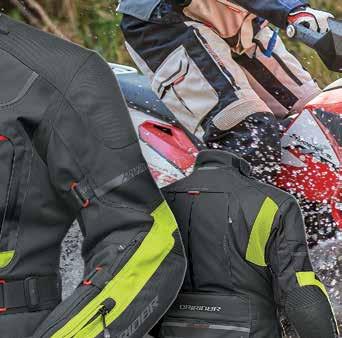
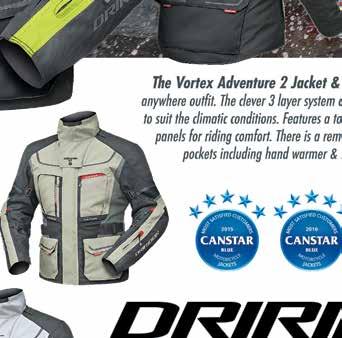






That’s a big, positive facet of this bike in our view: no electronics. Not even traction control.
The ABS was surprisingly good. We were expecting a budget-priced, single-channel set-up that would be virtually useless on anything except wet bitumen, but the factory settings allow some very aggressive braking, especially on the front. We heard ourselves telling others, ‘Just leave it on. It works great.’ That’s a relief, because user-adjustment is simple: it’s on or it’s off. There’s no in between, and there’s no selecting front-only.
Turning off the ABS is a simple push of a dedicated button on the instrument panel. No menu selections. No need to consult the manual. Just have the bike stationary, push the button until the light goes on or off, and away you go.
When the ABS is off a large line of copy on the instrument panel declares ‘OFF-ROAD’.
Job done
There’s a stack of great accessories – luggage, apparel and performance parts – available from Yamaha, and although this was only a short introduction, we reckon the Ténéré 700 is going to be an excellent adventure-riding proposition for Australian riders.
It’s important everyone remembers what the Ténéré brand is all about. It’s a dualsporter. It doesn’t offer insane horsepower, electronics to make Tesla weep with envy or drag-strip-type acceleration. It’s an honest, go anywhere, do-anything bike with decades of adventureriding pedigree.
From what we’ve seen so far, the Ténéré 700’s all of that.
And thanks to some wellbalanced engineering ideas it’s both comfortable and very rewarding to ride.
Anyone asked to give criteria for an adventure bike to suit Australian conditions would probably end up describing a bike just like this one. More next issue.
Above: No need for multifunction switches.
It’s all clean-cut and user-friendly.
Right: A distinctive looking headlight assembly. Four LED headlights protected by a clear nacelle and with two LED position lights at the base.

Recommended retail (including GST): $15,499 Web: www.yamaha-motor.com.au
Engine type: Two-cylinder, four-stroke, liquid-cooled, DOHC, four-valves
Displacement: 689cc
Bore x stroke: 80.0mm x 68.6mm
Compression ratio: 11.5:1
Maximum power: 54.0kW (72hp) @ 9000rpm
Maximum torque: 68.0Nm @ 6500rpm
Lubrication system: Wet sump
Clutch type: Wet, multiple disc
Fuel management: Fuel injection
Ignition system: TCI
Starter system: Electric
Transmission system: Constant mesh, six-speed
Final transmission: Chain
Frame: Double cradle steel tube chassis
Front suspension system: Upside-down telescopic fork
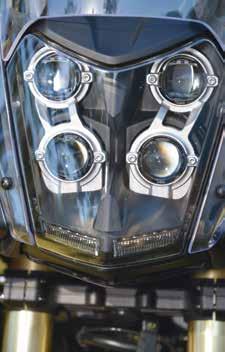
Front travel: 210mm
Rear suspension system: Swingarm (link suspension)
Rear travel: 200mm
Front brake: Hydraulic dual discs, Two Ø282mm
Rear brake: Hydraulic single disc Ø245mm disc
Brake system: Switchable ABS
Front tyre: 90/90 R21 M/C 54V M+S – spoked wheel
with Pirelli Scorpion Rally STR
Rear tyre: 150/70 R18 M/C 70V M+S – spoked wheel
with Pirelli Scorpion Rally STR
Overall length: 2365mm
Overall width: 915mm
Overall height: 1455mm
Seat height: 880mm
Wheelbase: 1590mm
Minimum ground clearance: 240mm
Wet weight (including full oil and fuel tank): 204kg
Fuel capacity: 16 litres
Colours: Ceramic ice, Competition white, Tech black
Warranty: 24 months, unlimited kilometres, parts and service





The first steps down the ramp onto African soil are always filled with anticipation and excitement, but Compass Expeditions’ Mick McDonald knew what he was in for. It was his third Charley Boorman ride from Cape Town to Victoria Falls.
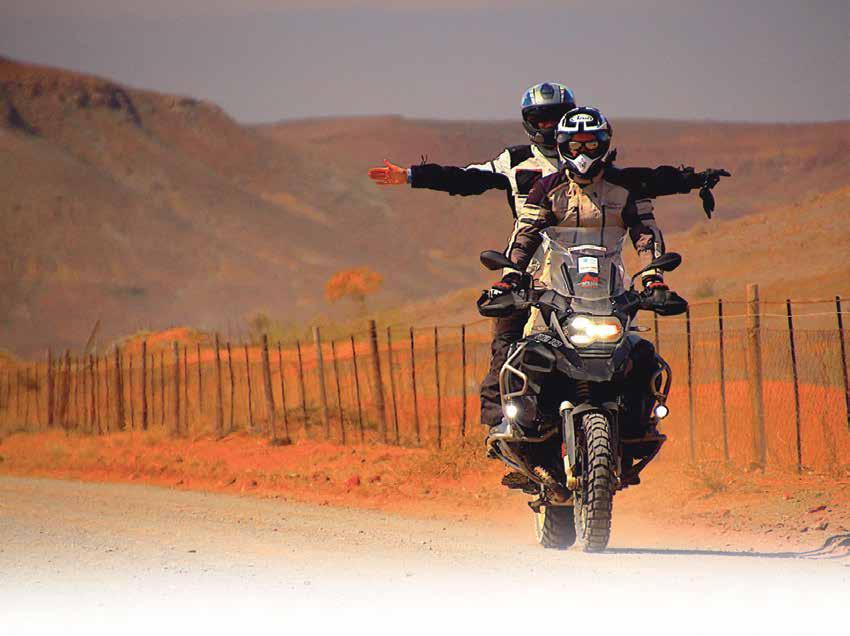
Finally, after too many hours on a plane, we touched down in Cape Town, South Africa. Unfortunately, Charley could only be there in spirit. He was riding out of Argentina with his mate Ewan McGregor for the new Long Way Up series. They were on electric Harleys in South America while we rode out of Cape Town on brand new BMWs: R1250GS, F850GS and a couple of R1200GSAs.
The rising sun turned Table Mountain an impressive

golden hue as we left Cape Town, heading for the westernmost point on the African continent, Cape of Good Hope, by late morning.
After a night at the luxurious Franschhoek Hotel & Spa we soon hit the dirt tracks in the remarkable Cederberg Wilderness Area. We crossed into the North Cape, a region similar in size to Germany, with some amazing back-country riding through remote stations.
Once into stunning Namibia we marvelled at Fish River Canyon, the second-biggest canyon on Earth, before spending a wonderful night in a remote desert lodge having a few beers under a vast carpet of stars as a gentle warm breeze blew in.
The silence was breathtaking. It was truly a special night to remember.
On to Burgsdorf goat farm we went and enjoyed amazing Namibian farm hospitality. It was certainly some of the most wonderful ‘real’ country food of the entire journey.
A working farm, Burgsdorf offers an insight to the hard life of Namibian farmers, but also shows
Top: Backcountry Namibia.
Left: Saying hello to the locals. u
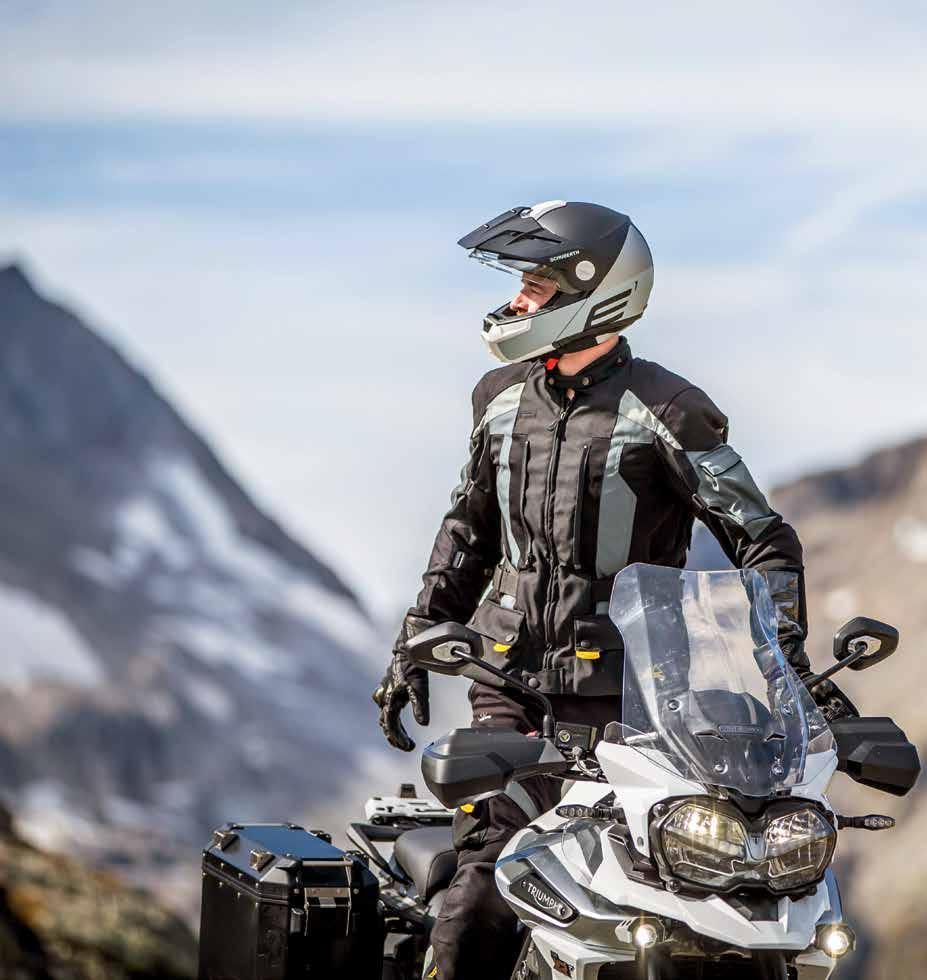
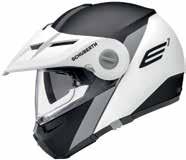



how they manage to survive in such a tough environment.
We saw the week out at one of Namibia’s most iconic locations: the Namib-Naukluft National Park. Towering sand dunes turned a wondered red at sunset, made even more special by our five-star tented resort inside the national park itself. It certainly doesn’t get any better than having a beer on the edge of the desert watching oryx pass by as the sun sets over the dunes It was wonderful stuff.
We dragged ourselves away from the stunning Dead Valley Resort, scoffed home-made apple pies at Solitaire, crossed the Tropic of Capricorn and reached the wild Atlantic coast by midafternoon. That allowed time to explore ‘The Big Smoke’ again after so many
nights of utter isolation.
Riding further north meant traversing the many gravel roads that criss-cross Namibia, stopping to chat to the wonderful Himba and Herero women who eke out an existence selling handicrafts to passing tourists in an incredibly harsh environment. We’d met the women the previous year, and when we saw their plight we asked what they most needed. On this year’s visit we were able to help out with a load of clothes and blankets.
A magnificent day finished at the incredible Vingerklip, a landscape very reminiscent of Monument Valley in the US. We clambered up a sheer, 200-metre rock face via a series of stairs and watched a magnificent sunset. Dinner at a restaurant stunningly located at the very top of the escarpment was

incredible. We inhaled Africa and tried to take it all in, while the three-quarter moon illuminated the surrounding landscape and added to the experience.
The world-renowned Etosha National Park was next on the ride, with a day off to enjoy the quintessential African experience: a safari.
Above: The remarkable Cederberg Wilderness Area. Bottom left: Who’s horny? Below: Fish River Canyon, the second-biggest canyon on Earth. u


Avoid simply travelling. Exceed your boundaries with the Multistrada 1260 Enduro, the new Travel Enduro from Ducati. Thrilling performance is guaranteed thanks to the substantial torque supplied by the 1262 cc Testastretta DVT engine, always at the ready. Redesigned ergonomics ensure comfort and control in all conditions. A high-res dashboard with new graphic interface allows you to make simple and intuitive use of the numerous adjustment options, for a configuration to best suit your needs.
No destination will seem far enough on board the new Multistrada 1260 Enduro. Let yourself go beyond your boundaries.
Avoid simply travelling. Exceed your boundaries with the Multistrada 1260 Enduro, the new Travel Enduro from Ducati. Thrilling performance is guaranteed thanks to the substantial torque supplied by the 1262 cc Testastretta DVT engine, always at the ready. Redesigned ergonomics ensure comfort and control in all conditions. A high-res dashboard with new graphic interface allows you to make simple and intuitive use of the numerous adjustment options, for a configuration to best suit your needs.
No destination will seem far enough on board the new Multistrada 1260 Enduro. Let yourself go beyond your boundaries.
Elephant, black rhino, giraffe, and endless antelope filled our day before the breathtaking Lianshulu Game Lodge, located inside the Mudumu National Park itself, had us watching another amazing sunset. A herd of elephant drinking from the river was perfectly silhouetted. It was absolutely stunning and surely must be one of life’s great experiences.
Crossing into Botswana we visited the legendary Chobe National Park where we enjoyed another sundowners’ cruise aboard a private boat, allowing us to get incredibly close to elephants, crocodiles, hippos and water buffaloes. Before we knew it, we’d crossed into Zimbabwe and arrived at our final destination, Victoria Falls.
We stayed at one of the world’s most iconic accommodation establishments, The Victoria Falls Hotel, and walking its hallways was like walking through the storybook of history.
A more fitting final destination would be hard to find.
We enjoyed the very best of Africa, an alluring continent that gets under the skin, and the only guarantee was the desire to return again and again. Charley Boorman will be back leading tours in September 2020. If you’re keen to know more, email info@compassexpeditions.com
Right: A herd of elephant drinking from the river was perfectly silhouetted. Below: The rising sun turned Table Mountain an impressive golden hue.






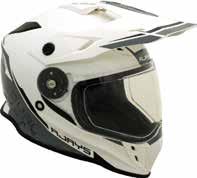





Sharper than the Multistrada Enduro 1200? We have to say the Multistrada Enduro 1260 is not only sharper, it’s even more fun to ride.


Above: Lots of familiar visual cues, but a little lower and with a slightly softer front end. We felt the changes made it easier to ride, especially to ride hard.
Adventure Rider Magazine loved Ducati’s Multistrada Enduro 1200. We raved about it, and with good reason. Aside from it being heavy to heave upright in a sand dune, it was a knockout joy to ride in almost every situation. It destroyed long distances, it powered past unsuspecting sports bikes on technical roads (we loved that bit) and it handled some surprisingly tough terrain. But now the Enduro 1200 has faded into the past.
Now there’s the Enduro 1260, and we’re shaking our heads in disbelief, but we think it offers even more sparkling performance than the Enduro 1200.
We’re going to call this bike ‘the 1260’. Ducati has quite a few Multistrada 1260 models, and in this review, when we say ‘the 1260’ we’ll be referring solely to the Multistrada Enduro 1260, okay? We’re not going to write the whole model name every time. The 1260 features a new 1262cc, 90-degree, liquid-cooled, V-twin donk with variable valve timing. Power output is a ’nad-pumping 155hp and there’s a grunt-monster 128Nm of torque. Those figures are no surprise to fans of
changeable on the fly of course, and aside from the ease of getting the feet on the ground, it’d be easy to think there wasn’t a lot different from the 1200.
But where our regular 175cm rider was immediately comfortable on the 1260, our 195cm rider felt cramped and uncomfortable where he’d been relatively happy on the 1200. Of course, there’s a taller seat available that may well have suited him, but we didn’t have it with us during the test ride.
Another noticeable change is the 12.5cm TFT display.
We struggled a little with the menu on the 1200. There were so many possible settings it was bloody hard to know where to go to end up with what we wanted. It probably took us most of a year to settle in to what was on offer and work out how to select it. Once we’d learned that, though, having the bike in the right mode with the right settings meant stellar performance, so it was worth getting right.
Ducati’s big Multis, but it felt as though the power was more manageable in the 1260 than we’d seen in previous Multistrada Enduros. That may be a false impression brought on by the bike’s excellent handling, because a lower seat, lower footpegs and 15mm less ground clearance combine with new geometry to
“ A couple of times we went looking for a clean-jocks setting, but even Ducati hasn’t made that advance yet. ”
have a very noticeable effect on the bike’s stability. Electronic ‘Skyhook Suspension EVO’ plays its part as well of course, and the result is Schwarzenegger muscle with a ballerina touch.
The same, but different Ducati fans will feel right at home on the 1260. The shape of the seat, ’bars, tank and all the bits and pieces around the bike are very similar to the 1200 Enduro. There’s the same four riding modes,
The 1260 has the same incredible range of rider-adjustable parameters, but the presentation on the screen itself is now a lot easier to understand. Graphics show which component is being adjusted – so a pic of, for instance, a motor or suspension – and highlights show which facet of the component is being changed. Then, instead of numbers which were open to interpretation – is ‘1’ the most or the least? – the selections come up with words describing the choice.
Even better for day-to-day riding, the screen in its ‘normal’ function shows a great deal of really useful information in a very compact, but clearly visible, display. Once the rider selects the mode and variations, the display shows things like the traction control, ABS and wheely control in the bottom-right corner. We were surprised at how often we found ourselves checking those settings, usually after we’d pulled off an amazing powerslide or carved up some poor unsuspecting sod on a crotch rocket on the bitumen, just to see whether it was us or the bike that’d done that spectacular manoeuvre (it was always the bike).
A couple of times we went looking for a clean-jocks setting, but even Ducati hasn’t made that advance yet.
Incredible
There’s obviously a wealth of regular information on the TFT screen. Things
u
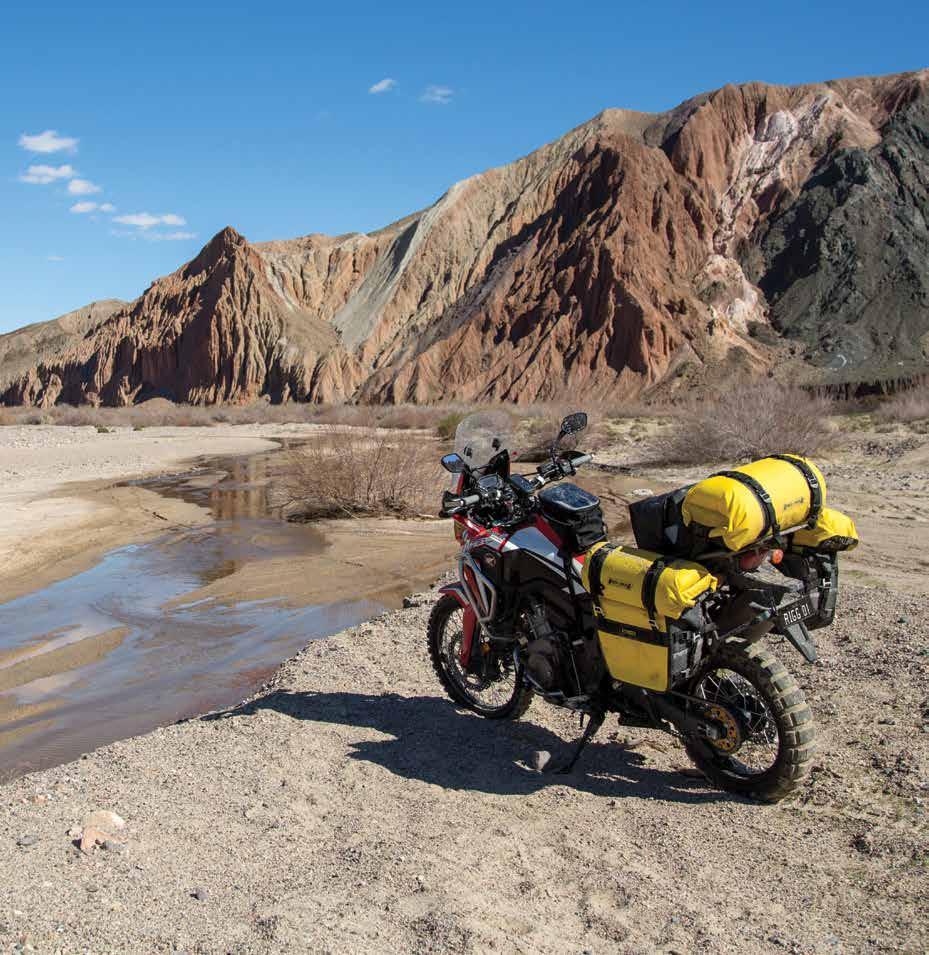







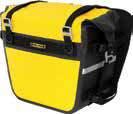






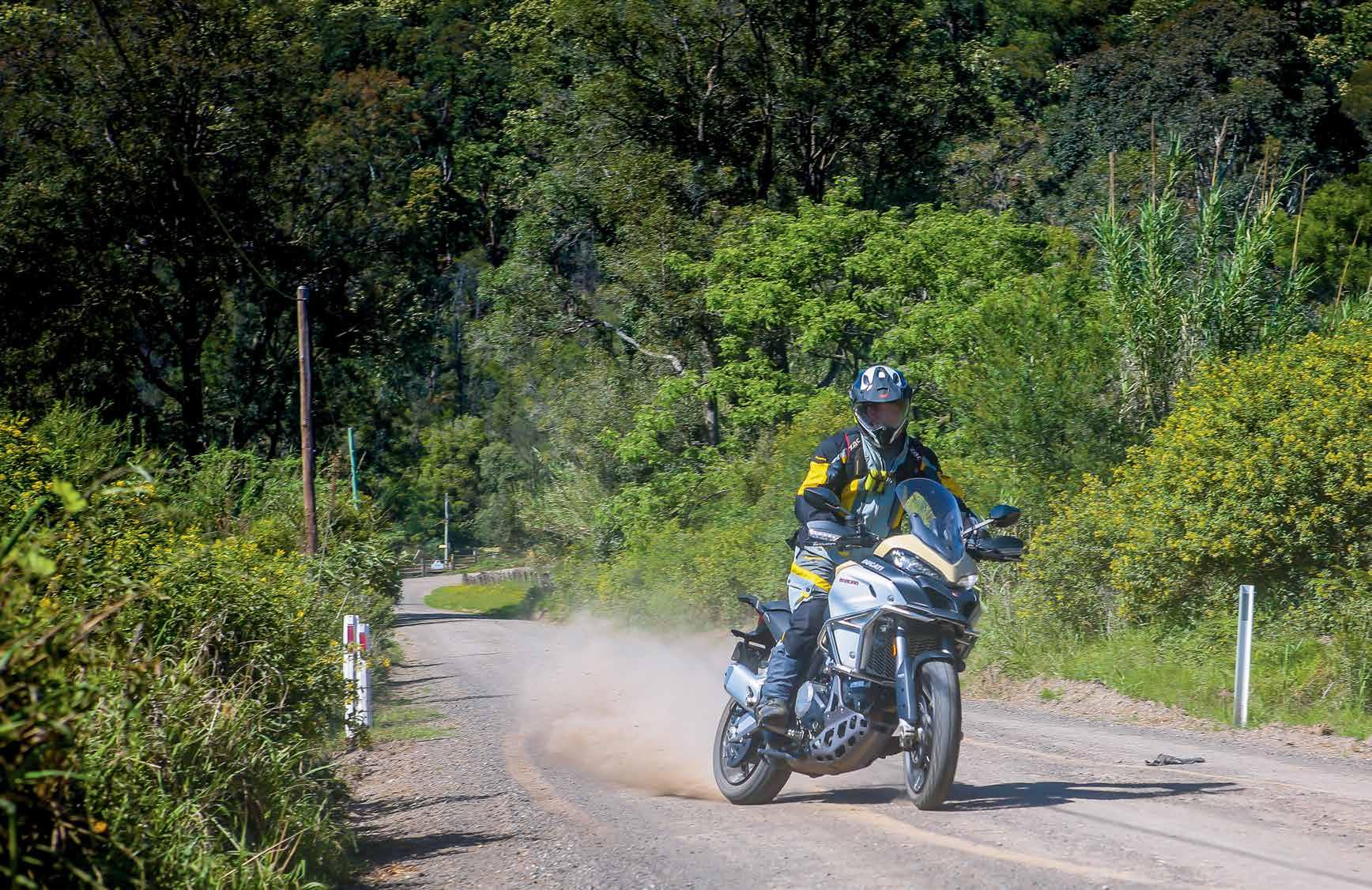
like fuel, speed, tacho, trip meters, odometer, gear choice and the ‘usual’ readouts are all there.
The switches are backlit too, by the way, and we liked that a lot. It makes them really easy to see and use, day or night.
Braking?
We don’t know what to tell you. In our opinion both front and rear are superb, but performance will depend to some degree on selecting the right mode for the current terrain. We fooled around with Sport mode on the dirt just to see what would happen and there was all kinds of techno wrist slapping going on. Traction control went apeshit any time we tried to accelerate and the ABS went mental if we tried to stop. But flicking over to Enduro mode had the bike running at ICBM velocities and braking like a labor politician who’s seen a union secretary at a media conference.
It’s truly amazing how the electronics on the 1260 lifts the ability of a very average rider.
And as we said earlier, it seemed to us the stability and handling of the 1260 has taken a big step forward from the same characteristics as we remembered them on the 1200 Enduro.
It’s been a while since we rode the 1200 Enduro, but the impression is very strong. The 1260 just seems a lot more stable, to the point where we were encouraged to do some mildly crazy stuff. Once we started doing crazy stuff, and the bike made us feel good about it, there was no going back. The more we rode the 1260, the more we loved it. The power in Enduro mode came on in a controlled rush, braking was strong and the ABS still saved us a few times. For covering distance, the low-down torque and cruise control made for wonderfully relaxed sightseeing.
In Sport on the road it was the same,
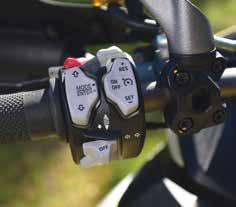
Above: Backlit switching. Nice.
Below left: Our test bike had the Enduro kit. That meant a bashplate, accessory lighting and engine guards. There’s a Touring kit which adds panniers, ’bar bag and heated grips available as well.
Below right: The spring-loaded toe of the brake lever flips over to give a taller or shorter pedal for sitting or standing. It’s a great system.
Top right: There’s a wealth of information on the easy-to-read TFT screen.
but compared to off-road it was like watching a dash cam on fast forward.
Thank goodness for those closed roads on private property, eh?
Awesome.
As we thumbed through the comprehensive material supplied by Ducati there were a couple of interesting things about the 1260 that caught our attention.
One was 15,000km service intervals.
Another was valve-clearance checks at 30,000km intervals.
That’s impressive in a motor offering this level of performance.
We’re not convinced hands-free start up or quickshifters are a big deal on off-roaders, but the 1260 has both. It also has keyless ignition, so if a dopey editor starts the bike and rides off, leaving the Ducati representative with
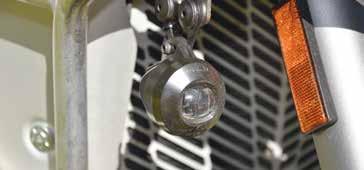
the key fob, he can get waaaaay down the road, shut down the bike for photos, then spend the rest of the morning phoning everyone he knows to get someone to ask the Ducatisti to please bring the key fob to the photoshoot location so the bike would start.
Cruise control, ride-by-wire throttle, semi-active suspension and the beautiful finish and fittings expected from Ducati are all in evidence on the 1260 to a very high degree. There’s a good range of Ducati luggage, apparel and accessories available too, and we really can’t see any area the bike’s lacking.
Suck it and see
This Ducati isn’t going to suit everyone. Despite our being besotted with the handling and power delivery, and the unbelievably huge range of tuning parameters available to the rider, it’s still heavy. It doesn’t feel heavy while it’s moving, but in sand or when it needs to be heaved upright, that mass is going to tell. Performance as incredible as that offered by the Multistrada Enduro 1260 isn’t available at bargain-budget prices. As was pointed out during our time with the bike, our ear-to-ear grin every time we pulled up was an indicator of just how much we were enjoying the ride. It’s hard to think about dollars and cents when an experience of that magnitude is on offer. And anyone considering an adventure bike in this class will be shopping in the same price range no matter which brand they look at.
Ducati has hit a sweet spot with ride enjoyment on its current models, and the Multistrada 1260 Enduro is probably smack dab in the sweetest, high-performance adventure-riding spot of all.
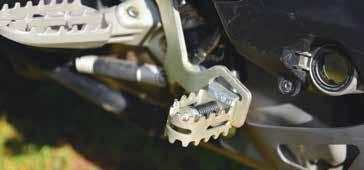


Front
height: 860mm. 880mm with high-seat accessory. 840mm with low-seat accessory
Emissions and consumption: Euro 4 standard. Consumption 5.5l/100km
Fuel capacity: 30 litres
Dry weight: 225kg
Wet weight: 254kg
Standard equipment: Riding modes, power modes,


As big years go, 2019 was an absolute whopper for the Adventure Rider Magazine Congregations.
The first, at Green Valley Farm, Tingha, in the New England region of NSW, was a holeshot-and-brake-slideinto-the-first-turn winner, while the West Aussie Congy was the biggest thing to hit the State since Billy Dampier dropped anchor and said, “I wonder if we could teach these people to play cricket?”
Oh, yeah. They were big events. Here’s a quick rundown on each. If you haven’t ridden into a Congregation yet, you can’t really call yourself an adventure rider. Get ready for 2020 now. Write it down. Put it in your phone…whatever. September 19 is the date for the 2020 Congregation at Green Valley Farm, and as soon as we get confirmation of the next WA kneesup the details will be on the website and Facebook page.
Be there or feel like you’re not really in touch with adventure riding in The Opal-hearted Country.

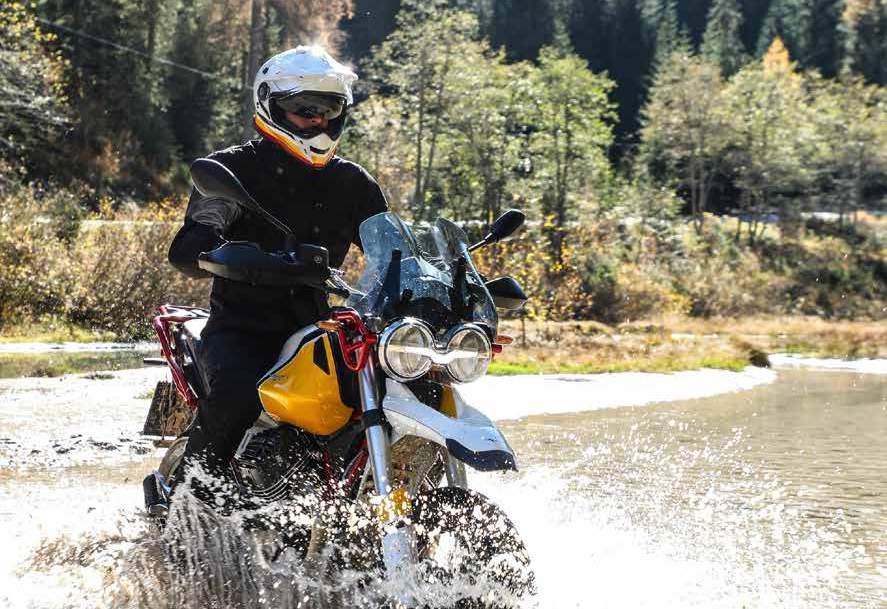



The Classic Enduro V85TT features an exclusive air-cooled transversal 90° V Twin 853cc engine cranking out an impressive 80HP and 80Nm of torque. Coupled seamlessly with a 6 speed transmission and a choice of 3 riding modes – Road, Rain & O -Road – selectable from the advanced MIA ready TFT display, the V85TT is able to satisfy even the most expert road riders, as much as the adventure seeking o -roader.


Rock(s) ‘n’ road(s) is the celebration of the all-terrain philosophy that you can experience astride the V85 TT. No matter what destination you choose, on your V85 TT it will be an unforgettable trip. V85 TT is a blend of two spirits: a rock world made up of adventure and o -road inspired by the desire for freedom and exploration, and a road world represented by road trips, with urban routes and fast long distance, under the sign of elegance and style.
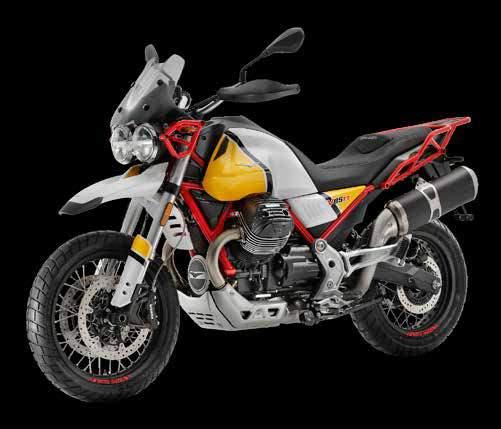
$21,390* RIDE AWAY
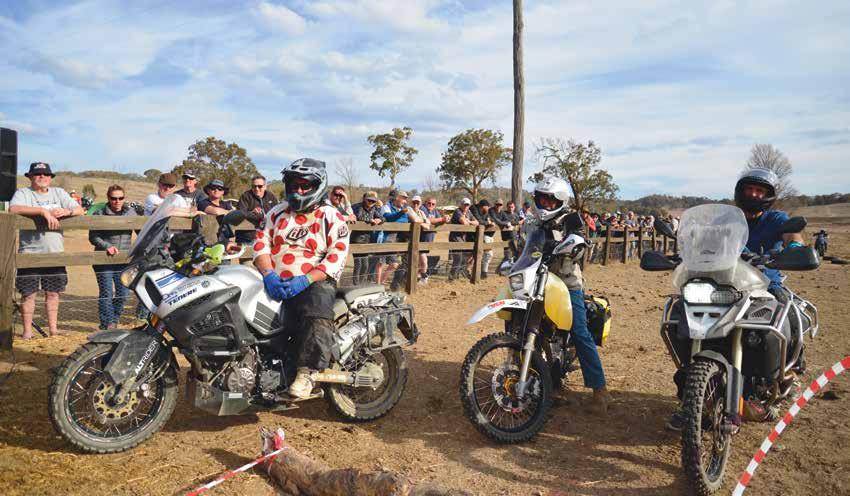
eptember 21 was a big day in the drought-hammered hills around Tingha, NSW. The ground was parched, the animals were starving and the dust was thick on every surface. Water was so scarce the council had to close two lanes of the local pool.
Well. That’s what we heard.
But for all that the landscape maintained its timeless majesty. Green Valley Farm and the Vickery family were in excellent
form, and around 340 riders spent some much-appreciated funds in New England accommodation and stores. The lucky ones were those who stayed at Green Valley Farm. As always, the catering was superb and the campsites brilliantly serviced. The cabins and bunk rooms had booked out well in advance, and those silver-spooners who’d scored the premium accom luxuriated in air conditioning, shaded verandahs and


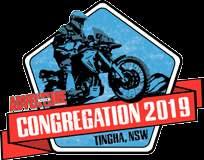





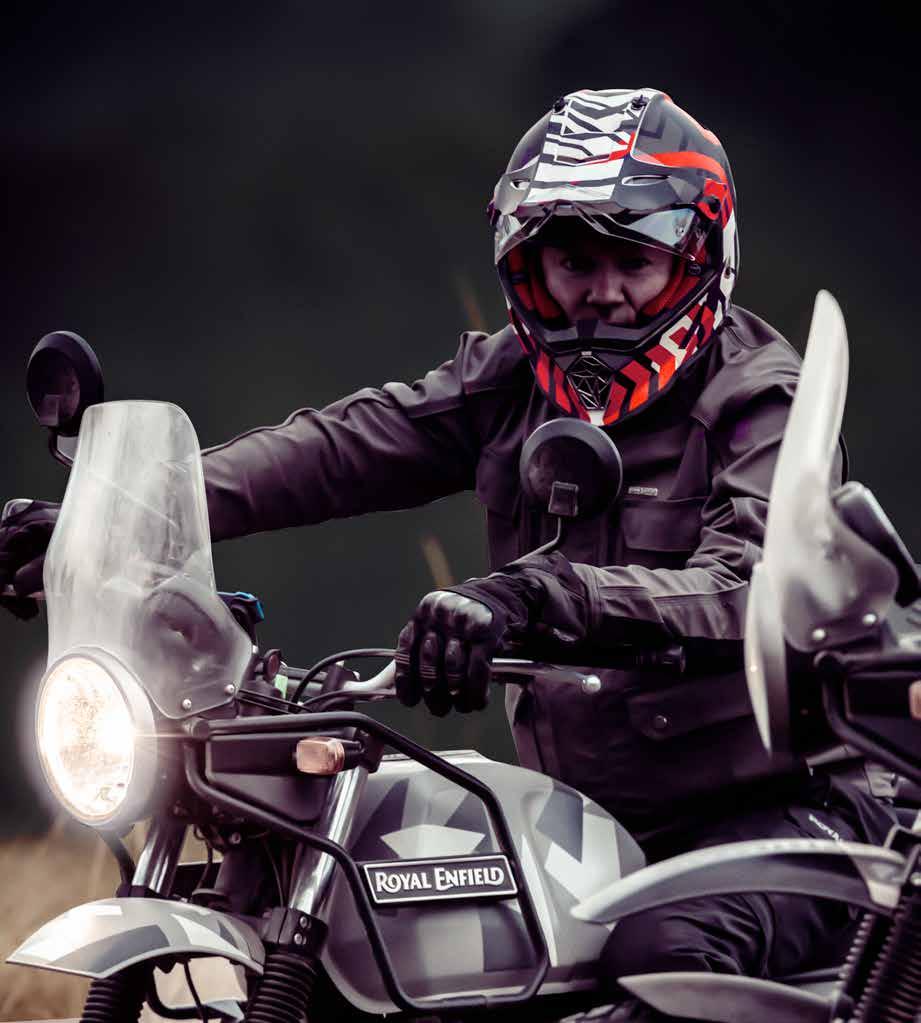


fridges to keep beverages cold.
The campers – the real adventure riders – made full use of the large camp kitchen, hot showers and great amenities to enjoy the fifth NSW Congregation. It went off like epoxy resin at Uluru in December.
It’s getting difficult to fit everything into the official single day of the Congregation, but thanks to some crack organisation it ran like an R80 G/S with newly rebuilt Bings.
Miles Davis kicked off proceedings with another astonishing skills demo, followed by a full-on ’nad-kicker: the Yamaha guys rolled out a brand-spanking-new, real-life XTZ 700 Ténéré!
We shit you not. They rolled the shiny adventure-riding holy grail into the middle of the dumbstruck crowd, told everyone all about it, answered questions, and, melting pants the length and breadth of New England, started it up. Dear, oh dear.

There were some emergency Kleenex dispensed, we can tell you.
Before the reverberations from the thundering – but environmentally sensitive – Akro had even died down, Stephen Gall and Pod Active boss hog Brett Nicholas had launched into an authoritative rundown on the advantages of knee braces, especially for adventure riders.
At different times during the day and evening there were interesting and instructive talks from people like Howard Bathgate from Motorrad Garage, Lewis Croft from Suzuki Australia, and Dakarfinisher Scott Britnell.
It would’ve been very difficult to see and hear everything that went on during the jam-packed Saturday, and of course, some were keen to take advantage of the scenic loop supplied by Dualsport Australia. That meant leaving Green Valley Farm for a while, but the Adventure Challenge gymkhana was a ball-tearer and it looked as though everyone made

Top left: Miles Davis’ skills demo was as jaw-dropping as ever.
Above: Scott Britnell (right) talked about what it was like to compete in – and finish – Dakar.
Below left: Suzuki’s Lewis Croft always looks happy. Below right: Mal and Karen from Adventure Bike Australia had great Congregation deals again. They also had a supertrick DRZ with a wide-ratio gearbox on display.
Opposite left: Brett Nicholas from Pod Active shared some expert knowledge of knee braces.
Opposite right: A Ural means an adventure with a difference.
sure they were back in time.
A test of riding skill, this year’s gymkhana benefitted from the presence of Aussie international off-road legend, Chris Cater. Chris had decided to see what the Congregation was all about, and although, strictly speaking, he was there as a spectator, one of his many amazing talents has always been setting awesome event courses. After a bit of a chat he, Chris Bostelman and Miles Davis got together to really polish what had been a stellar event in 2018.


This year Adventure Rider Magazine’s publisher and ad manager joined the competitors’ queue with people like Green Valley Farm’s Adrian Vickery, Ride ADV’s Greg Yager, DR650 Guru Vince Strang and a swag of starters from the campground to weave, slide and charge their way around a technical and interesting course. The crowd’s boisterous vocal support, egged on by Miles Davis over the much-improved sound system, kept the entertainment level at fever pitch.

A ‘final’ for the top-three runners to establish a winner was a real nail-biter, with the top step of the podium finally going to BMW-mounted Garan Hale after fending off strong showings from Vince Strang and Super T superman, Greg Yager.
As the sun sank behind the rolling hills and the velvety night crept up from the horizon everyone gathered – congregated – at the woolshed. The cold beverages
were served out from the makeshift bar as Steve and Jen Smith from Adventure Moto, aided by Adventure Rider Magazine staff, gave away an avalanche of ‘blind luck’ prizes. Adventure Moto’s contribution alone was something like $4500 worth of fuel bladders, tankbags and riding gear and included a top-shelf REV’IT! riding suit.
Pod Active handed over a pair of carbon-fibre knee braces, and there were T-shirts and smaller prizes galore.


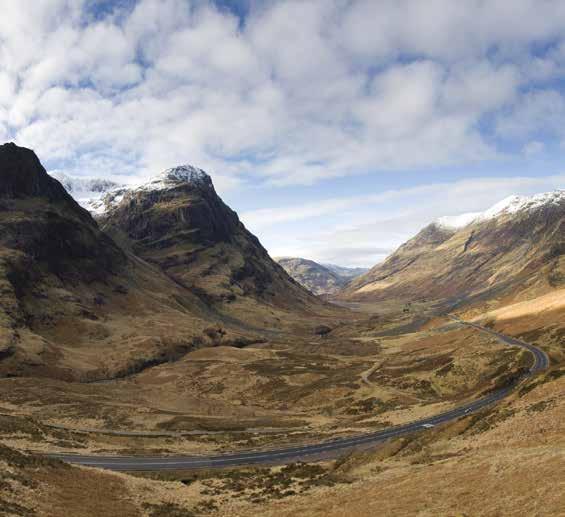













It was a give-away motherlode.
And that finished the formal part of the evening. Some chose to stay and yarn a little, some chose to bunk down before a big ride the next day, and the Vickery family, believe it not, swung into action for next year’s NSW Congregation.
It’s true.
The date has been set – September 19, 2020 – and as soon as it was announced the frenzy began. Bunk rooms and cabins booked out immediately, and there’s substantial waiting lists for both.
So while the rest of us recover, the Vickerys, and Green Valley Farm, are already working hard on 2020’s event. See you there.
Top: Dean and Judy Futcher from the Gold Coast had a very well set up camp. Below: Sold!
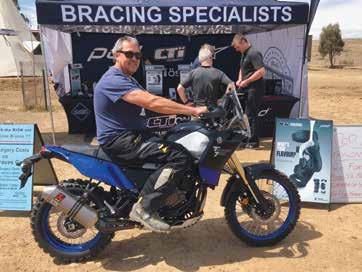

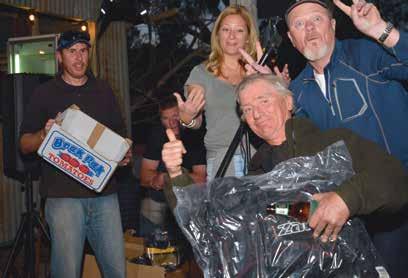
We want to give everyone a gee up for winning a prize, but the way everyone wrote their names on the entry forms was completely shithouse. We’ll do our best, but if your name looks unpronounceable or is spelled incorrectly, you’ve only yourselves to blame.
Fuel bladder: Paul Noppa, Ian Emmett, Rod Moss and Resheteredge
Giant Loop Diablo tank bag: Caroline Anthony and Tren Smith
Giant Loop Fandango: Robert Waite and Martin Tobin
Zac Speed Dakar backpack: Rod Taylor
Giant Loop Zig Zag bag: Steve Alessa, Daniel Martin,
Michael Rgomsor and Bill Birmingham
REV’IT! rain suit: Chris Medley
REV’IT! Off Track suit: Mick Harvey
REV’IT! boots: Glenn Rossler
Folding hat: Matt Grabbo
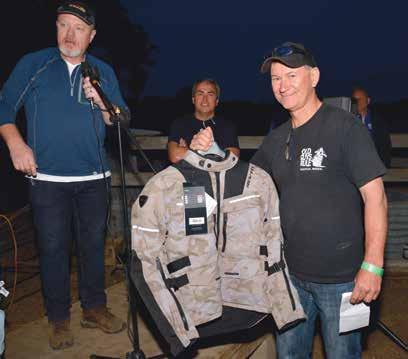



Oxford’s Aqua bags are one of the easiest ways to get your gear from A to B on a motorcycle, safe and dry. They are made from a tough PVC tarpaulin, which is welded to form waterproof seams. When straps are added to perform essential functions, Oxford uses innovative construction techniques to further
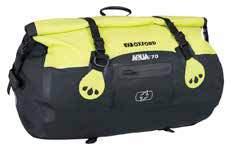




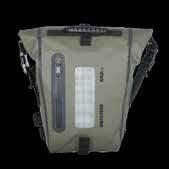






reinforce the bag whilst ensuring complete waterproofing. The latest generation of Oxford’s acclaimed Aqua luggage now offers a choice of six useful bag sizes - from commuter 8L through to ‘epic voyage’ 70-litre versions – plus a range of backpacks and tank bags.


he second West Aussie Congregation roared into life on October 12.
To be truthful, it was such a well-behaved group that there wasn’t any roaring or rowdy behavior at any time, but the impact on West Aussie adventure riders was no less for that.
After a very successful Congregation in 2017, circumstances prevented the running of the WA Congregation in 2018, so the folks at Motorrad Garage, organisers and overseers of the WA pea-gravel party, had to pretty much
start again. A new venue was found at Northcliffe, a few hours south of Perth, Miles Davis was lined up, burgers and guest speakers were put in place, and the whole show hit high gear on a beautiful Saturday morning.
Bush push
The new venue, Round Tu-it caravan park, was a very eco-friendly and backto-nature establishment. Kangaroos, fed and encouraged by the property owners, wandered about looking very marsupially, and alpacas, colourful birds and even a very intelligent pony with some smooth dance steps added a great deal of fascination to the setting. Campsites were set in bush alcoves and a central meeting place with covered seating for meals, guest talks and dining was set up.
Local dealers Bunbury KTM Suzuki, Auto Classic BMW Motorrad and JCS Motorcycles rigged impressive displays and joined in the festivities, while, naturally, Motorrad Garage had a ritzy turnout of its own.
In a very popular move, Miles Davis ran a two-day coaching session at the venue leading into the Congregation itself, and the idea was well received by riders. The coaching session had a good roll up, and the Congy itself had something like 120 registrations. So it got off to a great start.
Eat it
A moonlit Friday night with moderate temperatures saw most of the attendees settled and comfortable in plenty of time to woof into the burgers supplied by the venue. There was a ticket allocation
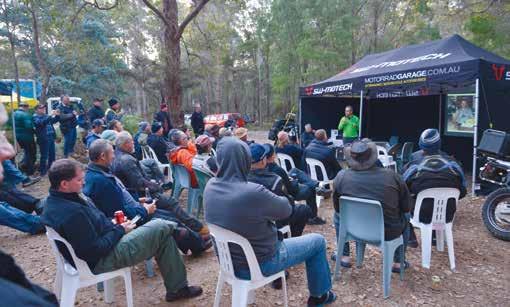

“The complete package for adventure touring off the beaten path and into the hot Australian summer”
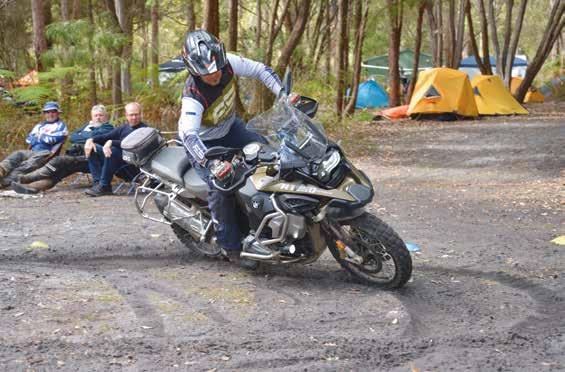
where riders were supposed to present a dinner voucher they’d been supplied at sign on, but the system went a little awry somewhere and an unattended bainmarie chocka with juicy burgers became the site of a feeding frenzy.
We’re not sure what happened there. There seemed to be a lot of shredded alfoil and bemused, wide-eyed people when it was over, but no one was injured and everyone was fed, so we guess the result was good.
It was a torrid few minutes, though.
The big day
Saturday dawned bright and clear, and after a solid breakfast – tickets requested and politely handed over. The queue meek and orderly – things kicked off for real with Miles Davis’ skills demo. Despite the sandy riding surface the supercoach dazzled the appreciative crowd with his usual style and panache, sliding, roosting and wheelying the big BMW like it was a 125 in his own backyard.
It was doubly impressive, because most of the skills demo course was included in the gymkhana that afternoon, so riders were able to get a big dose of reality and see for themselves how hard it really was to control a bike in that setting. As always, Miles had made it look easy.
After the gymkhana there was a few hours free time. Riders were encouraged to ride the supplied 140km loop, but it wasn’t compulsory. Quite a few headed out onto the pea gravel and into the well-forested trails to make the most of a glorious afternoon, and it was generally thought to be a very pleasant and scenic track.
Adventure Rider Magazine’s editor borrowed a Motorrad Garage BMW –because the KLR didn’t have a GPS – and cut the course before stopping at a creek for photos. After standing around for half-an-hour or so, wondering why the riders he’d passed hadn’t shown up, he returned to the bike to find a flat front tyre. Fortunately, the course-cutting manoeuvre had lopped about 138km off
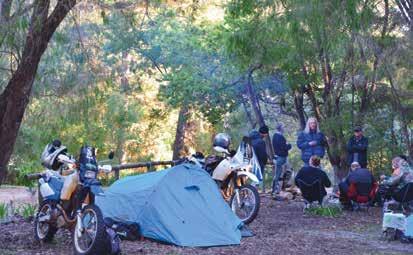
Left: Miles D. Awesome, as always. Below: An eight-millimetre projector brought in, strapped to the back of a bike, for the occasion.
Bottom left: Campsites were in bush alcoves. Bottom right: Oh, no! How long will Motorrad Garage put up with the editor doing damage to its KLR? Howard effected another repair.

the 140km loop, and the ride back to the start on the flat turned out to be short and did little or no damage.
Mate against mate
Play resumed in the mid-afternoon with the gymkhana, and it was a doozy.
The brave riders signed up for a very technical run through the usual slow race, circle-in-the-small-box, a trials section and a couple of other challenges, while the spectators sat back and offered plenty of helpful support with loud and humorous comments and a great deal of laughter as bikes hit the dirt right, left and centre.
The trials section, bunted around some convenient trees, proved the undoing of most of the field. No-one made it
















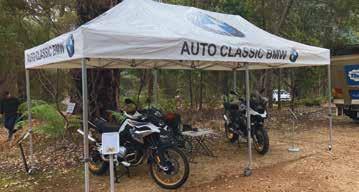

Top: Auto Classic BMW showed off a few Beemers and gave away some cool prizes.
Above: JCS Motorcycles had some spoofy Triumphs and a Royal Enfield Himalayan on display. Nathan from JCS joined the ride down and back on the Scrambler.
Below: Petra and Howard from Motorrad Garage ran a first-class Congy. Bottom: Bunbury KTM Suzuki had a big presence.

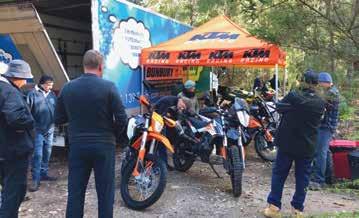
There were a gazillion prizes given away at the presentation and we couldn’t keep up with all of them. Every entrant in the gymkhana received something, and T-shirts, stubby holders, keyrings, vouchers and bike gear were flying about the place like bats in an orchard.
Here’s the main ones…
1. Nick Cooper (an Auto Classic BMW voucher)
2. John Tuckett (a Bunbury KTM/Suzuki voucher)
3. Dirk Schoendube (a waterproof bag from JCS Motorcycles)
Determination Award: Lisa Potter (a waterproof bag from JCS Motorcycles)

Lisa Potter, winner of the Determination Award and a crowd favourite in the gymkhana.

Motorrad Garage made up some collectible, limited-edition stubby holders which were sold at the event with every cent going to the Royal Flying Doctor Service. To back that up, every donation also received a raffle ticket, with the big prize being $1000 to spend at Motorrad Garage. Nearly $900 went to the RFDS, and the prizes went to:
Mark White (Motorrad Garage $1000 voucher for SW-Motech accessories)
Dave Allen ($150 voucher to spend at Auto Classic BMW) Mic Vanhalteren (Triumph roll-top bag from JCS Motorcycles)
through the entire course penalty-free, and when the dust settled the win went to Nick Cooper, closely followed by John Tuckett and Dirk Schoendube. The dealers onsite offered huge support, and each supplied hefty prizes for the top three.
A special cheer needs to go to Lisa Potter. Lisa toughed out a very rugged run through the gymkhana course, dropping her Beemer several times and looking a little worn at the end, but she won the crowd over by never giving up. Every time the bike toppled over she picked it up and kept going until, with a huge cheer, she finished the course, earning the Determination Award in the process.
It was a thoroughly enjoyable afternoon for all concerned.
As the afternoon sun descended toward the horizon the focus moved back to the main area where Ewen MacGregor told of his Trans Euro Trail adventures, complete with some excellent video and images. That led to dinner and the awarding of a substantial wadge of prizes, including The Big One: $1000 worth of SW Motech

clobber from Motorrad Garage, taken home by Mark White.
Those who’d been at the Nannup Congregation in 2017 were chewing their nails in anticipation of another rip-snorter presentation from brothers Andreas and Fred Powell, and the pair put on an edge-of-the-seater, complete with film shown on the eight-millimetre projector brought in, strapped to the back of a bike, for the occasion.
It was a superb end to a really first-class day.
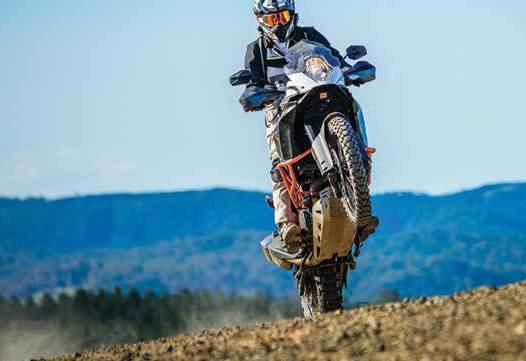
Sunday morning saw a quietly happy breakfast and pack up before the riders said their goodbyes and headed to their next adventures.
As we write this there’s no date been decided for the next WA Congregation, but as soon as it’s locked in it’ll be announced on the website and Facebook page.
The sooner the better, we reckon.
We had a ball on this bike when it was released in 2017. We loved the simplicity and how it seemed to be all about the fun. Now with EFI and ABS, it’s every bit as enjoyable, with maybe just a small nod to the modern world.
It was in issue #24 we rode the first Himalayan in and around the Great Ocean Road in Victoria, and we made no secret of how much we enjoyed the bike. For sure Royal Enfield Australia turned on a stellar launch with incredible riding and amazing catering, but as we said at the time, it seemed to us that’s what the Himalayan was all about – just getting out there with some great people and living life to the full. It might be worth readers going to back to that issue and reviewing our impressions, because they’ll nearly all apply to the EFI bike.
For 2019 very little has changed with the Himalayan. The company gathered a great group of people together, took them to a superb location and let them loose. The bike is the same except for the addition of ABS and fuel injection, and although we’re talking about a 411cc, single-cam, air-cooled motor and only simple suspension, we once again came away wishing we could
do a lot more riding the way it was done at this launch.
The people, catering and location were fabulous, but again, the bike was the biggest part of the experience, and we’re thinking that’s what the Himalayan offers most of all: an experience.
The motor, gearbox and final drive on the fuel-injected Himalayan are unchanged, and that’s good news. Potential buyers of a bike like this won’t be looking for 150 horsepower and adjustable high- and low-speed compression damping front and rear. There’ll be a group of LAMS buyers for sure, and some who shop in the price range – this is an incredibly inexpensive bike – and a few perhaps who feel they’re buying into a very respected and historically significant marque. None of those groups will be disappointed. The Himalayan will answer all their expectations.
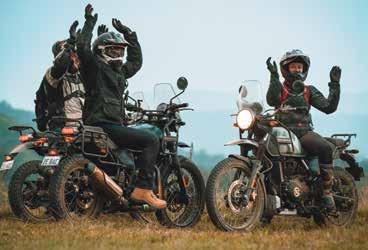
Main image: The Himalayan is all about just getting out there and living life to the full. Below left: There always seems to be a lot of clowning around whenever the Himalayans are involved. It’s one of the things Adventure Rider Magazine enjoyed most about the bike. Below right: A pro-classer for goofing about and enjoying life.

But in the adventure segment there may well be a group who look to the bike in the hope of it being a simple, rugged, easy-to-own dualsporter, which coincidentally meets all the criteria of the other groups we listed. That group won’t be disappointed either. We’d go as far as saying anyone who found themselves feeling shortchanged with the Himalayan should urgently get themselves a fun transplant.
As usual, the importer set everyone up in a scenario where the bike would show its best. From Ballina on the NSW north coast the bunch of happy and easygoing media professionals made their way along some roughish asphalt backroads where the scenery varied from beautiful panoramas of mountains, valleys and rolling grassland to canopies of trees enveloping the roads from either side. The willing little 411cc motor meant street-legal speeds felt great
u

and sightseeing was just a natural part of the ride, the suspension dealt with the choppy roads, braking was more than adequate, and both sitting and standing seemed equally comfortable – although the seat could probably use a little more padding. We heard some comments to that effect from other riders.
During the numerous photo and video stops the 800mm seat height meant it was easy to plop both feet on the ground to sit and wait, usually while enjoying a quiet yarn.
Fuel injection has given the throttle response a definite ‘feel’. The bike Adventure Rider Magazine had was just a little jumpy off low throttle openings, and when the fuel level was down to what must’ve been little more than fumes –thanks to someone not paying attention to instructions at the campsite – the motor registered its unhappiness by stalling when left to idle at intersections and giving the occasional miss on a trailling throttle.
That was the only time there was any difference between the carburetted version and the EFI version that we could tell. Otherwise it was business as usual.
We didn’t actually get to check the fuel consumption, because the bike had to be refuelled from the support vehicle and the trip meter had changed to counting down the distance into reserve before we checked it, but 15 litres on a fuel-injected 411cc single should give a range of something around 250km or so, and we think that’s entirely appropriate on a bike like this one.
Treating it rough
Off the tarred road the Himalayan really comes into its own.
It’s not an enduro bike by any stretch of the imagination, and wouldn’t go head-to-head with any of the KTMs, for instance. But what it does do is cope. With just a little common sense from the rider there’s not much it won’t do.
For the type of rider we expect would buy a Himalayan, it’s ideal. The low seat height and slim feel make it really easy for
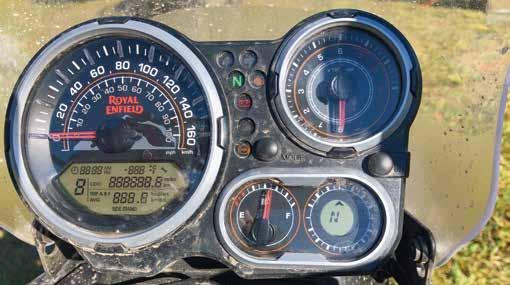
Easy-to-read instruments. The compass is especially cute. Below left: No need to pull in the clutch to start the bike in neutral. We were surprised how convenient that was. Below right: Simple. Like it.
Top right: The willing little 411cc motor meant street-legal speeds felt great. Good torque was big help off-road. Bottom right: It’s the type of bike which takes riders to places places where time doesn’t seem to matter so much.
the rider to put their feet on the ground and waddle the bike wherever they want it to go…usually laughing and carrying on like a loon while they do it. With only just over 24 horsepower the Himalayan was never going be a big threat to The Environment, but a surprisingly good torque figure of 32Nm meant even tougher trails don’t stop the bike. It needs to be taken through harsh terrain at reduced speed and with an eye on the bike’s dualsport nature, but we never once felt it wasn’t going to conquer the tracks we aimed it at, and that was largely because it could be torqued through at fairly low throttle settings.
For those who are wondering, the ABS can’t be turned off, and there were a couple of heart-stopping moments on a downhill where things looked a little hairy, but it was largely due to a lack of care on our part. By that stage there was a lot of hooting and hollering going on and we couldn’t help but join in, putting the bike to the descent way faster than we should have (we made the overtake, though. Yeehah!). Aside from the ABS, both front and rear brakes did the job. They weren’t super strong, but
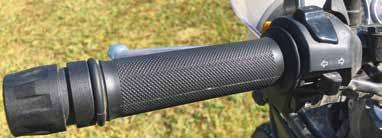

howled through a little bit of sand, got bogged up to the sump in some loose rocks – not our bike, thank goodness. One of the staffer’s – and hacked along some dirt road and rutted trail without presenting any problems we could find.
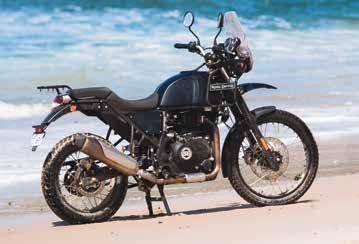
they weren’t underpowered either. They worked fine.
As for the suspension, both front and rear will bottom out without a lot of provocation, and with luggage on board that would need some management. But still, where on other bikes we might’ve worried about that, on this bike we noted it, tried to remember to be responsible, then got on with hooning about and enjoying ourselves. There’s a lot of that goes on with Royal Enfield’s Himalayan.
That’s enough about how much we enjoyed the Himalayan, both in 2017 and now.
What’s it like to ride?
It’s comfortable and capable. We scooted around plenty of bitumen country roads and loved the lazy, easy pace. The screen provided good protection from the windblast, we found the seat comfortable, even though it locked the rider’s bum into a single position, and while there’s not heaps of power to be tamed from
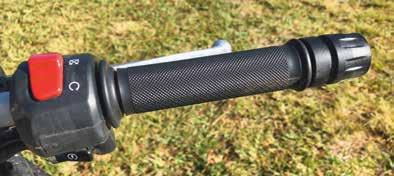
Both the brake pedal and the gear selector were easy to knock with a boot. The brake pedal is a big’n, and while standing we needed to move the right foot out a little on the ’peg to make sure we weren’t dragging the rear brake. The gear selector seemed like it only troubled us in second, when we’d occasionally knock it into neutral.
As a final thought the Enfield has a paper air filter. We don’t feel that’s likely to present a problem, but if anyone wanted to cover long distances away from reasonable-sized towns a foam filter which is easy to clean might be a good idea.
Other than that there’s not much to tell. The Himalayan is free from any real vice or problem as far as we could tell.
At the outset Royal Enfield said the bike was designed to be ‘ridden through the Himalayas’, and while we’ve never done that trip, we can imagine it being an ideal choice for that challenge. If we were heading out to cover a lot of distance over terrain we weren’t sure about, we’d be happy to take the Himalayan, especially with the panniers we saw on one of the staff bikes. They looked like they mounted well and were a great size.
But after all that, we still think it’s the sheer, simple fun that makes this bike so appealing, and we felt that appeal was huge. We can’t wait for the next chance to get back on a Himalayan.

Web: royalenfield.com.au. Rec retail $6490 plus on-road costs.
Warranty: 24 months or 20,000km + two years roadside assist.
Engine type: Single cylinder, air-cooled, SOHC four-stroke
Displacement: 411cc
Bore/stroke: 78mm x 86mm
Compression ratio: 9.5:1
Maximum power: 24.5hp (18.02Kw) @ 6500rpm
Maximum torque: 32Nm @ 4250rpm
Ignition: Digital electronic
Clutch: Wet, multi-plate
Starter: Electric
Transmission: Five-speed constant mesh
Lubrication: Wet sump
Engine oil: Semi-synthetic 15W 50 API, SL grade and above JASO MA 2
Fuel supply: Electronic fuel injection
Air cleaner: Paper element
Electrical system: 12-volt DC
Battery: 12-volt, 8 AH MF
Headlight: 12-volt H4 60/55-watt
Taillight: LED
Turn-signal lamp: 12-volt, 10-watt x 4nos
Rear-wheel drive: Chain
Frame: Half-duplex, split-cradle
Front suspension: Telescopic, 41mm forks, 200mm travel
Rear suspension: Monoshock with linkage, 180mm wheel travel
Brake front: 300mm disc with two-piston floating calliper
Brake rear: 240mm disc with single-piston floating calliper
ABS: Dual channel
Front tyre: 90/90-21
Rear tyre: 120/90-17
Fuel capacity:
Words:
Not many invitations include a support crew for a six-week adventure trip to the Kimberley. Melbournebased James Otto was quick to accept.

Left: Didn’t need to tighten a single bolt or nut.
Right: The fall scratched up the engine cases nicely.
Below: Ivanhoe Crossing is picturesque but needs to be treated with respect.

Less than four weeks out from the start of the trip I had a self-created problem. The DRZ400 had about 40,000km on it, and I didn’t think either it or myself would be up for the 13,000km round trip from Melbourne. I needed to buy a replacement bike quickly.
Research consisted of a quick look at Youtube and a phone call to the local Honda shop to see if they had a 2019 DCT Africa Twin in stock. I rode out of A1 Motorcycles on a brand-new bike less than 24 hours later.
“Do you want to wait for the lower crash bars, sir?” I was asked as I thumbed the starter. “No time for that,” I replied, wondering if that might bite me later. Then the panic set in.
While I had years of off-road and bike experience, the Africa Twin was quite a different beast to anything I’d ridden. I was going to be faced with thousands of kilometres of dirt roads and just as many kilometres of tracks, including the Canning Stock Route. I had confidence in the bike, but perhaps not so much in my ability in the soft sand, corrugations and
wheel ruts on the big bike. Had anyone even taken an Africa Twin up the Canning? When you can’t find a Youtube video it generally signals a potential problem. The shop staff looked a little doubtful, too.
Perhaps I should have re-evaluated.
I thought I’d better do a quick run around Victoria trying out some different surfaces before the big trip. Three days and 2000km later the AT was back for the first service and I had a few initial observations. The DCT (dual clutch transmission) system was actually much better than I’d anticipated. I took a couple of days to stop looking for the gear shift and clutch, but it was magnificent after I had myself retrained. The 1000cc motor and DCT looked after themselves, always working out the right ratio and performing quick and accurate gear changes. Given enough right-handed enthusiasm the bike accelerated like a locomotive. Cruising at 160kph plus behind the good-sized screen wasn’t an effort, and sprints well beyond those speeds were possible (private-road stuff only of course). did note the speedo was
u

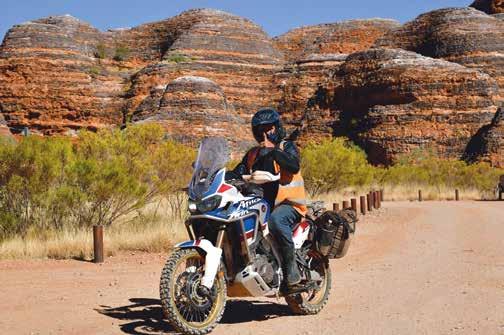
perhaps a little optimistic when compared to the GPS.
found I could actually ride reasonably fast on dirt roads and tracks despite the 240kg or more weight of the bike – that was until I had a good off for the first time (although in fairness I was pushing things on an uphill rutted climb to test the limits a little). The result was a busted brake lever and bruised pride, but nothing serious.
The initial few days also showed I needed some new gear.
My old panniers were tossed for a set of Andy Strapz soft panniers and a new jacket, gloves and boots joined the party.
Helmet choice was a quandary. The motocross helmet I used on the test ride had some real issues with both noise and the wind catching the peak at speed.
It was much cooler in slow riding though, and the heat in the north of WA would make that important. In the end I took both helmets, adding more weight to the loaded 4WDs.
Tyres were also a dilemma. I cheated, calling up Desert Edge Motorcycles in Alice Springs and asking for a recommendation. They were brilliant and I ordered a set of Motoz Tractionator H/Ts ready for when I passed through.
Then, at the last minute, halfway to Alice, I needed to order a replacement brake lever (A1 Motorcycles in Melbourne had got a couple in for me, but like an idiot I’d forgotten to pick them up).
At least I’d managed to grab the spare air filters.
After 13,000km and a simply brilliant trip I think I’m partially qualified to make
some observations about the Africa Twin.
No question about it, it’s a big, powerful bike. It eats up the road kilometres and is equally at home on all sorts of dirt roads and track. I absolutely smashed the bike over crappy terrain, dropped it a number of times and basically tried to kill it at every opportunity. Not a single problem was had that wasn’t self-inflicted. The factory build quality and delivery prep by A1 Motorcycles resulted in a bike that was simply astounding. No kidding. I didn’t need to tighten a single bolt or nut. There are some things I think deserve a mention.
ABS, traction control and power settings are all selectable. In the beginning it seemed like I needed to prepare the flight deck for takeoff every time I turned the key, but I quickly adapted. It does have a user memory setting, but in the real world you’re travelling over ever-changing terrain and typically the saved setting won’t be right for the situation. It would’ve been nice if the last setting was recalled after a morning tea stop, though. It’s particularly important in situations when ABS really wants to kill you. For example, heading at warp speed down a dirt road and not spotting a creek crossing in the path and the idiot on the bike has left ABS turned on. The result is it seems the application of said brake on the corrugations actually makes the bike accelerate.
Traction control, while effective on roads and hard-packed surfaces, doesn’t cope at all with corrugations, but the suspension coped unbelievably well.
I’d read about some owners bemoaning
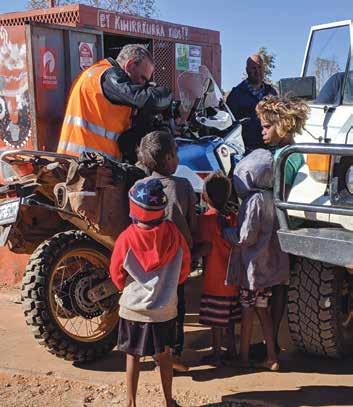
the absence of cruise control. ‘How soft are they!’ I thought. Suffice to say I’ve now joined the Soft Boys’ club. I would’ve given much to be able remove my hand from the throttle to get rid of the pins and needles on those 800km road days.
Mum’s the word
While I’m embarrassing myself, perhaps I would also request an extra setting on the heated grips. On the short prep trip they seemed perfect, but in the cold desert mornings I never seemed to get enough heat into my hands. It’s a first-world problem, for sure.
Replacing air filters was a serious pain in the arse. On our dusty Australian dirt roads they need to be replaced or inspected on a



regular basis. I’d like to see some changes made to make this much easier.
The Andy Strapz panniers stood up very well. I did rip some straps off, but that was my own fault. I don’t think the design criteria allowed for passing between trees narrower than the width of the bike.
The 23-litre tank carried me past 400km, on tarmac obeying speed limits, several times, although typically I could count on between 300km-330km per tank on most road types.
You might note in the photos the high-vis vest I was wearing. It was actually very handy when traveling with others. On the road I was very easy to spot, and when parked I hung the vest on the handlebars. It certainly made it easy for the 4WDs to keep track of me, as well as the usual obvious safety considerations. Thanks for buying it for me, Mum!
While we’re talking about clothing, the Aplinestars Tech-Touring jacket was excellent. It was warm as toast on the coldest mornings with the warm liner fitted, and there’s plenty of ventilation with the liner removed and vents open for when the days warmed up. Draggin Jeans pants with padding served to lessen the damage when I crashed.
The Motoz Tractionators were spot on. They did some 7000km across the worst Australia could offer and looked very secondhand at the end of the ride, but I was extremely happy with them. I probably ran higher pressures than ideal for a while, but eventually settled for 24psi in the front and 28psi in the rear and I had zero punctures. They’re a great tyre I will continue to use.
Now the big one.
Before I left I knew the biggest challenge for both bike and rider would be the sand on the Canning. I hadn’t ridden much sand, and in reality the Africa Twin wasn’t operating in its design sweet spot in such terrain. But it turned out to be only 600km or so of the overall trip.
It also didn’t help that the day before hitting the Canning at Well 33 I had a big off at speed hitting a washaway I simply didn’t see. It didn’t leave my confidence at peak levels for what was to come. The fall scratched up the engine cases nicely and I thought back to the lower crash bars I’d declined when I picked up the bike.

In the first couple of hours on the smaller dunes I must’ve crashed half-a-dozen times. Exhaustion from picking up the bike and trying to adapt my riding for the soft sand just made the situation worse.
But my nightmare had just begun. My brother Rick, driving one of the 4WDs, basically kicked my sorry arse off the bike and proceeded to roost over all the sand dunes in sight, riding the big Africa Twin like a motocrosser. Years of telling him I was the better rider were smashed in minutes. Shitbags!
So it can be done. And my brother, in a very narrow range of specific conditions, is a better rider (that’s as much credit I’ll give him).
It was an amazing trip aided by an
Above: Good advice.
Below: Relaxation stops were spectacular.
impressive Honda adventure-bike creation.
After eight weeks of ownership the bike had over 15,000km on it and wore a few scars. I have no regrets about purchasing the Africa Twin. It truly is a great adventure bike, capable of travelling across our land with confidence. I’ve no doubt it will last me well despite my best efforts.
Thanks to Rick, Karyn, Dave and Ingrid for making the trip happen and carrying gear and beer. What a trip!




That meant 28 keen-as-all-getout
Urals, chocka with riders, passengers, dogs and some quite astonishing payloads. What a superb, friendly and capable group it was.
Close call
Looking for new riding challenge? Jump in a Ural sidecar. We dare you.
Sidecars aren’t for everybody. They’re certainly not for wooses or people with big ideas on themselves. In first place, the three-wheeled riding experience can be as scary as hell. It doesn’t have to be, but it can be. In the second place, even competent riders are occasionally caught out by some unexpected three-wheeled challenge (see issue #29 for an example – ed).
The tenth annual Ural Adventure Ride had a few empty seats in sidecars and Adventure Rider Magazine was invited to fill one of them. It was a couple of days of amazing contrasts.
The ride kicked off from Ural Australia headquarters in Uralla, near Armidale, NSW.
The annual adventure is actually run by gun sidecar trainer Jon Taylor of uralofoz.com.au and supported by Ural Australia, but it’s such a closeknit bunch of people it’s hard to tell who was taking responsibility for what. In a very refreshing change, it seemed everyone was happy to accept responsibility for their own actions, and at the same time couldn’t wait to jump in help anyone else in any possible way – whether that was sharing sugar for a coffee at morning smoko or pushing severalhundred kilos of fully loaded Ural up a loose, crappy hill.
Jon gave thorough briefings each morning and evening and did duty as leader. Spanner ace Mat Hodge, who had shown himself indispensable on previous rides, rode sweep, and Clare Mailler from Ural Australia handled the support vehicle and had the only kangaroo contact for the entire weekend.

Top left: Teams hurled their rigs at the considerable erosion contours and sizable hills.
Top right: One of the most pleasant and friendly groups Adventure Rider Magazine has travelled with.
Above: The annual adventure is actually run by gun sidecar trainer Jon Taylor of uralofoz.com.au and supported by Ural Australia.
Kicking off from Ural Australia in the main street of Uralla, the whole show hit the road for a lazy wander to smoko at Kingstown – a place which made Uralla look like a metropolis. Smoko also gave the opportunity for a last-minute briefing before heading onto the dirt on a road called The Fusty As Duck Trail.
We’re not sure if that was its real name, but that’s what we thought we heard several people muttering, so that was probably it.
On a glorious sunny day the dirt road wound its way through the Nandewar Range, numerous sheep and cattle and some big, fast-moving groups of
kangaroos. Sweep Mat Hodge gave an impressive demonstration of a threewheel-lock-up emergency stop as a gargantuan marsupial hefted its considerable bulk in front of his Ural. We thought we heard girlish screaming, but we couldn’t be sure if it was Mat or perhaps dust on the brake discs. In any case, the ’roo bounded off to places unknown, and while Mat appeared to stay calm and motored on unruffled, Adventure Rider Magazine may have lightly soiled its undergarments just having seen the incident from the upholstered, padded-seat opulence of a sidecar some distance away. Until then the sunshine and comfort had us, we admit, in a bit of a dusty drowse.
The rest of the field, meanwhile, continued its determined progress westward in eager anticipation of lunch at Barraba and some interesting accom and a great dinner in Narrabri.
Below: Chris D, from Ipswich in Queensland, had the fastest hat on the tour. u


A total of 28 Urals, chocka with riders, passengers, dogs and some quite astonishing payloads fronted for the challenge. Richard Vernon and his blue cattle dog Tish were ready for anything.
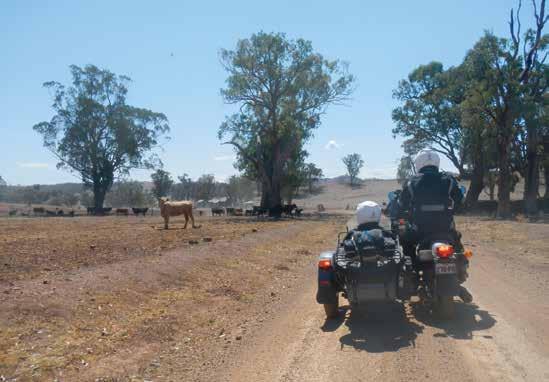

Lunch, a very leisurely affair involving a chicken-and-mushroom filo and several excellent coffees, was a very pleasant stop in a very pleasant day. With appetites assuaged and thirsts quenched – the Ural folks are quite capable of using words like those, and they don’t even use ‘like’ as every second word – the day rolled to a warm close at an old pub in the middle of Narrabri, now converted to a B&B and displaying some truly beautiful timber fittings and stained glass. The Centre Of Town B&B and its colourful proprietor ‘Spider’ were highlights of the ride.
After showers and changes of attire the group retired to a reserved room at the Narrabri RSL where the excellent company and dining continued.

Left top: The dirt road wound its way through the Nandewar Range where numerous sheep and cattle wandered back and forth in the dust.
Left: Adventure riding on a Ural is not for wooses.
Above: Mark Budden from Raymond Terrace in NSW wasn’t putting up with cold ears.

it had been great fun, and that no-one had looked at any stage as though they wouldn’t get through. The teamwork and mutual support within the group was quite uplifting.
It did take a bit longer than expected to get through the track though, and there was a danger Barraba might be closed when the Urals arrived, but nobody seemed too concerned about that either. Some rigs were carrying enough gear to survive long periods unsupported, and lunch would’ve been the least of their problems.



The Ural folks are big supporters of the Westpac Rescue Helicopter Service and a bucket was passed around for donations.
Ural rider Chris Barnden was there in person to tell of the Westpac helicopter’s part in his rescue when he lost a leg in a road incident. Despite Chris’ irrepressible nature and humorous observations on losing a limb, the story was a dramatic one and donations were generous.
Dinner conversation was wide-ranging and included the probability of this adventure ride being Australia’s largest gathering of Urals.
As the evening wound on Jon Taylor leapt to his feet to tell terrifying stories of the next day’s adventure section down the east side of Mt Kaputar. Everyone looked pale and scared but agreed they should have a go anyway.
A gentle run through the foothills to the east of Narrabri to a very civilised coffee-and-muffin stop at a trig point and lookout kicked off the second day. The Ural folks really know how to carry good smoko kit. Adventure Rider Magazine was treated to an amazing ‘peanut drop’ biscuit and a coffee, thanks to a couple of Ural teams combining to provide all the ingredients. There were plenty of other folks wandering around offering treats of various kinds, and the range of refreshments was quite staggering. From smoko it was on to the dreaded Barraba Track, the adventure section for the day.
In spite of Jon Taylor’s horror stories of the night before, most teams hurled their rigs at the considerable erosion contours and sizable hills with varying levels of confidence. As we’d seen on previous Ural rides, nobody become fretful or excited. If someone didn’t make it up a hill, everyone nearby just jumped in and started pushing and shouting encouragement. It was a relatively tense traverse for Adventure Rider Magazine, cocooned in the comfort of the sidecar, while Willawarrin rider Ian Bray powered the rig through the tougher sections of terrain – being careful not to dislodge the fridge from the rear rack of the sidecar – but everyone else seemed to think it great fun. We didn’t realise until later that
After the Barraba Track the run back to Uralla seemed a doddle –except for a flat tyre on one rig and the support vehicle slamming a ’roo and putting a bend in the new bullbar not far from home base.
The return to Uralla marked the end of Adventure Rider Magazine’s Ural adventure, and it was a very interesting and pleasurable couple of days. The view of all the excitement and challenges from the sidecar was an interesting one – thanks Ian Bray for a smooth and easy trip – and the people made up one of the most pleasant and friendly groups we’d ever travelled with. The Urals themselves are amazingly versatile, but we knew that from our own time piloting the rigs around (check issues #29 and #32 to see we didn’t treat them gently), and as a platform for sightseeing they’d be hard to beat. They also bring a whole new dimension to adventure travel and we’re grateful to Ural Australia for including us.
As we drove off to find our road home cut by bushfires the Ural group met at Jon Taylor’s training facility and capped off a great ride with a morning of not-too-serious competition in oddball challenges followed by a barbeque.
It’s an annual event, so log on to www.imz-ural.com.au to look for the next one or line up a test ride.
Above: Checking the terrain and waiting for the ‘all clear’. Below: Ian Bray (right), from Willawarrin in NSW, carted the editor around for a couple of days and did a great job.
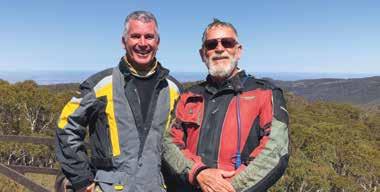

A jump starter pack will give you power anywhere, anytime. It is one of the most important pieces of emergency kit you can carry with you. Whether you’re on an outback track or heading home late at night, a jumper starter will protect you if you’re stranded with a flat battery.
Our jump starters will start motorcycles, watercraft, ATV/ UTV, snowmobiles and petrol car engines up to 4.0L (300A Jump Starter) and up to a 6.0L AND 3.0L Diesel automotive engines (400A Jump Starter)
They will also charge your phone or tablet through the USB outlets and all have a built in LED light.
The jump starter pack comes in a carry case with a 220v wall charger, a 12v accessory plug for on bike charging, battery leads and a combination micro USB/lightening charging cable.

For further information on these and all our products, please check our website for details.
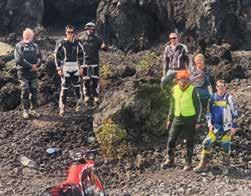
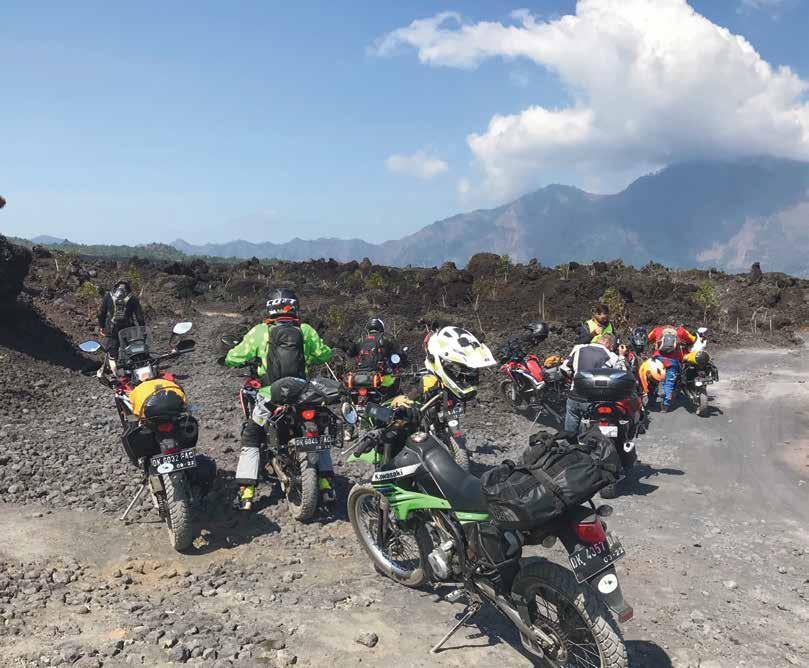
According to Colin Bayman, the Perth Adventure Riders had a great time acting their age on a recent ride through the Aussie holiday Mecca of Bali.
Most Bali dirt rides involve extreme, hardcore enduro, riding 450s on the rev limiter through local villages, wheelying past farmers quietly working on their crops or on a single trail high in the mountains where only someone with Toby Price’s talent could launch an enduro rocket into second gear.
The Perth Adventure Riders (PAR) approached Motor Adventure Bali, located in Seminyak, and described the experience the group wanted. The predominantly mature-age riders wanted an adventure ride with a few challenges, quality accommodation and some decent bikes. Coffeeand-cake stops were mandatory.
The word went out and 16 riders expressed an interest. With the chaotic roads and crazy drivers on the island the tour company advised splitting the group in half and doing two separate tours a week apart.
A cheap Air Asia flight was booked for around $230, including enough luggage to transport a full riding outfit.
That’s right. Take all your own stuff and wear what you would wear at home. Falling off in

restaurant for dinner and an early night in preparation for the four days of riding.
It really doesn’t matter how many rides or tours I’ve done, I still get excited the night before and have trouble getting to sleep.
My mate Pete and myself decided to take the KLXs on the first day and give them a whirl. We’d ridden the CRFs the previous year and knew how they performed, so after a run on the KLXs we could decide if the bikes were to rotate through the group. By the end of the day we realised the older Kwakas were better than the flash CRFs. The closer gaps between gears made it easier to ride up the very steep switchbacks and there were some brake-fluid boiling issues on the Hondas on a couple of the long, steep downhills. My only complaint on the KLX was a sore bum, but that’s what you get when you ride a trail bike with a standard seat for 660km over four days. Next time I’ll bring an AirHawk or lambswool cover.
Insert:
island.
Indonesia hurts the same as falling off in Australia.
After a bloody long wait in immigration at Denpasar airport we finally made it out of the terminal where my trusty Bemo driver of 20 years took three of us to our hotel. Others on the tour came on different flights. On arrival we found the bikes neatly lined up, prepped and ready to roll, for the next morning. With eight on our tour we had six late-model CRF 250 Rallys and two KLXs, all in good nick and wellpresented.
The Taman Ayu Hotel in Seminyak, while not high on the star rating, was perfect for a bunch of guys riding bikes. There were ample rooms, a pool and a good restaurant. The road outside had several other eateries to choose from, along with pubs, coffee shops and all the standard Bali stores. All in all, it was a very good location.
After a swim and a few Bintangs it was into the
At the close of the first day we were high in the mountains. Accommodation was in a different location each night, and we all had a small, soft bag strapped to the back of the bikes to carry our shorts, T-shirts and toothbrushes. Wearing the same riding outfit for four days did get a bit on the nose, but hanging them on the balcony each night helped. u
Above: The older Kwakas were better than the flash CRFs. Below: High in the mountains.




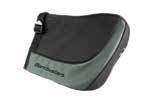


Dinner was down the road at a smaller restaurant and from memory cost around $15 for an entrée, main course and a couple of beers. Breakfast was included in the tour so we were up early, fed, booted-up and ready for day two in plenty of time.
PAR has a cornerman system which allows riders to be spread out over a few kilometres and still not get lost. Our tour leader may have shown us the way, but we had our own lead and sweep rider and took care of the pack ourselves.
The four days riding saw us criss-crossing the island from east to west, from the mountains to the beaches. After dozens of trips to Bali and plenty of sightseeing I hadn’t seen most of the trails we rode and found a new appreciation for the beauty of the island.
Once you’re away from the tourist spots…oh, the serenity!
We rode through the volcano lava field at Kintamani, alongside the beaches, stopped at some unbelievable lookouts and even visited the Besakih Temple to see why 5000 tourists visit it every day. We swam in some thermal pools and ate satay from street vendors.
The final day brought us back to our original hotel where we’d left our
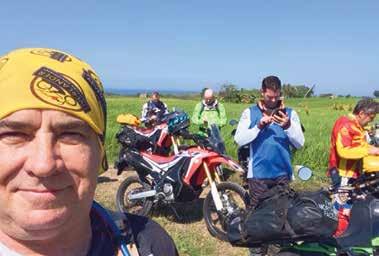
Above right: Once you’re away from the tourist spots…oh, the serenity!
Below left: A few Bintangs and a swim to lower core temperatures.
Below center: Criss-crossing the island from from the mountains to the beaches.
Below right: The obligatory full walk of Kuta.
suitcases for safe keeping. It was a hot day so a few more Bintangs were required to flush the system and a swim in the pool helped lower core temperatures. There was a flash restaurant across the road and after some overindulgence we paid the bill for the most expensive dinner we had on tour. An absolutely fantastic three-course meal with drinks delicately served by professional wait staff in amazing surroundings was just over 500,000 rupees each (AUD$50.00).
The Balinese really do know how to do it well.
The following morning we transferred for a night at the old Casa Padma and hooked up at Naughty Nurries for pig and beer with riders from the next week’s tour. We spent the day doing the obligatory full walk of Kuta, buying a few cheap trinkets and a nice lunch


GENUINE ACCESSORIES, DESIGNED & DEVELOPED IN CONJUNCTION WITH THE MOTORCYCLE FOR PERFECT PROTECTION, PERFORMANCE & FIT.

at my old favourite, Mama’s German Restaurant in the main drag of Jalan Legian. I walked past guys I had never seen to be told, “I know you from before,” and Bemo drivers asked if we would like some Viagra.
I declined on the Viagra as well as the offers of hash, but did pick up a pair of cool sunnies for $3.00 which lasted until I reached the airport. Then the lens fell out and broke.
Still the same Bali doesn’t change much really. I have a long history visiting the island and although someone has always found a new way for you to part with your money the people are much the same. Any bad behaviour from a local is usually bought on by some bad behaviour from a tourist.
AUD$800.00 will get five nights’ accommodation with breakfast, four days on tour riding most of each day, and a tour guide. We each kicked in $20.00 and that covered the fuel for the entire trip. We also paid for our lunches, dinner and road snacks. Add a cheap Air Asian flight – mine was crazy $230.00 – and I only withdrew a couple of million rupee ($200) for the week’s spending. My total was far less than $1500, and that included transport and a night at the Casa Padma. Where’s your next adventure?


THERE IS NO COMPARISON, GENUINE IS THE ONLY CHOICE WHEN IT COMES TO THE BEST FOR YOUR

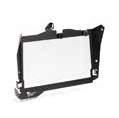


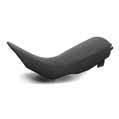


SHOP THE FULL RANGE ONLINE OR VISIT YOUR LOCAL YAMAHA DEALER

Adventure Rider Magazine first spoke to Scott Britnell waaaaay back in issue #06. Since then he’s kicked a goal or two, including entering and finishing his first Dakar in 2018.
First contact with Scott, 45, from the Southern Highlands of NSW, was a phone call out of the blue when he introduced himself, said he was planning to set a record for a double-crossing of Australia – Byron Bay/Steep Point/Byron Bay –and asking whether we might be interested in a story on the attempt. Of course we were.
We kicked off in issue #06 with a look at the KTM 690RFR he’d put together for the record-setting ride, a masterpiece of preparation.
For issue #08 we waited at the Byron Bay lighthouse as he rode in after doing the overland return crossing in just 173 hours and 50 minutes. He looked a lot fresher and less tired than we did on that occasion. Scott then thought he’d lead a tour or two overseas,

set a record for a solo ride the length of the Canning Stock Route, then saw the CSR record beaten so went back and did it again. You can read that story in issue #37.
He also entered and completed Dakar in the brutal Malle Moto class in January 2018.
When we found Scott floating around the NSW Congregation we leapt at the chance to find out more.
AdvR: One of the most daunting things for any privateer tackling Dakar is finance. How did you do it?
SB: For an average bloke, trying to put the money together for something like Dakar is hard work.
First, you can’t just get your hands on one of those bikes any day of the week. And once you find one, the cost of getting somewhere, to a minor rally in Europe or somewhere to actually get some experience on it, is expensive. I sucked up the cost and bought a bike in Australia, prepared it myself, and then went through the logistics of sending it back to Europe through a race team there. The team received it, got it through scrutineering and got it on the boat for Dakar, and then I met it in South America. I think my budget ended up being


about $140,000 to get a bike, get it over there and complete the race. My wife and I probably put in more than half of that ourselves, and for the rest we did some fund-raising initiatives.
AdvR: How did the fund raising go?
SB: The biggest challenge with anything like that is it just consumes so much time. All my efforts at fundraising would’ve been better spent knuckling down and doing extra hours of work, and just taking home a wage for extra time. The reward for effort on trying to run rides and that sort of thing as a novice is just too hard.
AdvR: You’re very strong on planning. How did you prepare for a Malle Moto run at Dakar?
SB: For starters, what was important to me was to have my hands on the bike and build it from scratch myself.
The KTM motto of being ‘ready to race’ is great, but you need to know about that bike for when it all goes to custard.
So I absorbed the extra cost of buying the bike in Australia, having it for six or eight months, and just did the little preventative-maintenance things… lock- wiring and so forth. I wanted the
comfort of knowing bolts couldn’t come undone or components work loose.
If I knew it couldn’t let me down during Dakar, I didn’t need to worry about carrying a spare.
So the preparation was important to me.
For somebody outside of the professional race industry, without a team behind you, it’s a minefield. Navigating through what you have to do to get a bike onto an aeroplane, with a carnet (a customs permit – ed), and going through logistics and freight and all that sort of stuff, was new territory for me. Fortunately, some of it I’d picked up because I had to go to the Middle East and do a couple of rallys to qualify for Dakar entry.
It’s a big learning curve, and rallys are a funny thing. There are a few people in Australia who’ve done rallys, Dakar included, but not many who are prepared to offer essential advice. I found it quite hard, and I was quite open about trying to get people on board. I’m happy to take advice from wherever, but it just wasn’t forthcoming.
It just made it that bit harder and a bit
more of a challenge.
AdvR: How tough was scrutineering?
SB: It’s not too bad.
There’s like a pre-scrutineering they do to simplify things in France before the bike goes on the boat, but most things with Dakar are set up for people who speak European languages, so the research can be testing. Most have someone in their country who runs a rally team to help them out. I countered that by sending the bike to a race team to give them an opportunity to fix what I hadn’t quite got right.
Fortunately, when you start with a piece of hardware that’s designed and built specifically for a race, it’s almost there. The tricky part was the wiring for all of the emergency and navigation equipment up front. That has to be spot on.
AdvR: Was there any crazy stuff forced on you to meet Dakar regulations?
could actually look at the ground and see how I was going to get my bike out of that shitty spot. There were bikes and cars ripping past, and you’ve kind of got that look of desperation on your face like, ‘Hey. How about you stop and give me hand?’ but it just doesn’t happen. You sit there, and you know that if they’re behind you they’re having just as much trouble as you, if not more.
Left: Sharing a well-earned Argentinian dinner with fellow competitor, Juan Rojo, and his family. Right: Scott after crossing the country and back in issue #08. u
SB: No. Everything made sense. The organisers know how challenging things are. There’s a redundancy system for the emergency communications, and that’s built in for safety.
When you analyse what they’re expecting you can see the relevance. The three litres of water are there for those guys I rode past sitting under their emergency space blanket trying to stay out of the sun. They needed the water on that day, or to get them through the night, before they could be picked up.
Your water, your emergency beacons… all that stuff is built in for a reason and you can tell.
AdvR: We know you to be mentally and physically tough. How hard is it in the Malle Moto class?
SB: There were a couple of days where it almost beat me.
It’s the combination of everything: the fatigue; the lack of sleep; having to do all the work yourself; missing out on food and showers just because your priority is your bike and having it ready; and your navigation gear. It just compounds day after day.
There were times where I sat down with my bike stuck in the dunes and it took me 20 minutes to get my composure. I needed some recovery time before I
Another thing is the terrain. Toby and the riders at the front are riding virgin terrain. There’s no tracks on it. They get to pick the line and ride at incredible speeds, and they’re amazing. But when you’re 50 to 100 riders back, the track is just pure carnage. If you crossed the Simpson Desert with a group of 20 and you were number 19, you’d already be riding as the 19th-fastest or slowest rider, and you’d have chopped-up terrain in front of you all day, every day. In Dakar you have 100 riders in front of you destroying the track, and you know the fast cars are going to get to you, so you’ve also got the worry of what’s coming from behind. The cars do all kinds of funky stuff to the track as well, once they’ve gone past. So it just gets worse.

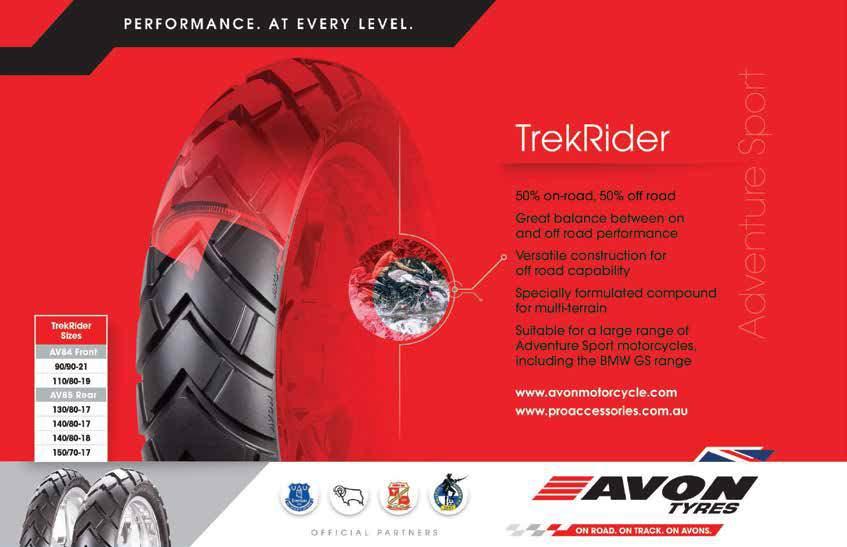
It’s not really something you can train for. All my training was done on my own, on tracks that weren’t being chopped up by 100 other riders, and that made it more challenging.
And you can’t ride the same lines as the frontrunners because you’re not carrying the same speed. You have to pick your own lines, and it’s basically a whole different track.
AdvR: It must’ve felt good when you finished.
SB: To be honest there was more disappointment from knowing that if some of the things hadn’t gone wrong, I could’ve done better. It’s just such a torturous event. In the Malle Moto class you’re riding to survive and to get to the finish line, and when I finished I went, “Thank Christ that’s over.” I knew I didn’t have to go through another year or two years of hard work just to get there and finish.
It took quite a while to decompress and get the stress out.
AdvR: You have a few successes to look back on now. There’s an across-Australia record, a couple of Canning Stock Route records, a few successful international rallys, and you’ve completed a Dakar. What’s next?
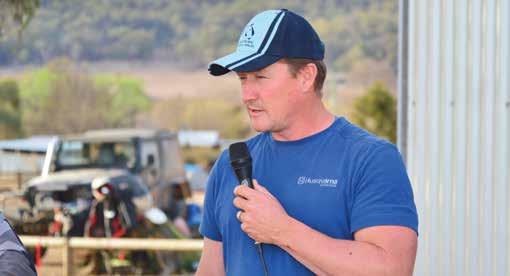
SB: It’s only been in the last month I’ve made a decision – well I think I’ve made a decision – on where to go from here, and it’s going to be back to Dakar.
The primary reason is it’s in a different country, a different part of the world. I don’t think I would’ve gone back if it was still in South America.
I’ve considered going to do the Africa Eco Race, and I’d considered the Silk Way Rally, which runs through Russia, Mongolia and China. The Silk Way Rally appeals to me, but I’m running a
Above: Scott held the Congregation enthralled with his stories from some of his incredible rides.
Below: Plenty of anxiety after such an effort to put it all together, getting to the start and just praying he can make it to the end.
Right: The post-race celebration. Typically, solo and unsupported. Also 11kg lighter than at the start line.
tour there next year anyway and I’ve been there a couple of times. It’s the kind of country I prefer to enjoy, not race through.


So that kind of brings me back to Dakar. I’ve still got the hardware in the shed from last time. It’s more than capable, so why not use it?
AdvR: What were the big lessons you learned from your first Dakar?
SB: Be fitter!
I won’t have altitude to worry about in Saudi Arabia compared to South America, but I’ll be fitter and more structured with my daily routine during the race.
Experience is a great thing. Having your box of tools and spare parts set out properly, and understanding priorities, is important: the bike is always the priority.
Fitness and self-preservation, and having a better daily routine, is the way to go, and self-preservation is somewhere I tend to fail. I let my energy levels go down because I’m focused on keeping the bike on track.
It’s such a long race, and it’s not something I appreciated until I had the experience of doing it the first time.
AdvR: Tell us more about the tours.
SB: I advertised on social media and got enough takers to put some bikes in a container to go do a three-week tour of Mongolia.
I ran a tour there two years ago. We took 12 guys over for two weeks and it’s a phenomenal part of the world. It’s very special for riding. It’s kind of built for adventure riding.
The tours are really an occasional opportunity to take people somewhere unique that I want to ride myself, not so much as a commercial venture to make a living from. I’d never get sick of riding Mongolia, but also have future plans elsewhere.
If only there were more hours in a day, days in a week and months in a year!

























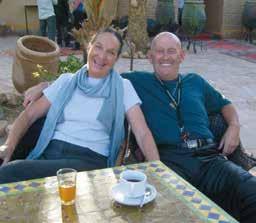
Main: Roselyn Jones had a great attitude to life. Below left: With Jim Henington in Morocco.
In more than 25 years leading rides all over the globe with World On Wheels, Mike Ferris has met some interesting people. Roselyn Jones was one very funny lady with a great attitude to life.
oz travelled with us for the first time with her husband Dick in 2002 on our Turkish Treasures tour. That was where they met Jim Henington. It was a great group with lots of fun people, but these three in particular, all in their early 60s, hit it off famously. Dick was a very good rider, but I’ll never forget the image of Roz on the back seat, bashing him about the head and shoulders after he ran wide on one corner and very nearly stamped them both at speed into an oncoming car.
road. There was a significant laceration to his neck but there was no blood loss. His heart had already stopped pumping. Roz was devastated at losing her lifelong partner and soulmate. Jim flew up from Sydney to Mackay to support her and was instrumental in helping her through a difficult period in her life. Not being a rider herself, Roz just kind of assumed the motorcycling dimension in her life was now also over, but Jim talked her into coming on a tour of Rajasthan with us in 2005 as a support-bus passenger, and then also to Morocco in 2009 where she more than once rode as a pillion behind Denise Ferris. Her joie de vivre had returned, and at 68 she often had the much younger troops in fits of laughter with her wacky personality.
Roz went on to subsequently travel with us again to Turkey in 2011 to celebrate her 70th birthday, and again to Rajasthan, and then to Iceland and most recently in 2018 to do the three Baltic States and western Russia with World On Wheels. But it was in Morocco she gave us a priceless moment.
In the coastal town of Essaouira, famous for its surfing and as a one-time home of Jimi Hendrix, Roz needed help on a shopping expedition for a new summer dress. She had brought too many heavy clothes and the climate in Morocco was very warm.
“Come on Jim, we need to go shopping,” she announced to the group in general. Jim, by now also in his 70s, had only just taken delivery of another cold beer, but manfully accepted the challenge and knocked it back in one swallow.
“Righto Roz, I’m good. Let’s go.”
They survived this near-miss and thoroughly enjoyed the rest of the tour, and Roz told us Dick was ready to sign up for all the other tours we did around the globe!
But a couple of weeks after returning to Mackay in north Queensland, Dick went out for a ride with some of his mates and unfortunately never made it back home. The coroner determined he’d probably suffered a heart attack and was already deceased by the time his bike ran off the
They scouted around a few shops and boutiques, but Roz couldn’t see anything immediately edifying. She was beginning to think it was a lost cause, but then Jim steered her down a narrow alleyway just off the main medina.
Through a large, glass-fronted shop she spotted something with potential. She wandered inside and the two young shop assistants registered her presence but paid no particular attention as she browsed the clothes hanging neatly in rows. In fact, she decided, they were ignoring her rather rudely as she selected one attractive dress and held it in front of her, posing and prancing in front of a mirror to see how it suited her.
“What about this one Jim?” she asked. Jim pursed his lips and gently shook his head. “Not your best colour, Roz.”
She put it back on the rack. The two Moroccan guys had not yet moved a muscle and were obviously very disinclined to engage. Finding another dress, Roz held it in front of her and looked at Jim for a second opinion.
“Yep. That’s much more your style,” he offered.
The shop assistants had still not shifted from their seats.
Eventually she rounded on them and said, rather shortly, “Excuse me. I like this one. Can you tell me how much this is, please?”
Finally, one of the lads shifted from his backside and wandered slowly over to where Roz was standing. With infinite patience he pointed to the sign in the shop window and said, “Lady, I am sorry. This is dry-cleaning shop.”


Magic is one of the tours in the World On Wheels portfolio. Check out the website at www.WorldOnWheels.tours





What to do on a special day? For Marty Blake the choice was easy: ride, clock up some kilometres and not really worry too much about the destination.

The idea was to tag along west with some lucky mongrels heading into the desert, see them on their way from Narrabri, then skip through some Pilliga bush and come back over Mt Kaputar and back to the work which prevented me joining the desert trip in the first place.
The departure was set for the Father’s Day weekend, and that proved a challenge with other riders. Feeble excuses like, “I’m going riding in the Himalayas,” the ever reliable, “I fell off my bike and I’m a bit sore,” to the unbelievable, “Work commitments,” meant it wasn’t easy to find a riding companion.
Fortunately, Darren was keen and only requested a few minor changes to my intended route…like a different direction – south, not west.
“Show me some tracks I wouldn’t know around Wauchope,” he sort of chuckled.
I wondered if he was still angry. The first time he rode with me on an enduro bike years ago I took him on my favourite loop. It was super-tight, endless
single track with a steep, slippery-clay mountain section. He reckoned I was being mean because I thought he was a Queenslander and had taken him on a torture loop. The truth was I took everyone new on that loop.
Most never came back for a second ride, but Darren did.
B
So Wingham it was, via some old favourites off Dualsport Australia’s first disc and some converted Google Maps sections which were new to me.
With multiple options to come home I was hoping for some rain beforehand to lay the dust.
My DR650 was prepped, fuelled and loaded, (embarrassingly easy on a DR) a few days early.
As Darren had a DR650 too I figured he would be the same, but finally late Friday night he rang all happy to say he and his DRZ400 were ready and I should remember he would lead around Wauchope.
Early bird gets the loam
It rained a few days before, but the morning was bright and clear as we departed.
The usually dry trails behind Macksville felt almost loamy as we followed the coastal ranges, launching off the abundant large, steep, erosion mounds…well one of us launched, anyway. Bloody DRZs.
From a quick refuel at Willawarrin we swept over the Macleay River, and it was a shock to find it not running at the Toorooka bridge. The photogenic causeway just up the road was dotted with lime-green puddles, but Willi Willi was firm, fast and not only dust-free, but all the ’roos and cattle stayed in position as we went past.
Even with all the times I’d ridden that section over many years, I was hard put to remember a better run through there.

The undulating farmland gave way to forest as we climbed. The roads became narrower and rougher underneath a dark rainforest canopy with the odd, still-slippery clay corner. Then, with heaps of extra rocks, Racecourse Trail became rougher and led to the flowing dippers up the edge of the New England Highway. It was super fun as we took turns leading.
With my number-one, near-miss ’roo road just in front of us I thoughtfully suggested Darren lead. He was onto it in a flash. He’d hit a ’roo on the road himself and politely declined.
I hated leading through there so I pulled off to get some photos a couple of kilometres in and chuckled to myself as I watched Darren ride past. The self-congratulation stopped when he slowed and waved me back to the lead soon after.
Over the next hill I was almost jumped on by a dark, almost-black, ninja ’roo, and some manoeuvring on my part had Darren once again in the lead.
This soon became a slow race, with both of us saying, “After-you,” “No. I insist. After-you.” Gingers Creek beckoned and the temperature fell as the Oxley Highway came into view. Dark clouds loomed ominously to the south.
The rainclouds closed in as bikes and bellies were refuelled at the alwaysfriendly Gingers Creek roadhouse.
Following the Google Maps line I’d prepared we set off on a grassy, fern-lined twin track and jumped onto Enfield Road. The GPS wanted to cut the corner where a track had once been, and shortly after we pulled the pin and rode 500m up the road to re-join the GPS track line.
The next detour was a small, leafy trail which hadn’t had any obvious use. The GPS insisted and it looked interesting, so we dropped down, darted in and found ourselves staring at a washout and ‘road closed’ sign. There was room to get a bike past so we pushed on, but the other side deteriorated into a litter-strewn snig track. It felt all wrong but the GPS said it was right, so with first and second getting a workout we bashed our way back onto Enfield Road only a few kilometres further down.
That was the Google shortcut. Let’s not mention it again.
The speed picked up back on Enfield

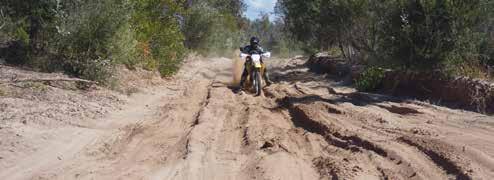
Road, and as we followed the timbered ridge it started raining, so Darren stopped to put on a rain jacket.
A few minutes later the bright sunshine and great views proved irresistible so we stopped for photos and Darren took off his jacket. Shortly after that it started raining again and the jacket went back on. Sure enough, it almost straight away stopped raining, but this time he refused to remove the jacket as we wound down tight, winding forest road and followed grassy ridges onto Nowendoc Road.
We could see it raining ahead, but it was dry by the time we got there. There was water running down the road, but all we saw was a bit of mist.
Still, we agreed to be impressed with Darren’s jacket.
We rolled into Taree on time and settled on the cabin veranda to swap ride stories until gourmet pizza was delivered. That stopped the talking until every last scrap had been devoured and then we debated the options for the homeward leg.
Steady rain overnight and in the morning revealed all but the coastal run shrouded in dark rainclouds. Darren refused to wear the rain jacket all day, so our route was picked for us.
As we slithered over Middle Brother’s clay section up to the impressive view at the tower all was good in the world. After some nice, dark, rainforest sections and a small running creek we headed west back into the forest past the impeccably maintained Swans Crossing campground. We skirted the edge of the forest following an escarpment and eventually stopped to enjoy the breathtaking view from Bago Bluff above Wauchope.
Following a few gasps of admiration we left the view with Darren in the lead, almost too cheerfully promising new trails.
The route was new, but ‘trail’ was pushing it. It was a single line with abundant rock steps on big hill climbs, plunging downhills and almost completely hidden old trails. The look on a group of two-stroke riders said it all. They probably don’t see too many bigtanked DR650s with luggage in there.
‘This is great, Darren,’ I thought inside my steaming helmet. ‘Get us out of here.’
A new dam and a big log spoiled Darren’s new trails, so we crossed back onto my route until we hit the servo near Port Macquarie where the Oxley and Pacific Highways meet.

top: Point Plumber Road near Port Macquarie was in good nick and offered a sandy blast. Darren wasn’t stopping for anything.
Left main: The rainforest run on Middle Brother was a bit slippery. Above: It was good to find a creek to splash in.
After lunch Darren’s DRZ refused to start. It eventually fired up after being push-started in the carpark, but it clearly wasn’t happy, missing and running rough. We fuelled up, crossed the ferry and headed for the sand tracks with crossed fingers, hoping the DRZ wouldn’t stop in the deep, loose sand.
Not even a Jeep full of bikini girls parked on the side of the track was enough to stop Darren once he got going. He roared past them and kept roaring past me and my camera. I eventually caught him parked on a headland overlooking the beach and facing downhill.
took over the lead. Everyone knows the Port-Crescent Head track, but the link to Hat Head further down the coast is harder to find. It’s tight with sandhills and requires commitment. It’s also excellent fun on small bikes. As the front of the DR tried to tuck the rear churned on through with a big handful of revs. The DRZ made it through no worries.
A tar transport headed back into the forest before crossing the highway and climbing the steeper southern side of Mt Yarrahapinni to roll out near Macksville. An 850km loop completed by just after 3.00pm meant Darren had every chance to be home on time.
cruised a few kilometres down the road and dropped in to see my daughter and granddaughters, hearing and seeing all that was new in their young lives. A little later I pulled up 50m short of home at my son’s house on the family farm and wandered in for a couple of bourbons.
This Father’s Day ride thing could become a tradition. Next time I’ll take my son as well.


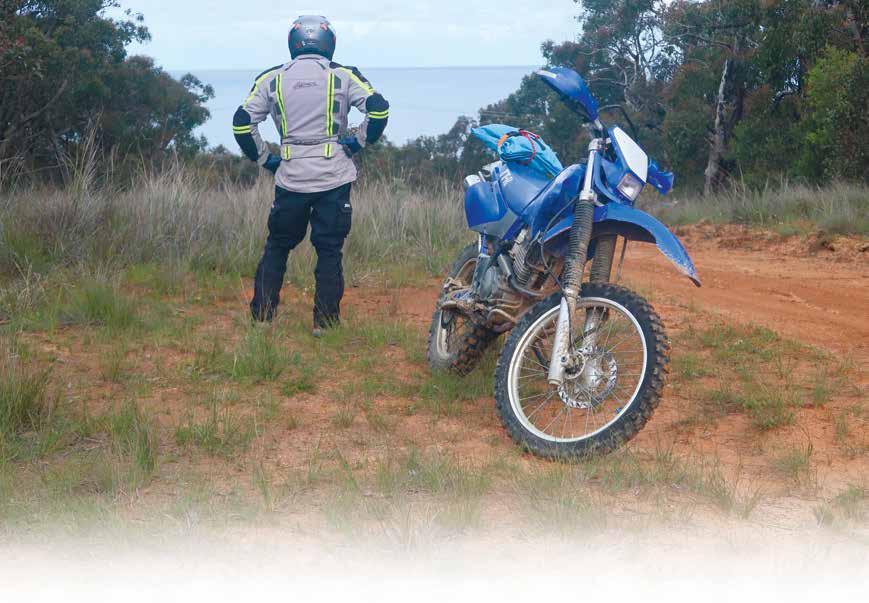
The Great Otway National Park and Otway Ranges –‘The Otways’ – are a Victorian forestry wonderland offering any amount of riding adventures mixed with remnants of bygone sawmilling days. Graeme Sedgwick took his TTR250 for a look-see.
Ishifted down to a more prudent gear as the track began to grease up thanks to some gentle rain. I wondered if I’d made the right decision in taking my TTR250, ‘The Old Blue Banger’, into The Otways for some therapy.

Fortunately, the further I progressed the more enchanted I became with the glistening landscape of ferns and tall timber. My ambition was to take as many interconnecting southwesterly tracks as I could find to immerse myself in some of The Otways’ best.
Located approximately 160km southwest of Melbourne, The Otways sprawl across more than 100,000 hectares bordering Bass Strait to the south and, arguably, some of Victoria’s best grazing country to the north. The Great Ocean Road weaves back and forth alongside the Great Otway National Park and range, and, attracting more than 2.7 million
visitors means The Otways are a popular tourist destination for those looking to get close to nature.
Complemented by peaceful watering holes like The Brewery at Forrest and The Beechy Hotel along the way, there are some stunning gaps between trees to catch views out over the blue stuff that separates the Aussie mainland from Tasmania.
On board my old, radiatorless, electric-start TTR250 – or on any adventure bike – Otway riding is jam-packed with all sorts of short and long adventure options.
Stick it out
On the map it all appeared fuss-free.
Once on the trail some of the more obscure passages I’d chosen presented more technical twists and climbs than I’d bargained for, and by my measure, some kamikaze downhills.
But the commitment had been made. I told myself,

facebook.com/uralaustralia
instagram.com/uralaustralia

‘Nothing worthwhile comes easily!’ and ‘The familiar can dilute an adventure’s flavour!’
I was determined.
Keenly aware there are no prizes for overestimating one’s abilities, especially on a solo ride in country that can demand every ounce of a rider’s energy and ability, the objective was simple: stick to the plan I’d outlined to others. I had a PLB, mobile phone, small tent and munchie pack aboard.
Thankfully, The Otways is a well mapped area, so there are plenty of accurate
reference points and get-out-oftrouble options.
Rain is one of the biggest influences in the region, with localities such as Tanybryn and Weeaproinah recording some of the State’s highest falls – over 1900mm annually. That means The Otways’ environment can, in a blink, turn tracks into bobsled runs.
Mindful of this, and in view of the patchy clouds above, I took a cross-country route via more navigable forestry tracks to a point above Webster Hill Plantation, southeast of Gellibrand and north of Olangolah, smack in the middle of The Otways. Along the way there were opportunities to discover any number of overgrown sawmill sites scattered throughout the area. Sites such as Henry’s Mill and a settlement which existed along the West Barwon River, together with what remains of a tramway formation and tunnel. Knott’s Mill was another vague memory of bygone years, and

Top left: Lardners Track is a blast, with views between bends and any number of short straights. Above: The Otways’ environment can, in a blink, turn tracks into bobsled runs.
Left: More navigable forestry tracks around Webster Hill Plantation.
so were the remains of concrete-machinery foundations close to Wait-A-While Road and Phillips Track at Wyelangta.
Sawmilling during those halcyon days supplied a variety of timbers to places like Colac, Geelong, Hamilton, and the Ballarat and the Creswick gold fields.
I eventually hit Asplin Creek Road and ran southward into Webster Hill Plantation’s less-trafficked, mudspattering trails toward Lardners Track. Hard-packed and with plenty of ball-bearing patches – in contrast to Webster’s loamy, puddled, clay-surfaced passages – Lardners Track is a blast by comparison. Its wider views between bends, with any number of short straights, made the run to Olangolah a hoot.
I was ever alert for oncoming traffic, even though it was remote country. There’s always a chance of oncoming
traffic, even though it’s less likely midweek.
With Webster Hill Plantation behind me the furthest destination of my plan loomed: Aire Valley Plantation.
Bursting with enthusiasm and under more blue sky than I’d seen all day, the timing couldn’t have been better.
South from Beech Forest down Old Coach Road was the ticket, over the bridge crossing the Aire River. I veered left onto Horse Paddock Road and followed a swinging, high, line around the valley’s contours, revealing many vistas and rewarding me for all the slogging it took to get there.
The Old Blue Banger, like its rider, was completely engaged.
Switchbacks and hairpins made Satin Box Road an almost never-ending twister that climbed to a junction which offered tracks named Midway, Seaview and Aire Road.
There was no need to choose. I rode them all.
The Aire Valley Plantations exist due to the efforts of post-war refugees. These hardy people lived and worked in Forest Commission camps of Stanley huts adjacent to where redwood plantations were established as a trial in 1936. The camps were particularly important in an era before a State Forest road network was established, and before reliable vehicle transport made daily commuting to nearby towns a viable proposition. The unemployment relief camps provided an important pool of labour, and by the mid 1930s the Forest Commission employed almost 9000 men. Depending on the nature and use of the forest camp, workers could be accommodated for periods of several days, weeks or months. In the refugee camps, it could even be years.

The bulk of the Aire Valley’s planting work was done by post-war immigrants and refugees from Lithuania, Latvia, Estonia, Poland, Czechoslovakia and Yugoslavia. The first arrival of ‘Balts’ – as they became known – camped for up to two years before construction of an all-weather road network by the Forest Commission in the 1950s. That led to the closure of the Aire Valley Plantation Camp. The redwoods are still there to be enjoyed and offer a peaceful and awe-inspiring picnic site or rest stop.
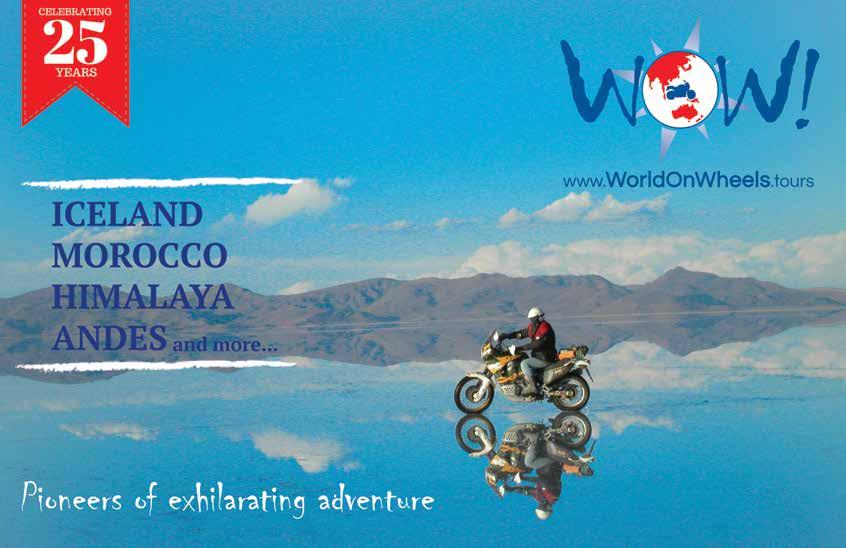







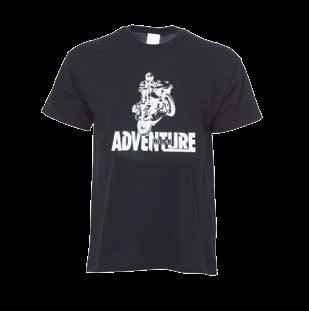






In its 12th year the KLR Riders’ Rally headed to the idyllic seaside village of Iluka on the north coast of NSW.
After some seriously tough destinations over the past couple of years, the annual rally for owners of Kawasaki’s hard-working adventure mount headed to a more gentle and scenic location for 2019.
In 2017 the editor and Mac Attack made their way through kangaroos and flat tyres to join the throng at Tottenham, the geographic centre of NSW. Last year,

2018, had everyone charging to Stonehenge in outback Queensland, and Mac Attack Eggins filed the report for issue #32.
In 2019 Iluka was a mere 48 minutes from Mac’s front door near sunny Grafton, and only a couple of lazy hours ride for the editor.
Still, the pair manned up and made their separate ways to the quiet village on the mouth of the Clarence River to once again talk about, and look at, the good ol’ KLR.
Organised through the KLR Riders Facebook page, the site of the annual rally is decided in a very democratic process. The attendees at each rally suggest, then vote on, the destination for the following year. It’s a system that’s been working well, and this year there was something of a ‘passing of the baton’. Taking over from Jared Smith, Brisbane’s Richard Bell, a long-time stalwart of the Facebook page and devoted KLR owner and rider, jumped in to make it happen.
As Adventure Rider Magazine wandered through the well-ordered campsite it was impossible to ignore the calm, relaxed atmosphere. With a string of Kawasakis in their own designated area, and small groups of quietly yarning riders wandering through the waterside campground, it was a very pleasant place to be.
An area set aside in the Iluka campground for the 15 KLRs and couple of ring-ins.
2020 vision
Over a quiet and orderly dinner some suggestions were made and a vote held, and next year, 2020, the rally will head to Hungerford, in southwest Queensland, on the June long weekend. Mac has already ordered half-adozen joining links and the editor some spare tubes, and the pair plan to run out to the desert destination if the opportunity presents.
If you’d like to be part of a keen and supportive group of adventure riders, search ‘KLR Riders Australia’ on Facebook, join up, and watch it all take shape.
Hopefully we’ll see you there.
Right & below: Lee Saunders and Tom King from Emerald in Queensland were the riders who rode furthest to get to Iluka. “We didn’t plan anything,” the lads explained, “we just looked at the map, found a road, and ended up doing something 1500km over three days.”
Tom fell off a ladder and hit a Colorbond fence just before departure, leaving him with a running repair to his throttle hand.
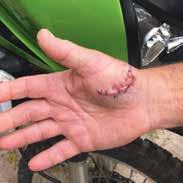

Although it’s a ride for KLR owners, there’s some latitude allowed.
Anyone who’s attended a KLRRR on a KLR is welcome to attend any future event on any bike of choice. In 2019 Adventure Rider Magazine’s editor showed up on an unlikely Harley lookalike, saying, “It was a road ride to get here for me, so…”
There were a couple of other riders on different brands, too…
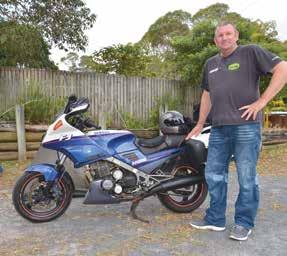
Organiser Richard Bell (above) arrived on his much-loved Yamaha FJ1200.
“My son rode my KLR,” explained Richard. “It’s his first rally, so he had to come on the KLR. He had a KLR and sold it, and I’m pretty sure he’s going to buy another one.”
Father and son riding together must be one of life’s great experiences.
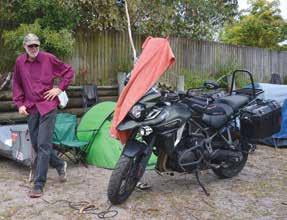
Peter Anderson (above), from Kyogle, showed up on his Triumph explorer. “I went about 100m, tried to change into second gear at the end of my driveway, and it locked up solid. There was a horrible crunching noise, so I turned around and swapped bikes.” Ew. ‘A horrible crunching noise’. Ew.


Below: It can’t get much better, can it?

What a season!
Seriously, it was bloody awesome.
Being a tour guide for Cape York Motorcycle Adventures, living half the year on a bike riding through tropical far north Queensland…it can’t get much better, can it?
The short answer is, “No. Not really.”
I’m sure glad hassled the old boy for a motorbike as a young tacker. He brought me one, the legend he is, and supported my riding above and beyond. Now I’m getting paid to ride. Ahhh…I love it.
I’ve still got my first bike too, a 1970s model Yamaha MX80. What a little beast it is.
We’ve just finished off our final Cape York trip for the season, and I absolutely loved it. But I’m a little sad at the same time, because I don’t want it to end just yet.
But hey. I’ll be back!
Some time off will be good. I’ll head home to Tassie to see the family, jump back on the tools and do some welding for a while. It won’t be for too long and I’m already itching to get back up here for the next season.
Philip Warring is the man!
AKA ‘PhlipVids’, we had Phil on one of our seven-day
Main left:The boys couldn’t believe how good it got.
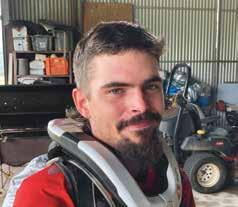
Cape York trips to do some camera work. Man! He is full of enthusiasm and energy for his work. He didn’t miss a thing, creating a promo video for CYMA to show the world what we’re all about. You’d have seen bits and pieces on the Adventure Rider Magazine Facebook page.
The weird thing is, don’t think I saw him without a camera in his hands for the whole trip. Maybe the camera is a part of his body? It seemed that way, and he did create some magic in the end. Click on this link to see it:
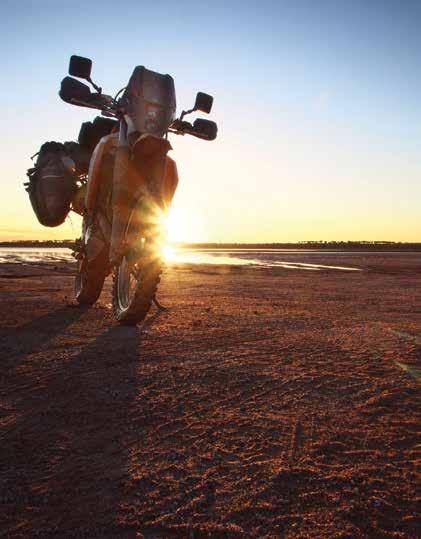
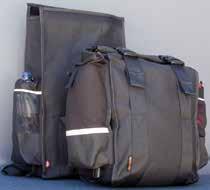
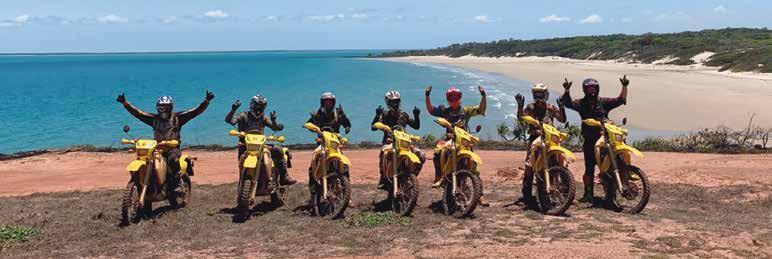
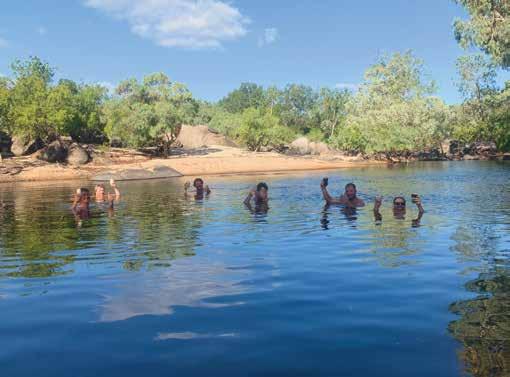

www.capeyorkmotorcycles.com.au.
That’s probably not going to work out of a magazine, eh? You might have to punch it into your phone or jump onto the CYMA Facebook page. Readers with an electronic subscription will be right, though.
Either way, get on and get an insight into what we do. It honestly gives me goosebumps watching it…and it’s a quick reminder how lucky I am to be doing this!
Phil is a genuine dude, too, with a genuine passion for what he does. Good on you, mate! It was a pleasure having you on board.
You need protective gear when riding dirt bikes, and for some, sometimes, it may just be a dress.
With a wild bunch of Tassie boys on board for a seven-day Cape trip, anyone who fell was told, well, “Chuck the dress on, mate.”
Soon enough it wasn’t just the dress. While travelling through the Old Tele Track a quite large set of pink knickers were found, so under the dress they went! We spent the night on the track at Bertie Creek, kicking back in the swimming hole, having a cold beer, and the boys couldn’t believe how good it got. The dress got another run the next morning going through Gunshot Creek. I boosted Zac up a tree so he could get a bra someone had hung up. So there they were, getting in and out of the girly kit every time they hit the dirt. It was a bloody good laugh.

It’s been mainly seven-day Cape trips throughout this season, but we recently snuck in a two-day tour and it was a blast. Up through the CREB Track we toiled, and then crossed the Meg River. Once the bikes were across, well, it was time to turn around and jump in. What a perfect way to cool off and rinse the riding gear.
A stay at the classic Lions Den Hotel near Cooktown, where the beer is always cold and the food is awesome, made for a great overnighter, and after bacon and eggs in the morning we were away again, heading back south. We pulled into Weary Bay and the boys battled their way down the beach to the mouth of the Bloomfield River, which is not a bad spot.
A quick stop at Roaring Meg Falls was a necessity. Everyone loves a good waterfall, right?
From there we jumped onto the Bloomfield Track, through Cape Tribulation, went for a ride aboard the Daintree ferry, and enjoyed a nice cruise along the coast into Cairns.
It doesn’t sound like a bad way to enjoy only two days, hey?
Why don’t you take a couple days off work or chuck a sickie even?
It’s worth it!
We love The Cape so much we even go back up in our time off.
The season is over for the bikes but we aren’t done with The Cape just yet.
Roy’s got a fishing trip on with a good mate, Graham, and I’m loading up the ute with fishing gear and a tinny to drive support.
But the best thing I’m packing this trip is my darling partner, Jessica. It’s time to show her around the office.
It’s a bloody big office, Cape York.
Then the almighty drive back to Tassie for the off season, which will be summer.
You beauty.




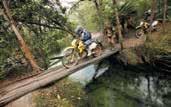




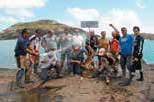
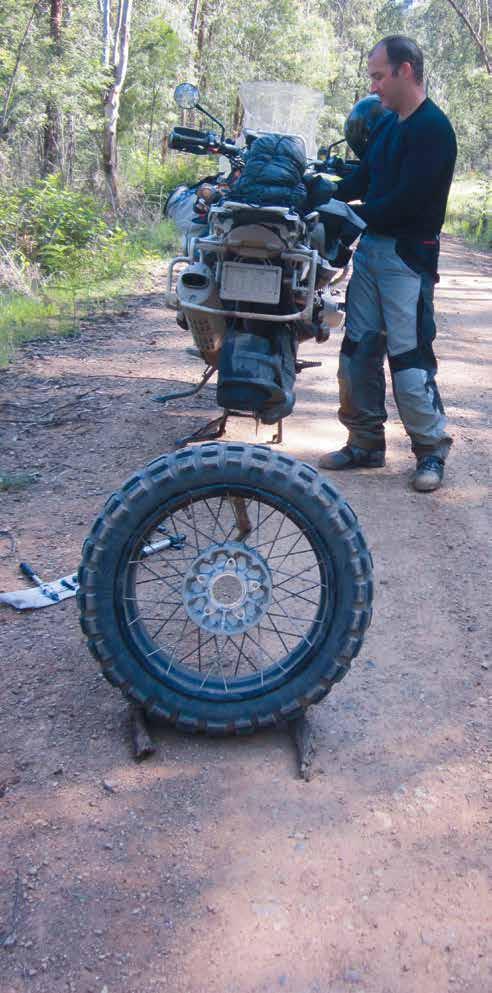
Miles gives tyre repair a plug.
Ihave probably ridden a conservative 10,000km per year for the last 19 years, so next year I should hit the big 200K. I’ve had some amazing rides, seen some incredible places and met some great people, and I feel pretty blessed for all of this.
Most of the kilometres have been on GS boxer twins, from 1150s to 1200s and now 1250 models, and they all run a tubeless-tyre system as standard.
In all of those kilometres I’ve probably had between 30 and 40 punctures, and repaired another 30 or 40 for other people. Guess how many times I have had to remove a wheel to fix a flat?
The answer is ‘once’.
It sounds pretty amazing, but it’s true.
Of all of the punctures I’ve had, only one had cut the tyre so badly I couldn’t complete the repair with a plug, or on the odd occasion with two or three plugs. The one time I needed to fit a tube was on the 2015 GS Safari, on the morning of the first day, departing Jenolan Caves with a brand-new tyre. It went down almost instantly. I stopped, put the bike on the centrestand and saw the cut. I tried to plug it with a couple of plugs but soon realised it was a tube job. I can fix a flat on a tubed tyre pretty quickly. I can fit a
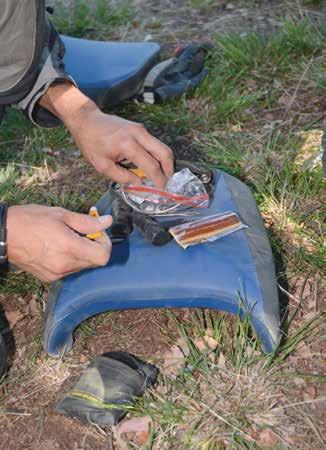
new rear tyre in the 15-minute work period at an enduro. In recent years I’ve been running mousse tubes on my enduro bike, and I fit these myself and for mates.
During GS Safari recces I always carry a spare tube in case of a slashed tyre in the middle of nowhere. I’ve had punctures on recces, and I’ve always been able to plug them, but I’ll continue carrying a tube because you never know when you’re going to need one.
The normal scenario looks something like this: I’m cruising along loving life, then I notice a warning light on my dash RDC (the German acronym for ‘tyre pressure control’) and my tyre pressure showing something like 35psi/29psi. This shows me my front tyre is at 35 and my rear has dropped from between 35psi and 40psi down to 29psi. Generally, if it’s a slow leak, I won’t have noticed a change in performance or feel, but it’s nice to get a heads up before I do notice.
Step 1
There’s no major stress. normally keep an eye on the numbers to get an idea of how quickly pressure is dropping. Sometimes it’s dropping quite rapidly. Other times it’s holding pressure and only dropping a very small amount every 10 or 20 minutes. Once I know the situation I plan where to do the repair. If I’m remote and hot I’ll look for a tree or shaded area. Other times I figure if it will hold until I come into the next town and maybe pull up at a servo.
Step 2
Pull up and put the bike onto the centre stand.
Make sure you leave your ignition on, as the RDC readings are very handy during the repair. You can monitor pressure loss and then use the dash as a gauge when reinflating the tyre. If you turn off the ignition you lose the pressure display, and if you turn the ignition on again you get blank readings until the tyres rotate.
Only once or twice have I had a flat on my Rallye X with no centrestand. This just makes it a bit trickier to find the flat. The bike has to be propped on a log or some other support.
With the bike on the centrestand, select neutral and spin the wheel to see if there’s
a foreign object – a screw, nail or something else – visible. This is the best option as you don’t have to search for what might be a small hole where you may need to pour water over the tyre and look for bubbles. Generally you can locate the puncture easily, but not always.
Step 3
Maybe you’ll have someone with you who is already pulling out a tubeless repair kit, or compressor, or both. If the hole is losing air quickly you can get

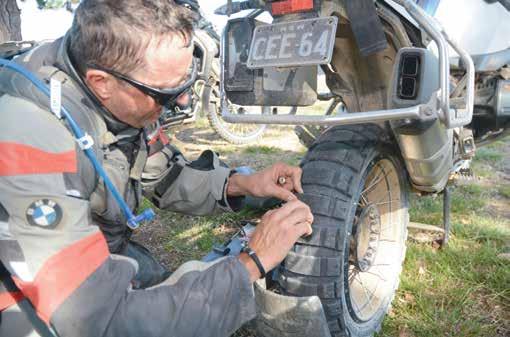


someone to simply put their finger on the hole while you’re getting ready.
Use the reaming tool to roughen up and clean the hole. Sometimes it’s very difficult to even get the reaming tool into the hole. Other times not, so you quickly know what size puncture you’re dealing with. I always travel with the basic BMW tubeless repair kit which has quite chunky circular plugs great for a bigger hole or cut. I also travel with basic tubeless repair liquorice-string plugs as these are great for smaller holes from nails and wire.
Load the desired plug onto the installation tool (which in many cases is also the reaming tool) and apply some glue to the tip and plug. This will help lube the plug for easier installation and assist with sealing the hole.
Step 4: plug away
Push the tool loaded with the plug into the hole so the tip goes at least five millimetres into the carcass. For smaller, chunky plugs, make sure you don’t push it all the way in. For string, it’s easier to manage as there’s more excess hanging out of the tyre.
Step 5: remove the tool
The design of the tool is such that it pushes the plug into the tyre, then leaves
it there when you pull the tool out.
It’s quite simple and surprising for some, but the plug stays in place.
Step 6: evaluate
If your tyre still has pressure, and it generally will, check to see if the hole is sealed.
Look, listen, feel (like first aid for your bike). If it’s lost pressure, start reinflation via a pump, C02 bottle or compressor. Simply spitting on your finger and swiping the plugged area should give you an idea if it has sealed, but keep an eye on your dash if you have a pressure display.
Step 7: pump it up
You can start adding air even before you’re sure the hole is sealed.
Sometimes after the repair I actually overinflate by a few PSI as every now and then the tyre may slowly keep losing pressure.
Step 8: re-evaluate
By the time you have the tyre back up to pressure you may have a better idea if the plug has sealed the hole completely. Sometimes you may still have a very small leak from one edge of the plug. In this instance simply add another, probably a string, unless it’s a big hole
and it may need two or three plugs to get it to seal.
Step 9: pack up and ride
I generally have good luck with the repair first time round.
You can trim the excess plug hanging out of the tyre, but don’t try to cut it too flush. A bit of excess is fine.
Keep an eye on your pressure and if it still has a slow leak you need to decide if you should go through the process again, or maybe you can make it to your overnight stop.
On a good day, with a basic puncture and a good nurse by my side can have a repair done in less than five minutes. No wheel removal, no tyre levers, no tubes and no scratched rims.
So ask me do I like tubeless tyres on my adventure bikes?
Shit, yeah!
Flat refusal
In recent years I have heard people say, “If you want to come on my ride you need to put tubes into your GS.” And I know that some tour operators insist riders of tubeless bikes fit tubes. When I heard this I was quite miffed. Why would you want to put a tube into a tubeless tyre? That means that for every single puncture you receive, it’s wheel out, tyre levers, tubes and all the rest.
I’ve tried to think of possible reasons this rule may be put in place, and I’ve even asked people, but I haven’t received a definitive, clear answer.
These are some reasons why I think someone may give this advice:
v They’ve never used tubeless so they don’t know the benefits
v Maybe there are some tubeless wheels that don’t work as well as those I’ve used.
I do know some tyres are not designed to run tubeless, and some cheaper brands do lose pressure at the bead
v They heard or saw someone riding tubeless hit something hard and burp air out of their tyres – usually the front – which required reinflation. Maybe the rider was running too low a pressure, or maybe it was correct pressure with a major impact. No wheel removal to
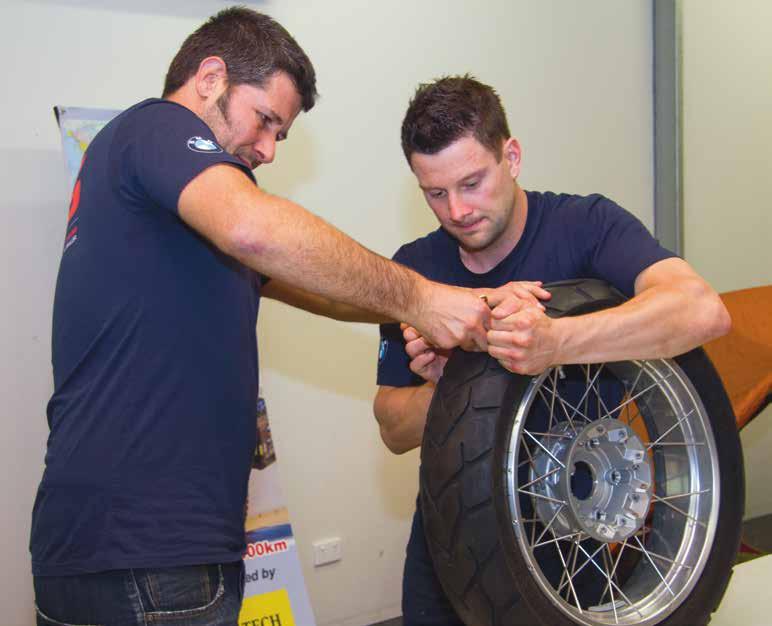
reinflate tyre, so no major issue
v They heard or saw someone riding tubeless hit something hard and damage the rim which lost air and couldn’t be reinflated due to the flat spot on the rim. Maybe the rider was running too low a pressure or it was a technique or line selection issue. Regardless, if they had a tube fitted they probably would have had the same impact, same rim damage and had a pinched tube to replace. So in this case there was no disadvantage to running tubeless. Both examples require wheel removal to repair.
Over the years I’ve seen riders damaging front wheels and/or regularly getting flat tyres. In my almost 200,000km of riding I’ve never lost air pressure from an impact or destroyed a front wheel. I definitely can’t say I’ve never added some character
to a front wheel, but nothing that needed to be repaired or replaced.
I do hit things hard from time to time, but my tyre pressure is up and I do try to ride light on the bike, pick good lines and soak up impacts, rather than bulldoze through them. This is adventure riding, so that sort of approach is the best way to look after you and your bike.
The only time I’ve done something whacky to a bike set up was when I raced Finke in 2017 on the 1200GS Rallye X.
I was worried about front-wheel damage and I didn’t want to run 35psi in the sand and bulldust, but I knew lower pressure would possibly cause burped air or risk rim damage. A tube wasn’t a better option as a pinch flat would be a likely outcome at a lower pressure.
I’d been using mousse tubes on my
enduro bike so thought a 19-inch rear motocross mousse might fit into the front 19-inch GS wheel. I was excited and nervous when the mousse arrived at work. I enlisted two helpers and we gave it a go. After a few tries I was getting close to giving up. The lads said, “Come on. One more try.”
I thought the tyre bead was going to let go, but finally we got the Pirelli Scorpion Rally fitted. I only used that front wheel for the race and the Simpson crossing straight after the event. Without that set up I’m sure Finke would have been a lot harder to complete as rim damage and/or flats would’ve been a massive risk. If your bike is set up for tubeless, maybe you should try it to see how it works for you. Carry a tubeless repair kit as well as a spare tube and tyre levers as a backup. Keep your pressures up and ride smooth!

Tyres used to make me indecisive. Nowadays I’m just not sure. Ask some advice in the front bar regarding adventure tyres and you’d best have a couple of hours to spare. Hooley dooley. The choice is so broad now I’m like a dog with three dinners: I just don’t know which to choose. Trying to think about the proportion of dirt and blacktop doesn’t help. It’s like asking me to set out my meal plan for the next six weeks. How the truck should I know? I’m a free spirit, a motorcyclist, looking for adventure and whatever comes my way ’n’ all that. I don’t see a situation where I might get to a corner and decide my wheels just aren’t dressed for it.
In fact, the more I think about it, I find myself in that situation regularly.
Actually, it’s not so much a decision as a rapid realisation…‘Ohhhh SHIT! I smell Dettol!’
Maybe when my Lotto numbers come in I’ll be able to afford two sets of wheels for each bike. But I can’t carry ’em with me, so I’ll need a mobile servant with spanners.
On a recent ride with a bloke who’s been putting up with me for 30 years or more we rode around in decreasing Gippsland circles chasing a true dualsport ride. Great winding roads were joined up by interesting gravel backroads in a tortuous route.

Maybe 10km or 20km of dirt, then 10km or 20km of blacktop and back onto dirt. Two days of this was a joy. Tomaselli and I rode on the same ribbon of tar two or three bike lengths apart as one and have done for years. Flipping from road to dirt riding techniques every 20 minutes or so was totally absorbing.
Tyres with a more road-biased tread pattern certainly were better than having dirt-friendly hoops on that ride, but we did have a few errr…moments, on some of the damper or deep-gravel dirt sections.
Each-way bet
When I sit down and do some rudimentary maths I realise I spend far more time on the blacktop than dirt. Like most city dwellers I have an hour of Tin-top Targa then the freeway drone to knock over before the wheels get grubby. Much of the time I’m happy to put up with a degree of rumbling from the rim savers to get some dirt-friendly performance ‘when I arrive’ (to quote Vale). If I chose tyres on the actual proportion of road-versus-dirt I actually do, I’d have very road-biased hoops each time. Therein lies the rub, yon riders of adventurous spirit. I choose tyres on what I hope they will do for the majority of the time want to play. When I start to mix in the mileage (it sounds so much better than kilometreage) I need from a set of rubber my brain hurts. Bugger it. A 50/50 tyre will do and I’ll ride it like I’ve got two necks! If they’re not right at least they’ll wear out and I can get a different sort next time.


Top right: An aggressive knobby is great for the dirt, but there’s usually a lot of road riding to get to and from the good stuff.
Above: Tube or tubeless?
Another option to ponder.
Right: Is this a 50/50 tyre?


Do you know for sure what’s the best adventure tyre? Share your wisdom. Email your carefully researched opinions to : tom@maynemedia.com.au and we’ll make sure Andy knows your thoughts.


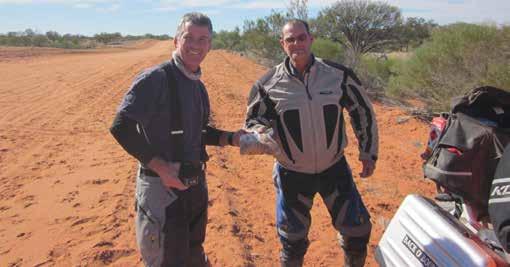
ood for adventure riders is always an interesting topic. A lot of times if you ask people what they eat when they’re out riding for a few days, pubs and cafes feature heavily. Some trips husband Dave and I seem like we’re just on a coffee-and-cake binge (well, he does ride a BMW). Other times we’re completely self-sufficient, just topping up the supplies to do our own catering. Now, by no means am I an expert here, but perhaps I might give you an idea or two.
We haven’t gone down the path of dehydrated or vacuum-packed food. Apparently, the notion that breakfast is the most important meal of the day is a myth started by a cereal company to sell more cereal. We’ve gone through several different breakfast options, including crispbread biscuits with Vegemite, cereal with powdered milk, breakfast biscuits and muesli bars. Our current, and favourite, option is bircher muesli. I bring a plastic container with a mix of oats and raw muesli. In the evening we put some into two containers with lids, add liquid, and by morning it’s ready to eat. Individual serving containers of fruit in juice are good for this, or we use the larger one that will do four servings. When we’re out of juice, water is fine, and perhaps some condensed milk or dried fruit to fancy it up a bit. In an attempt to cut down on dishes and so forth, we’ve tried different ways to organise this breakfast. One way is using a travel cup for breakfast and cuppas. It works reasonably well except for the
fact I’m not very sociable until I’ve had a morning cuppa, and I prefer to have a coffee before I eat.
When it comes to lunches, we’ve had some memorable ones – like flat bread with hot-and-spicy Spam and raw onion. Or my personal, never-to-be-repeated favourite, crispbread with Vegemite and kippers. Mostly though it’s wraps with some sort of filling. Depending on when we’ve last stocked up, the fillings could
include a sachet of tuna, salami, a leafy salad mix or fresh or sundried tomatoes.

If we haven’t treated ourselves to a pub lunch, dinner is usually our main meal. We’ve got the time to sit back, cook, eat and talk about our day. A simple meal would be a packet of flavoured couscous or rice with a tin of tuna. If we have access to plenty of water it might be rice or pasta with tinned tomatoes.
Our latest craze has been cooking in foil on coals. We’ve tried a range of meats and they’ve all cooked perfectly in the coals. So do whole, unpeeled sweet potatos,
We’re gradually working out which items we can carry that’ll last a few days, as long as it’s not too hot. Things like a knob of salami, hard cheese – such as pecorino romano – and boiled eggs. If we’re travelling in hot weather they can go into a cooler bag and be kept cold by buying some frozen meat. Friends of ours have said they’ve found some places where they’ve stayed in a town, bought some meat in the afternoon and the shop has frozen it for them overnight. They pick it up in the morning, ready to go.
u
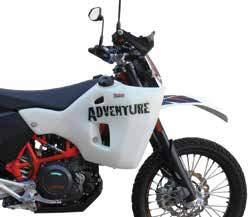


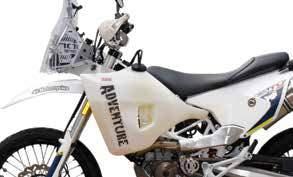


spuds, carrots and onions. It’s like a roast dinner every night, and I think we both put on weight last trip because we were eating so well.
One of the most ingenious and strangest ideas came about when the person in question didn’t have any cooking utensils with him. Not to be deterred, he found an old metal rake at the camp site, sterilised the rake head in the fire, then skewered the fillet on it and cooked it to perfection.
Above: Some riders have their catering well organised. Below: In hot weather food can go into a cooler bag and be kept chilled with some frozen meat.

Of course you have to have snacks.
But adventure desserts are also a thing!
For a huge sugar high you could try a wrap with golden syrup or condensed milk (or a combination of both). Fruitcake seems to keep for ages and travels well.
On our last trip Greg and Ness provided everyone with individual steamed puddings; all we had to do was heat them in boiling water for a little treat.
One trip we did I had a brilliant idea of how to have fresh greens. I got some sprouts going before we left home and had the intention of putting them out in the sun when we stopped along the way. It would appear I miscalculated the impact of some of the tracks (or perhaps just the movement of the bike itself) and ended up with a jar of mush. I’d love to hear if anyone has had success with travelling sprouts.
Then there’s the issue of your rubbish.
Carting a stinking tuna tin in your pannier until you can find a bin is never nice. With tins, we’ll chuck them in the fire after dinner. In the morning, the fire’s
out (or we put it out) and the burnt-out tin is a lot more socially acceptable to take with you. Making sure you’ve always got a sturdy rubbish bag on hand is a good idea too.
Another consideration is putting money back into local communities, particularly those across this wide brown land impacted by droughts or fires or flooding rains. And when there’s such a growing culture of good cafes and pubs, then we’re ‘helping’ lots.
R Sprouts don’t travel
R Chocolate appears to remain reasonably edible after numerous meltings
R Dave’s ANZAC biccies are always a hit
R There will always be that one tin that does at least four trips with you before getting eaten
R Cooking in foil under the stars is the best

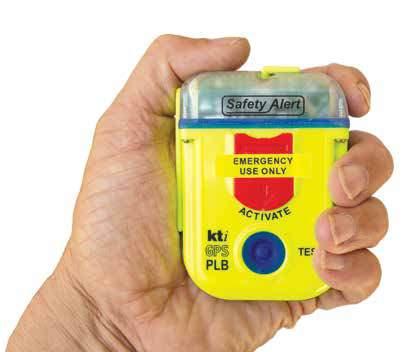

MotoBatt MBtx9u Battery
The battery for the Suzuki DR650! Plus 296 other bikes.
R Absorbed Glass Mat (AGM) technology
R Patented QuadFlex multi-fit terminals
R Fully sealed. Can be mounted and transported in any position
R No initial charging. Install and go, charged right out of the box
R Maintenance-free
R Up to 20 per cent more cold cranking amps (CCA) over a standard battery
R Available via courier delivery as they contain no liquid acid
RRP: $97
Available from: Your local motorcyclestore or online from whitesmoto.com.au/products/mbtx9u Web: whitesmoto.com.au
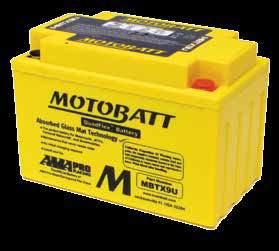



Adventure Rider Magazine is using one of these!
R Durable, welded, fuel-grade bladder
R Ballistic-nylon sleeve with webbing daisy-chain anchor points and handles
R Available in eight-litre and five-litre sizes
R Supplied with a screw-on EZ Pour spout
R Can be easily attached to a tail rack or mounted on a tail pack or pannier using adjustable ROK Pak Straps
RRP: From $129 – $149
Available from: AdventureMoto Web: adventuremoto.com.au

An adventure-ready jacket with reinforced shoulder and elbows and heaps of protection.
R 600D H/D construction
R Dual liner system (detachable waterproof and thermal liners)
R Fold-open clip-air system
R Safety reflectives
R Jacket/pants zip
R Fleece-lined hand-warmer pockets (plus large front pockets)
R Rear jacket pocket
R Available in sizes S – 5XL
RRP: $299.95
Available from: Moto National Accessories Web: motodry.motonational.com.au
An ergonomic padded back with directional airflow for a comfortable, all-day hydration pack.
R Anti-sloshing hydration-bladder compartment with hook-and-loop secure strap
R Top-fill closure and anti-slosh stabilising handle
R Insulated cooler fabric lining
R Large front compartment
R Upper zippered felt-lined electronics pocket
R Expandable front storage pocket
R Dual compression straps
R Two expandable side mesh pockets for quick access storage
RRP: $169.95
Available from: All good motorcycle retailers Web: cassons.com.au

andy strapZ inna paKZ
A two-part, zippered and hinged pack.
R Keep things in order and ready for the end of the day
R Made of tough nylon fabric with a waterproof bonded backing
R One half covered with clear PVC and the other with mesh
R Each half has a capacity of about four litres
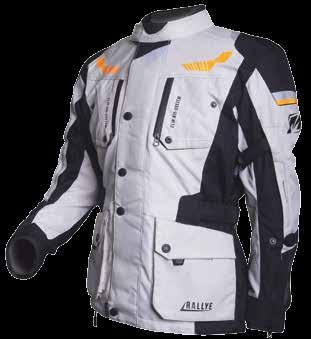
R Ideal for moving clean gear to dirty, or dry to damp, as each day progresses
R Slips in and out of panniers or rack bags easily
R Hangs from clothes hooks in bathrooms or hotel rooms
R The two halves close with velcro strips
RRP: $45 plus postage
Available from: Andy Strapz Phone: (03) 9786 3445
Bajaworx rally windscreen for drZ/Klr Gen 2
Fits right against the cowling and directs the wind around the rider.
R Available in clear and a mild tint for the DR/DRZ and clear for the KLR
R Moulded using durable, lightweight, 3.5mm polycarbonate
R High-impact strength and shatter-resistant
R Superior light-transmission quality
R Mounts quickly and easily
R Made in the USA
RRP: From $139.95
Available from: Adventure Bike Australia Web: adventurebikeaustralia.com.au
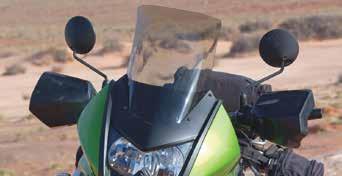
roxspeed fx ’Bar risers
Make your machine fit you, not the other way around.

Email: info@andystrapz.com Web: andystrapz.com
R Full range of adjustment allows the rider to find their own individual ’bar position.
R Pivots backward or forward based on rider preference
R Lifetime warranty
R Made in the USA
R Fitment chart available on the website to find the model that fits your bike
RRP: $159
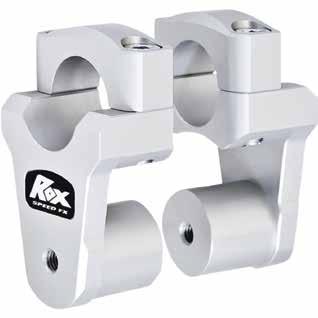
Available from: Motorcycle Adventure Products Web: motorcycleadventure.com.au u
proGrip 737
From ‘the race passion’ company.
R Soft compound rally grips
R Ultra rubber to avoid blisters on long endurance rides
R Available in black
RRP: $19.95
Find your nearest dealer: jtr.com.au contact-dealers Web: jtr.com.au

Basic, lightweight, motocross-style boots designed and manufactured in Europe.
R 12 months warranty
R CE-level protection
R FCS pivot design
R Folding Pro alloy buckle
R Enduro anti-slip lug sole
R Leather and synthetic
R Injection-moulded protection
R Mid-sole with steel shank
R Suspension link kit to lower the riding position
R Provides easier ground access
R Lowers riding position by 18mm
R Combine with the Low Seat, sold separately, for an additional 20mm height reduction
R Perfect for shorter riders
RRP: $162.70
Available from: ShopYamaha or your local Yamaha Dealership Web: shop.yamaha-motor.com.au


RRP: $434.95
Available from: www.formaboots.com.au
2020 BMw r1250G Gsa radiator-G
The essential aftermarket part for the hardcore adventure rider.
R Easy to fit
R Lightweight and does not restrict air flow
R Made from 6060 T1 –T5 aluminium
R Available in black and polished alloy
R Three-year worldwide warranty
R Australian made
R Video fitting instructions available
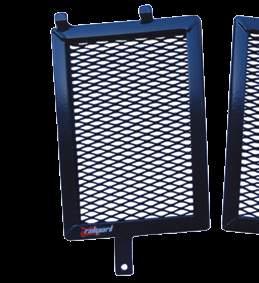
aKrapovic titaniuM slip-on Muffler for the ténéré 700
Creates an exciting and unmistakable sound.
R Weighs 2.3kg less than OE exhaust
R Pairs perfectly with optional header, sold separately
R Carbon-fibre heat shield and muffler clamp
R Exclusive Ténéré 700 logo decal
RRP: $259. On special for $184
Available from: Rad Guard Phone: (02) 6658 0060 Web: radguard.com.au
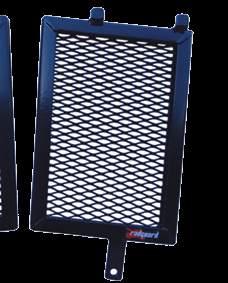
RRP: $1149
Available from: ShopYamaha or your local Yamaha dealership Web: shop.yamaha-motor.com.au
The editor’s first choice for a hot ride.
R Shell construction utilises a multi-composite combination of layers

R Combination of layers is given better performance with an epoxy-resin bonding
R Patented system allows the helmet to be tuned to the rider’s preference for height and angle
R MIPS is incorporated to reduce rotational motion energies
R Side cheek padding can be extracted efficiently and safely while the helmet is still on the rider’s head
R Weight of SM8 is 1300g for medium size
R ECE approved
R Sizes: XS – 2XL
RRP: $649.95
Available from: All motorcycle stores Web: monzaimports.com.au
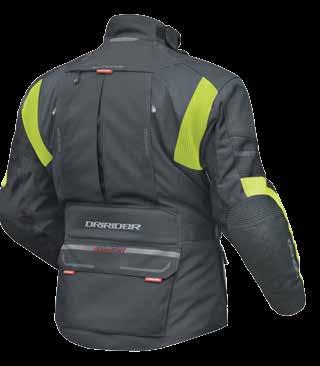
A three-layer system configures the jacket to suit any weather.

Polyester 900D outer shell with 1200D on shoulders and elbows, PU-coated
CE armour with high-density foam back pad
Removable waterproof/breathable liner (15,000mm/7000mm)
Removable 150g thermal quilted liner
Mesh comfort liner
Large chest air vents, arm vents and rear exhaust vents
Detachable throat coat
Waist connection zip for pants, three-quarter and short
RRP: $499.95
Available from: Your local motorcycle dealer Dealer enquiries phone: McLeod Accessories 1300 300 191

u
rev’it! offtracK jacKet
Ideal for hot-weather adventure touring.
R Polyester, dull 450D, 3D air mesh and polyester 600D, PWR/shell mesh outer shell
R Detachable thermal liner
R Detachable Hydratex/mesh G-liner
R Seeflex CE Level-2 protection
R Pocket for optional divided chest protector (sold separately)
R Pocket for optional Seesoft CE level-2 Type RV back protector (sold separately)
RRP: $599
Available from: REV’IT! Australia
Web: revitaustralia.com.au
Fits almost any dirt, dual-purpose or adventure bike, no matter if the tank is curved or flat.
R Low profile
R Waterproof map pocket (20cm x 15cm)
R Red lining for high visibility
R Waterproof cable ducts to main compartment and map pocket
R One zipper and one mesh pocket under cover
R Easy fastening, quick removal
R Quick access for refuelling
R No flapping straps
R Washable and easy to clean
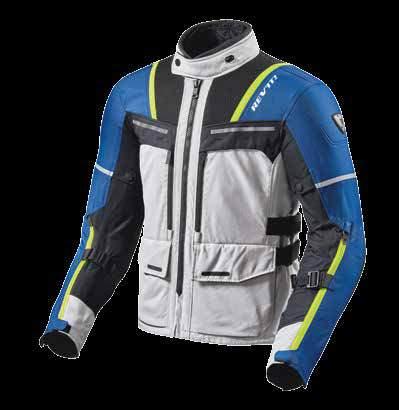
Comprehensive LED light kit specifically designed for powersports applications.
R High-intensity series Cree LEDs outputting 2190 lumens per kit
R DataDim equipped light pods and harness
R Premium powersports harness with waterproof switch and handlebar switch mount included
R Plug-and-play installation. No wire cutting or splicing required
R DrySeal submersible waterproof light and switch housings
R Impact PC polycarbonate bezels
R LiveActive thermal management keeps the LEDs cool
R Low-profile mounting bracket with stainless-steel hardware included
touratech dual usB socKet
Connects to your battery and can be attached to the handlebars using the sturdy bracket or built into the bike’s dashboard.
R New discharge protector and short-circuit fuse
R Installation depth (inside) 45mm
R Diameter (inside) 28mm
R Battery connecting cable 170cm
R Waterproof protective cap (IPX6)
R Blue indicator light (when voltage present)
R Input: 12V-24V DC
R Output: 5V DC, 2A
RRP: $68.24
RRP: $179
Available from: Motorcycle Adventure Products
Web: www.motorcycleadventure.com.au

Zac speed octane tech vest
Designed to offer an increase in storage for extra gear required on the fly.
R 1680D poly-fabric construction
R YBS water-resistant zips with rubberised all-weather pulls
R EVA Nitrile removeable foam inserts
R CONFIGR8 compatible
R Six storage pockets
R Vented, padded liner
R External, Molle-style webbing slots
R Quad-load harness system
R Weight 0.95kg
RRP: $129.95
Email: Info@zacspeed.com
Available from: www.zacspeed.com.au
Web: zacspeed.com.au

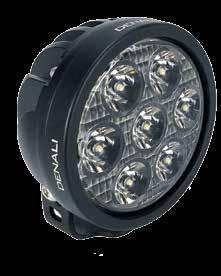

Available from: shop.touratech.com.au
Ground-breaking technology in the motorcycle footwear market.
R Breathes through the soles as well as through its abrasion-resistant cordura fabric upper
R Full sock Goretex liner
R High-grip sole with multiple, cast-in ventilation holes
R Lining is completely waterproof yet offers amazing levels of breathability
R Perfect for hot conditions, touring and adventure touring
R CE-certified
R Available in sizes 40-48
RRP: $449
Available from: Selected stockists Web: tcxboots.com.au

Web: touratech.com.au u
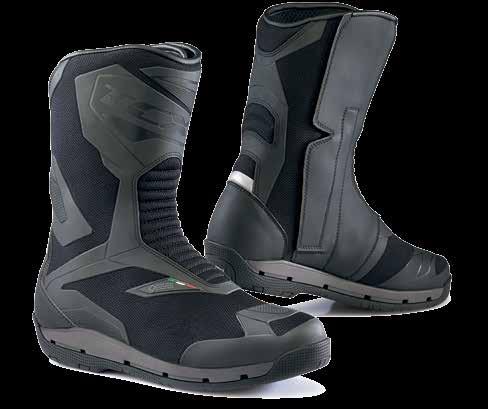
atG (all terrain Gear)
collapsiBle Grill
Cook anywhere you can light a fire.
R Made in South Africa from 304 surgical stainless steel
R Precision design
R True multifunctionality
R Waterproof grid bag
R Limited lifetime warranty
R 34.5cm x 21cm with 3mm DIA 304 stainless wire
R Aluminium pole: 65cm
R Weight: 700grams
RRP: $84.95
Available from: AdventureMoto Web: adventuremoto.com.au

daytona arrow sport Gtx short Boots
A sporty, short boot which is light and comfortable.
R Waterproof and breathable Goretex climate membrane
R Textile lining (80% polyamide, 20% polyester)
R Plastic-reinforced inner sole with hot-galvanised steel shank
R Anatomically shaped ventilated insole (forefoot thickness two millimetre.)
R Rubber sole with sporty profile
R Two side zippers for comfortable step-in
R Ankle protection on both sides, padded inside with opencell special foam
R Sizes 36 to 49
RRP: $499
Available from: Made in
Pty Ltd
(02) 8004 6083
daytona.de

dainese d-explorer 2 Goretex jacKet
A two-in-one with removable Goretex 45mm insulated jacket that can be used separately.
R Anti-floating sleeve adjustment
R Elasticated inserts
R Jacket-pants fastening system
R Neck adjustment
R Quick-fit zip sleeves adjustments
R Sleeves adjustment
R Waist adjustment
R Wrist adjustment
RRP: $1199.95

Available from: All good motorcycle retailers Web: cassons.com.au

dalBy Moto KtM790 adventure
s and r pannier racKs
Tough gear from Dalby Moto.
R Built low and forward of the rear axle
R Complements bikes’ low fuel-tank design
R Premium lightweight riding feel
R Pannier racks for all other popular KTM, Honda and Yamaha models are available
RRP: $435 plus postage
Available from: Dalby Moto Web: dalbymoto.com.au
MotopluG Mount for wireless charGeaBle phones
Holds and charges a ‘wireless chargeable phone’.
R Attach the mount to a round handlebar with a diameter of 22mm to 32mm
R Connect the mount to the bike’s battery, red to positive (+), black to negative (-)
R There is an ON/OFF switch on the back of the holder. When not charging a phone, switch the charger off
R Supplied with an option to mount on a mirror base
R Certified EN 60 529/IP66 (rating for protection against dust and high-pressure water jets)
R Not all phones can be charged wirelessly. Please check your phone can be charged wirelessly before purchasing
RRP: $69.95 plus postage and handling
Available from: Rocky Creek Designs and all good motorcycle stores through Pro Accessories Web: rockycreekdesigns.com.au
aGv ax9 Matt carBon helMet
Lightness, comfort and adaptability.
R Shell in carbon-aramidic-fiberglass in three shell sizes with four-density EPS structure in four sizes
R Integrated ventilation system
R Chin-guard vent removable without tools
R An embracing, pressure-free fit
R All parts are easily removable and washable
R Shalimar and Nabuk fabric neck roll
R Ritmo fabric cheek pads
R Shalimar crown pad
RRP: $899
Available from: All leading motorcycle dealerships Web: agvhelmets.com.au
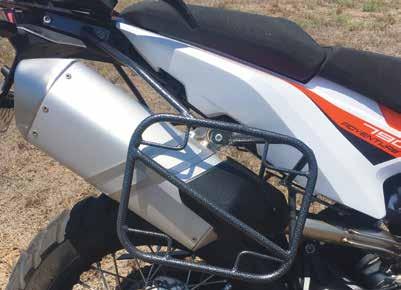
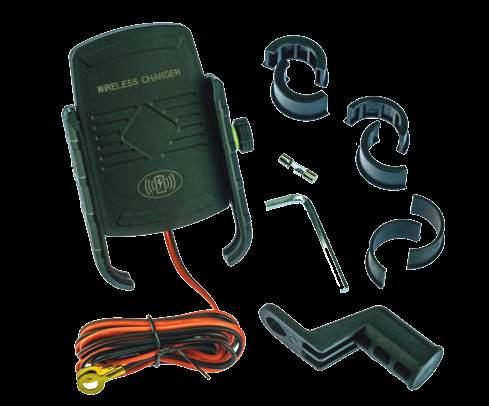
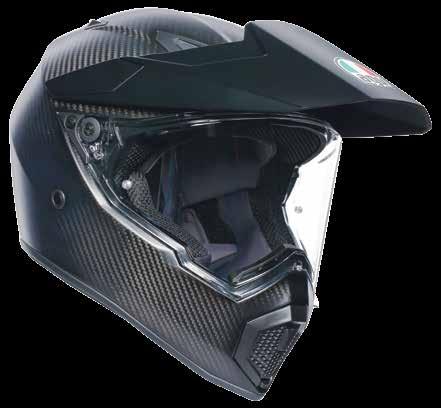


No matter where your journey takes you, make sure you have Rotopax on board for your fuel and water supplies. The Rotopax 3 layer manufacturing process eliminates vapor permeation and creates the toughest fuel pack available. NO LEAKING, NO COLOUR FADING.
Cells can be carried inside panniers, strapped to a rack or fitted with Rotopax’s specific mounts, which also allow for cells to be mounted on top of each other.
Fuel cells are available from 3.7 to 15.1 litres and water cells from 3.7 to 7.5 litres.
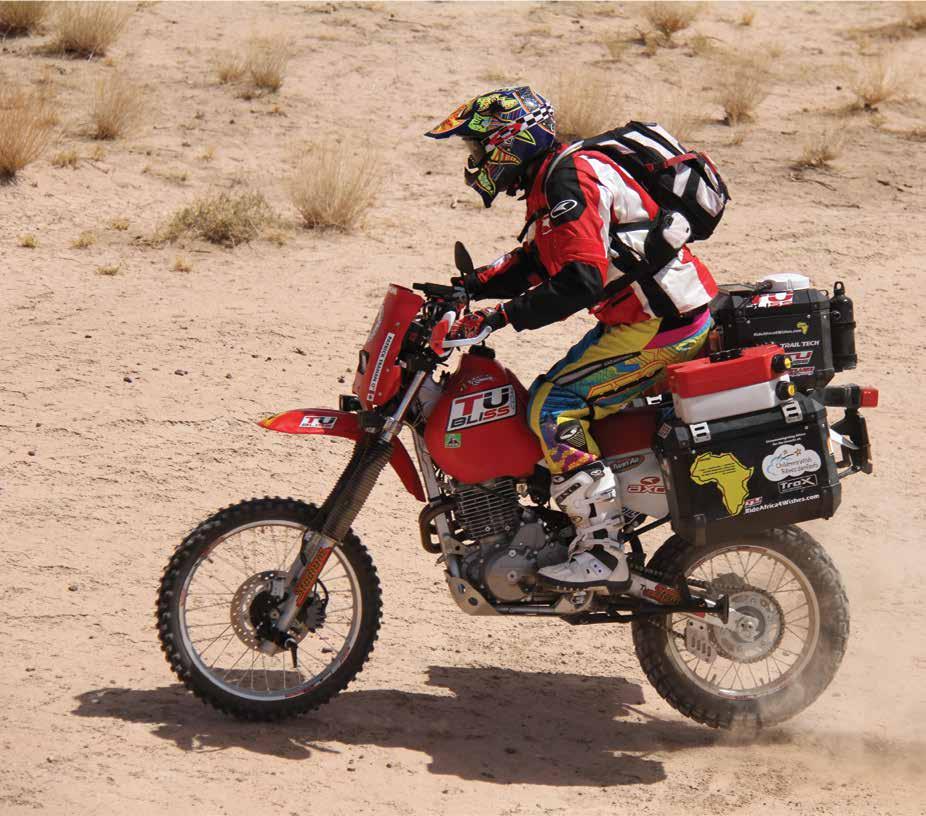
All purchases from Motorrad Garage valued at $75 or more made between 1st - 31st December 2019 come with a free SW-Motech Neck Buff and Motorrad Garage Stubby Holder while stocks last.



